
- Best Hikes In The World
- Appalachian Trail
- European Hikes
- Nepal Hikes
- Patagonia Hikes
- See All Hikes
- Mount Kenya
- Mount Kilimanjaro
- Mount Toubkal
- See All Mountains
- South Africa
- New Zealand
- Switzerland
- United Kingdom
- Packing Lists

Climbing Mount Kenya – Complete Guide (With Check List)
Africa , Climbs & Mountaineering , Kenya , Mountains

Mount Kenya is the second highest mountain in Africa and offers breath-taking hikes suitable for adventurers with a range of abilities. When climbing Mount Kenya, preparation is the key to your success.
Below we have provided a summary of useful information that you will want to read before you go. These are our most frequently asked questions about climbing Mount Kenya.
Climbing Mount Kenya
Located in equatorial Africa, Mount Kenya boasts the second highest point on the continent and stands at an impressive 5,199m (17,057ft) tall. The main peaks rise from about the 4,500m mark to the summit of Batian (5199m), Nelion (5188m) and Lenana (4985m) amongst others.
This natural wonder is often overlooked by potential travellers in favour of the taller African alternative, Mount Kilimanjaro . However, many experienced hikers report that they preferred Mount Kenya because of the thriving wildlife and idyllic mountain lakes it has to offer.
It is also much more off-the-beaten path. With snow-covered peaks and panoramic views of its forested slopes and the surrounding African planes, hiking Mount Kenya promises the adventure of a lifetime.
Hikers can expect to pass through distinctive zones characterized by a variety of vegetation. Gentle farmlands give way to dense rain forest which is populated by camphors and several species of monkeys, buffalo, elephant and even leopard.
As hikers ascend, they will encounter a belt of natural, homogenous bamboo followed by a region of low-lying shrubbery. Finally, the altitude becomes inhabitable for flora and fauna, yielding a barren moonscape of jagged rock and ice. These eroded, volcanic slopes are 3 million years old, and present a challenging and awe-inspiring final push.
Choosing the right path is essential to a successful hiking experience, and the different peaks of Mount Kenya provide options suited for the casual fit trekker as well as for advanced technical climbers. Of the highest peaks, point Lenana alone can be reached without technical climbing experience, but there are numerous routes to get to this point. From the base to summit generally takes from three to five days.
To help you make the right choice of route, and to help you prepare for this unique journey, we have compiled a comprehensive overview of all you need to make this experience the best it can be.
Join a Mt Kenya Hike
Book with our recommended local guide
Mount Kenya Routes
There are 8 main trekking routes on Mount Kenya, all of which summit the lowest peak, Point Lenana at 4,985 metres (16,355 ft). The majority of the 15,000 annual visitors to the mountain go on to summit the lower peak, but for those with technical climbing skills, the second peak Nelion and highest point Batian, are there for the taking too.
Hikers usually choose different routes for their ascent and descents, the most common combinations being the Sirimon-Chogoria (six or seven days) and the Sirimon-Naro Moru (five days) options.
These lesser-used routes require special permission from the Kenya Wildlife Service : the Burguret Route, the Timau Route, the Meru Route and the Kamweti Route.
Below is a summary of the most popular routes to point Lenana, the highest point that can be reached without advanced rock-climbing.
Naro Moru Route (4 days)
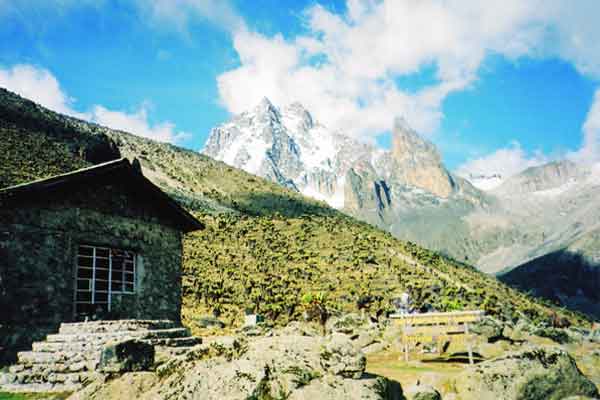
This is the most popular and fastest route to Point Lenana, but can often be overcrowded with hikers. It also does not pass through some of the more scenic regions of the mountain.
The ascent generally takes only three days and there are bunkhouses available along the route for overnight accommodation.
The terrain is mostly manageable, but it includes the “Vertical bog”, a steep and challenging marshy area. Otherwise, this route passes through the wide Teleki Valley with a striking view of the Tyndall glacier.
Ascent on the Naro Moru route:
- Day 1 *: Nairobi to Met Station ( 3 to 4 hours)
- Day 2 : Met Station to MacKinder’s Camp (5 to 6 hours)
- Day 3 : MacKinder’s Camp to Point Lenana and descent to Met Station (8 to 10 hours)
* One day at Naro Moru River Lodge, or another base camp is recommended for acclimatization
Chogoria Route (5 days)
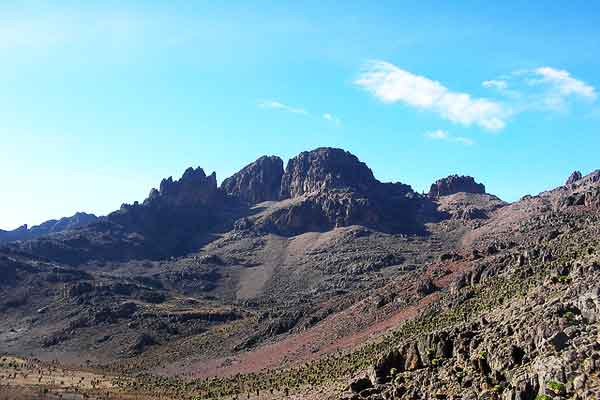
Photo by Joxean Koret
This is perhaps the most scenically beautiful of the routes featured on this guide to climbing Mount Kenya. It is, however, the longest, requiring approximately four days from bottom to top. The trail starts from Chogoria town. It includes spectacular views of Lake Michaelson from a sheer cliff known as the “Temple”, as well as a long walk along the Gorges Valley.
Sirimon Route (4/5 days)
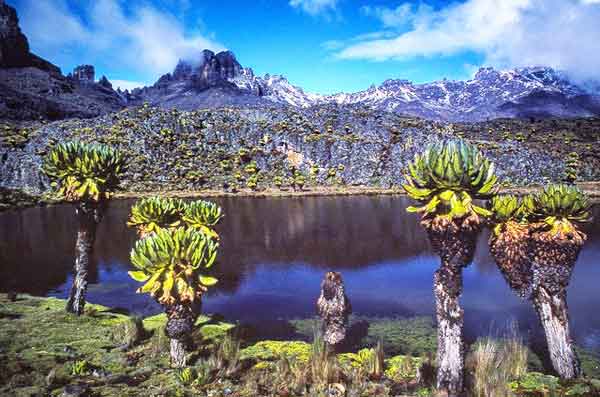
Photo by Ray in Manila
This is definitely the most off-the-beaten path and physically manageable route on the northern side of the central peaks and takes three to four days from base to summit.
It is the driest region, avoiding much of the rainfall which falls on the mountain experience. Nevertheless, drinking water is ample and there is always enough to refill bottles.
The route passes through unique, wildlife-filled, yellowwood forests which give way directly to moorland – the bamboo forest is not present on this part of the mountain.
Typical Itinerary for casual hiking to Point Lenana – Sirimon via Chogoria traverse:
This is a typical itinerary for the combination of the two most scenic routes, Sirimon via Chogoria , and includes one mandatory camping night.
- Day 0 (Optional): Arrival from Nairobi, day at Base lodge
- Day 1 : Arrival from Nairobi, enter through Sirimon Park gate. Hike through forest and bamboo (3 – 4 hours) and arrive for overnight at Old Moses Hut
- Day 2 : (May be split into 2 days of hiking): Long trek through moorlands to the base of the peaks (7 hours). Sleep in Shipton’s Hut.
- Day 3 : Early morning attempt to summit Point Lenana to watch the sunrise. Descent to Minto’s camp and spend the day resting and exploring the Gorges Valley. Sleep in Minto’s campsite
- Day 4 : Gentle descent on the left bank of the Gorges Valley to Meru Mount Kenya Lodge (5 -6 hours)
- Day 5 : Walk through the Chogoria Forest to base, where vehicle transfers back to Nairobi or Base Lodge
Hikers usually choose different routes for their ascent and descents, the most common combinations being the Sirimon-Chogoria (6 or 7 days) and the Sirimon-Naro Moru (5 days) options. This allows hikers to see much more of the mountain.
Burguret Route (7 days)

Photo by Ryan G
If you are looking for a more challenging, wild trek, this option might be for you.
Because the Burguret route has only recently been reclaimed from the surrounding forest, the paths are very overgrown and other hikers are few and far between.
The Chogoria route can then be followed down the mountain.
These lesser-used routes for climbing Mount Kenya require special permission from the Kenya Wildlife Service. Check with your tour operator if the fees are included in your quote:
- Burguret Route
- Timau Route the Meru Route
- Kamweti Route
Advanced Technical Mt Kenya Climbing - Routes
Batian and Nelion are the highest peaks on Mount Kenya and are known to be some of the best technical climbing alpine peaks in the world. There are approximately 35 recorded technical climbing routes on Mount Kenya– this guide will focus on some of the most frequently used, guided technical climbing routes.
Normal route – South Ridge to Nelion
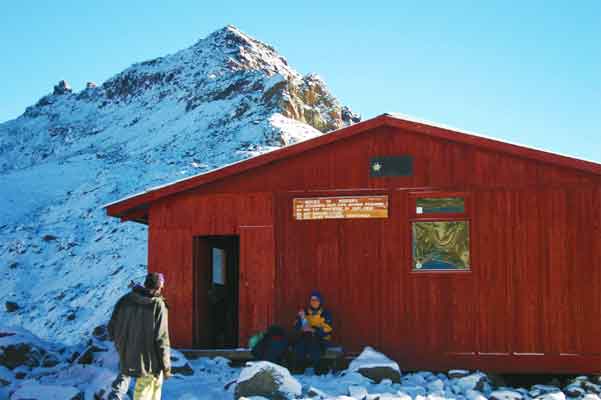
This route is situated on the southern side of Mt Kenya, accessed from the Austrian hut. The hike requires 8 hours of climbing, 18 pitches, 1 overnight camp and a 3-hour descent. Before dawn, the Lewis Glacier is crossed using head torches until you reach the base of the climb.
Once the sun rises, the views become increasingly impressive as you pass the “1-o’clock gully”, “The Amphitheatre” and “De Graf’s Variation” which present areas with a variety of technical difficulty. Nelion is generally summited in about 7 hours and ambitious climbers can extend their expedition by staying overnight in the Howell Hut and then crossing over to Batian via the “Gates of Mist”.
This is option takes an additional 3-4 hours and is dependent on the ice levels in the Gates of Mist. Otherwise, the descent can commence first thing in the morning after a stay over in the Howell Hut.
Typical itinerary for the Normal route to Nelion.
Naro Moru town to National Park Gate and hike to Met Station
Hike from Met Station to MacKinder’s Hut
Hike from MacKinder’s Hut to Shipton’s Hut via Tyndall Glacier and Hausberg Col
Hike from Shipton’s Hut to Point Lenana and back to Austrian Hut
Climb from Austrian Hut up Nelion Peak and back down again
Insurance day (in case of bad weather)
Hike from Austrian Hut to Nithi Falls via Lake Ellis
Hike from Nithi Falls to Meru Bandas for transfer out to Chogoria
North Face Standard Route – North Face to Batian
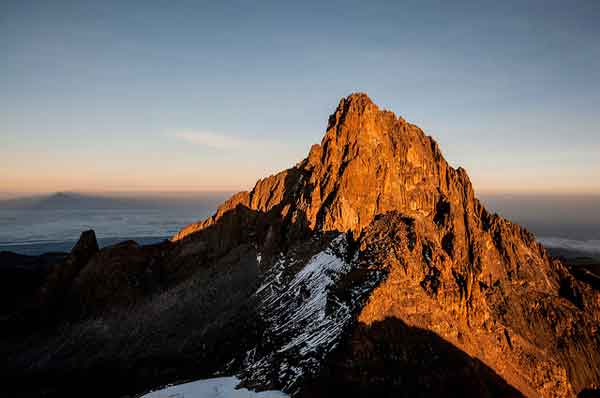
Photo by Francesco Tonnarelli
This advanced climbing route is the most direct to the highest point of Mount Kenya and traverses the northern side of the massif.
This route is more challenging that the “normal” alternative, and requires about 12 hours of climbing, an overnight camp, followed by 5 hours of descent. The climb to the summit normally starts from bivy at the Amphitheatre.
Typical Itinerary for the North Face Route.
Naro Moru town to the National Park Gate. Hike to Met Station via the Naro Moru route
Hike from MacKinder’s Hut to Shipton’s Camp via Hausberg Col
Hike from Shipton’s up to Point Lenana and back
Early climb up Batian and return to Shipton’s
Hike from Shipton’s Camp to Sirimon Park Gate and on to Naro Moru town
When is the Best Time To Climb Mount Kenya?
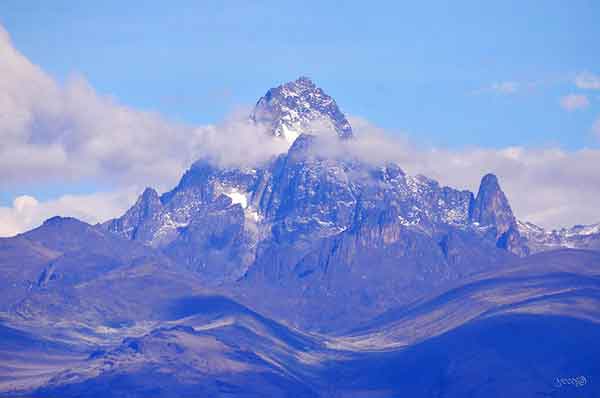
Photo by Yochi23
The best time for climbing Mount Kenya depends on whether you prefer solitude or clear weather.
The rainy seasons are typically between March and May and from October to December, and so the most popular months to hike Mount Kenya are January, February, August and September.
Technical climbing routes depend more on the annual weather conditions than the casual hiking routes do, and so more specific information on the climbing route you have chosen should be used to decide on the time of your visit.
The “Normal route” on the South Ridge to Nelion should be undertaken between December and March, while the “North face Standard route” to Batian is best attempted in July, August and September.
The temperatures on Mount Kenya are relatively constant throughout the year, but change significantly upon ascent, with day temperatures ranging from 15°C to 5°C and night temperatures dropping well below freezing.
Check out our hiking gear list to make sure you are well prepared for whichever conditions are thrown your way.
How Difficult Is The Mount Kenya Climb?
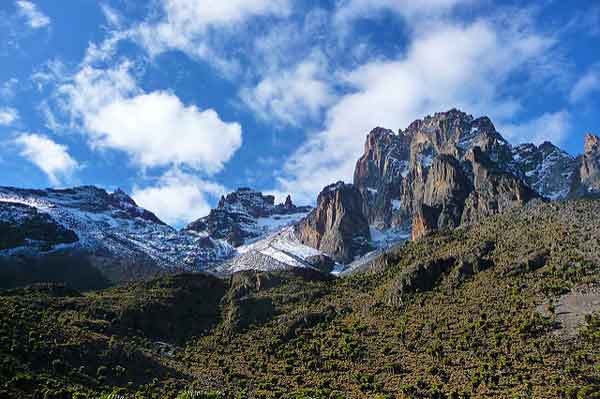
Photo by Yoann Maldonado
The most technically challenging sections of the hiking route to Point Lenana generally only requires a bit of scrambling over snow and ice.
The greatest challenge to trekkers is usually not the physical exertion but the effects of thinning air which are evident above the 3000m mark.
The difficulty of the technical climbs varies, but significant prior climbing experience is essential for all climbing options. Even though you will be accompanied by qualified guides, experience of outdoor multi-pitch climbing is necessary, as well as with leading long runouts, long abseils and applying safety procedures.
The summit of Nelion is reached after one, protracted day of climbing and a series of about 18 pitches, and while the climb is not highly graded technically (between scramble and UIAA IV +, averaging at around UIAA II). The climb up Batian Peak also requires a full day of climbing, and a series of up to 21 pitches. These range from low grade scramble to grade UIAA IV+, averaging around UIAA II.
Apart from the technical grade, there are other considerations which affect the difficulty and safety of the advanced climbs.
Firstly, their significant length demands physical stamina as well as mental concentration over up to 11 hours.
Secondly, while most guided tours facilitate sufficient acclimatization, the altitude of the climbs compound the fatigue experienced by climbers.
Potential tricky weather conditions (which can be mitigated by choosing to hike at the best time of year for the chosen route, and including a “weather day” for insurance), as well as the lack of sophisticated rescue facilities which would be expected in the European Alps , for example are also factors which must be taken into account when determining the difficulty of the trek-climb combination.
Is Altitude Sickness a Risk on Mount Kenya Climb?
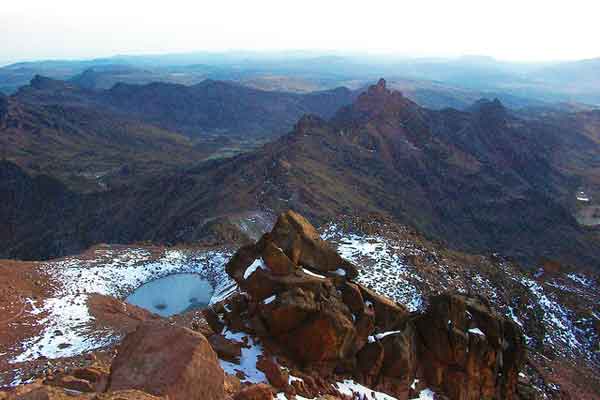
Altitude sickness (or Acute Mountain Sickness (AMS)) is the main obstacle hikers face in reaching the summit.
Head-aches and nausea are its common effects and are experienced by most hikers beyond 3000m. To mitigate these symptoms, it is recommended that hikers drink 3-4 litres of water per day, and acclimatize properly to the thin air.
Before hiking Mount Kenya, it is essential that hikers are fully informed on the risks, symptoms and treatments available for AMS as well as for high altitude pulmonary edema (HAPE) and high altitude cerebral edema (HACE), which are life-threatening if left untreated.
Read our guide on altitude sickness here .
What Gear do I need for Mount Kenya? (Packing List)
To help you prepare for your African expedition, have a look at a brief gear check list below.
Thankfully the list is very similar to our Kilimanjaro Packing List , which you are welcome to use for your preparation.
This list is suited for the casual trek only – technical climbing equipment should be sought with the help of your experienced guide and depends on the route you have chosen to climb.
To choose the best gear available today, check out our detailed Gear Reviews & Ranking .
- 2 × long/short sleeve shirts (moisture-wicking fabric)
- Warm fleece top
- Soft shell jacket/Hard shell, waterproof jacket (breathable hood)/ Down jacket (insulated)
- Thermal base later (long johns and vests, moisture-wicking fabric)/Lightweight poncho
- Waterproof trousers (side zipper recommended)/Hiking trousers/Fleece trousers (for evenings at camp)/Shorts
- 6 × underwear (moisture-wicking fabric)
- Brimmed hat/Knitted beanie/Balaclava or buff
- 2 × gloves/mittens (a warm & a thin, windproof)
- Hiking boots (waterproof, warm, broken-in)/ Sandals for campsite
- 4 × pairs of thick wool hiking socks/Thick socks reserved for night times
Gear & Paperwork
- Warm sleeping bag (comfort -5° or lower)
- Sleeping mat (e.g. Therm-A-Rest, check if provided)
- Rucksack (usually carried by porters, 65L - 90L)
- Day bag (for personal carriage and use, 35L - 45L)
- Duffle bag (to leave unneeded items at the base lodge, 80L - 100L)
- Sunglasses (with UV protection)
- 2 × water bottles (Nalgene, 1L), or 1 × Water bladder (Camelback, 3L)
- Pee bottle (1.5L, to avoid having to leave tent at night)
- Collapsible trekking poles
- Head lamp with extra batteries
- A few plastic bags to keep gear dry
- Passport/3 × photocopies of passport/Student card (optional)
- Flight details
- Insurance policy details (see below)
- Yellow fever certificate
- Cash (for tips) and bank cards
Toiletries, First Aid & Other Items
- Facecloth/Travel towel (quick dry)/Wet wipes
- Soap/Hand sanitiser
- Sunscreen (SPF 30+)
- Toilet paper
- Toothbrush & toothpaste
- Insect repellent
- First aid kit
- Anti-malaria tablets
- Pain killers (Ibuprofen and Paracetamol)
- Zinc oxide tape and small scissors
- Pack of blister pads
- Loperamide / Immodium diarrhea tablets
- Pack of Dioralyte sachets (or similar rehydration packs)/Electrolytes, powder or tablets (optional)
- Pack of throat lozenges
- Pack of iodine water purification tablets
- Prescription medication
- Waterproof wallet
How Much Does Mount Kenya Climb Cost? What Permits Do I need?
The cost of hiking Mount Kenya varies, depending on how long you are planning to spend on the mountain, the time of year you plan on hiking, and the amount of equipment you will need to buy new.
Here is a rough cost break down for your trip up Mount Kenya.
Visa, Vaccinations, Insurance : ~ $400-$550
Equipment (buying and hiring) : ~$200-$500
Return flights to Nairobi : ~$1000 – $2,000
Trek package: $800 – $1,500 This varies by operator with local companies offering cheaper packages. Trek packages generally include transport to and from Nairobi, meals, a professional guide, and accommodation for the hiking nights, and the cost of the park permit.
Tips : $100-$150
Miscellaneous (this includes extra accommodation, additional food, and any unplanned expenses): ~ $300
Total costs : $2,800-$5,000
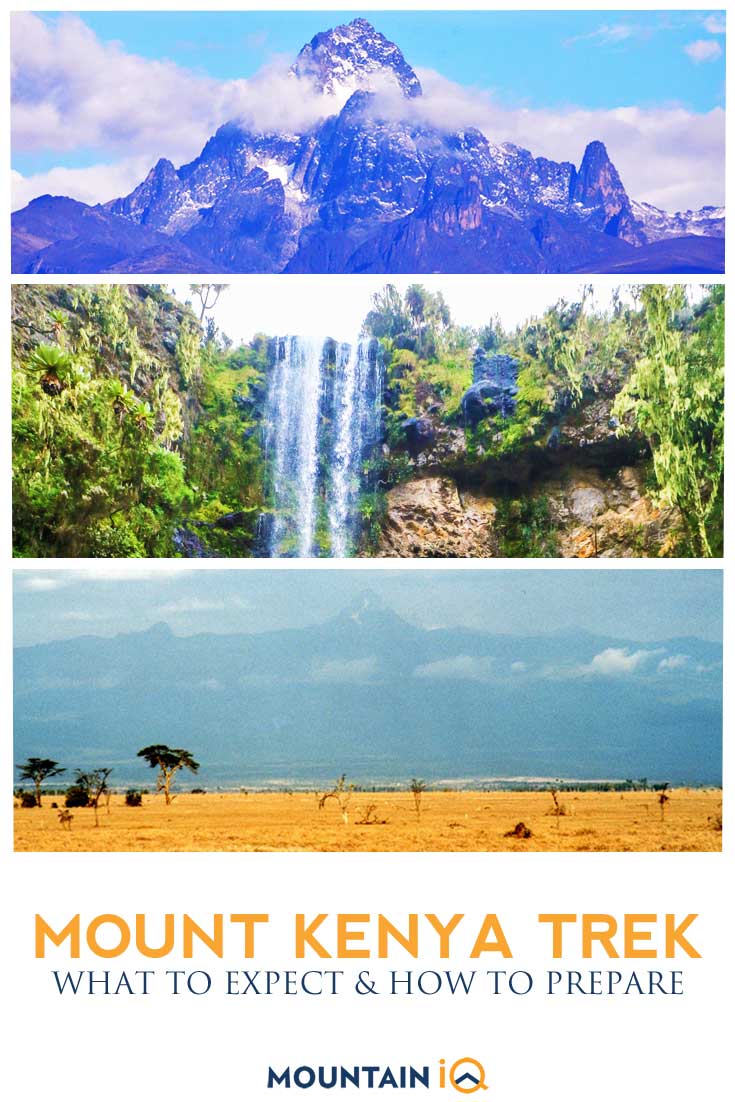
About the author
Mark Whitman
Mark has trekked extensively in Asia, Europe, South America and Africa. He founded Mountain IQ in 2014 with the sole aim to be the best online information portal to some of the most popular mountain destinations around the world. When not writing for Mountain IQ, Mark is out exploring the outdoors with his wife!
Leave a Reply
Your email address will not be published. Required fields are marked
Looking for a trip to climb to Lanana peak Mount Kenya from around the 5th April
Hi Philip, I recommend checking out this trip: https://www.skyhookadventure.com/trips/mt-kenya
Hi I'm looking to climb to the actual summit of Mt Kenya, can you recommend an appropriate guide or tour operator
Hi Chris, I recommend this local operator: https://www.skyhookadventure.com/trips/mt-kenya
We work with local guides to offer great value adventures at unbeatable prices

- Last minute guaranteed trips
- Covid Info Hub
- Info nights & events
- How to book
Mount Kenya Ascent
Summit mount kenya with a chance of wildlife encounters.
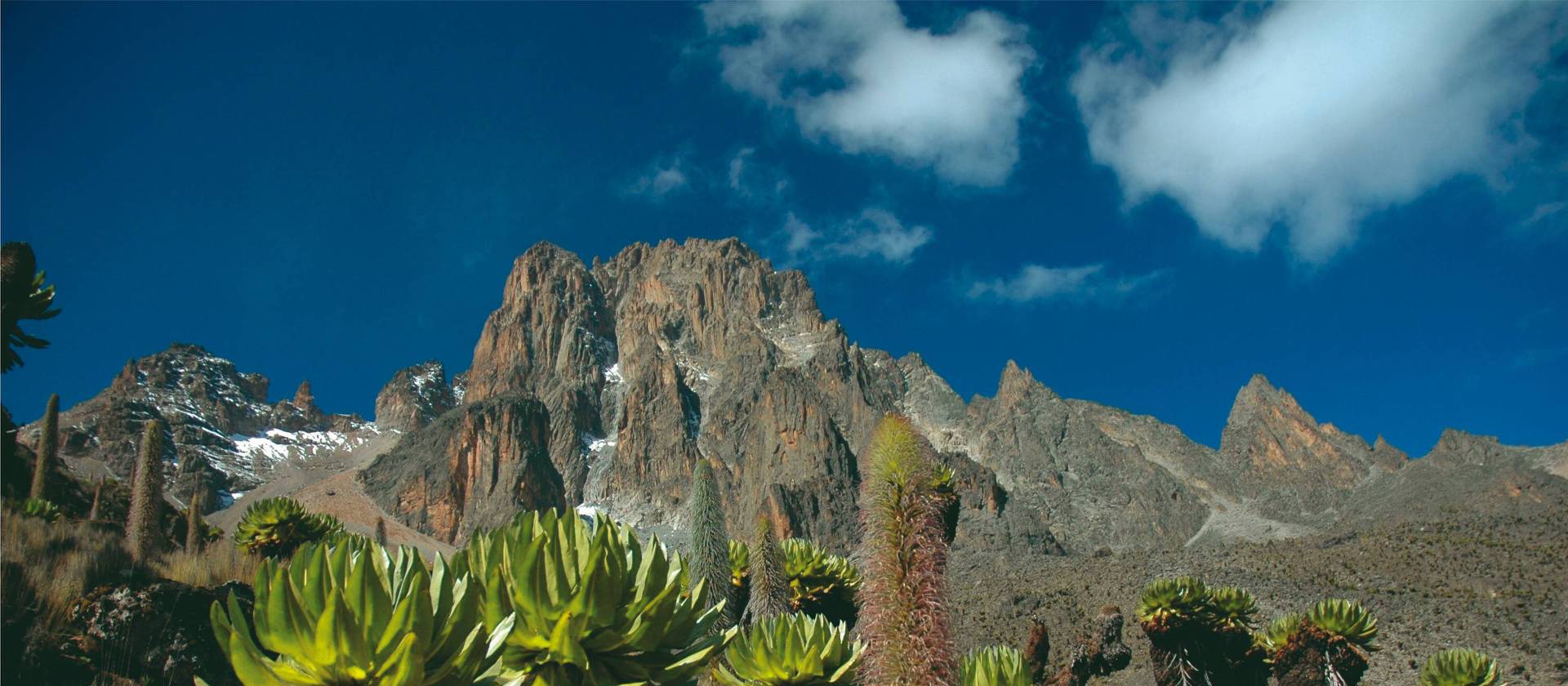
- 1 night hotel
- 5 nights camping/ mountain hut
- 6 Breakfasts
Traveller Rating
Read 4 reviews
Share this trip with a friend
Destination
Antarctica & the arctic, australasia, central america, central asia, indian subcontinent, middle east, north america, south america, vessels & boats, advanced search, thoughtful travel.
- Accommodation
- Bike Information
- Trail Surface
- About your leader
- Departure dates
- Essential information
- Trip reviews
- Related articles
- Similar trips
- Suggested extensions
Share this trip
Mt Kenya Trek Trip highlights
- Climb Point Lenana (4985m), the highest trekking peak on Mt Kenya
- Traverse Mount Kenya from East to West via the Chogoria and Sirimon routes
- Ascend via the quieter and more dramatic Chogoria route
- Delight in the beautiful alpine scenery and views
- Search for wildlife in the lower slopes
Mt Kenya is regarded as the most visually stunning of the ice-capped African peaks and is home to a great diversity of wildlife, including leopard, elephant and buffalo. The ascent is an exhilarating and diverse trek, arguably the finest trek in Kenya, with relatively few hikers compared to Kilimanjaro. Many would argue that Mount Kenya, whilst not being as high as Kili, is certainly the more enjoyable, interesting and dramatic of the two mountains. The Chogoria/Sirimon Route offers the best combination of alpine scenery and acclimatisation as we ascend via spectacular Lake Michaelson and Lake Ellis to the trekking peak of Kenya, at Point Lenana (4985m). Our traverse continues to the north where we descend the stunning Sirimon trail with dramatic views.
Read more...
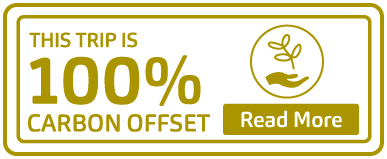
Expand all | Collapse all
Day 1 Join Nairobi
Meals: Nil
Day 2 Drive to Mt Kenya National Park
Meals: B,L,D
Day 3 Ascend Mt Kenya via Lake Ellis (3500m)
Day 4 trek to lake michaelson (4000m), day 5 trek to simba tarn (4560m), day 6 ascend point lenana (4985m), descend via mackinders valley to liki north camp (3900m), day 7 descend sirimon valley to old moses camp (3400m), transfer to nairobi where the trip concludes.
Meals: B,L
The map and elevation chart are for illustrative purposes only and meant to provide general guidelines.
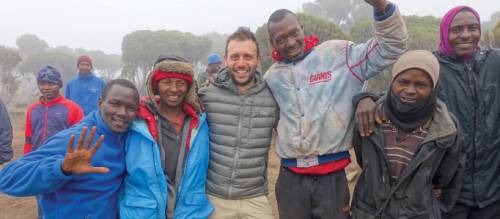
Porter Welfare Policy
Learn how we look after our porters and staff across the world, including Tanzania & Kenya
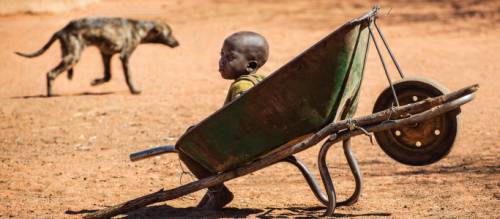
Namibia: Regenerative Travel Project
Provide a nutrient rich diet of vegetables to the school children and community of Purros
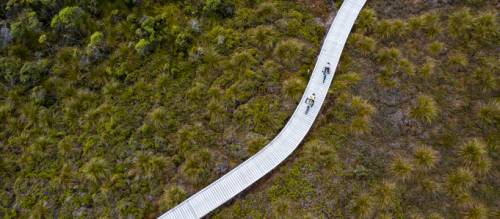
100% Carbon Offset
By booking this trip you are supporting sustainable projects around the world
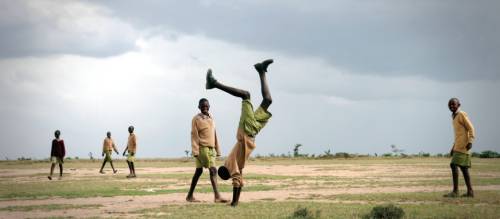
Thoughtful Travel Charter
We are committed to true sustainability by aiming to only leave a small footprint
What's included
- 6 breakfasts, 6 lunches and 5 dinners
- 1 night in 3 star hotel on a twinshare basis
- 5 nights fully supported camping on a twinshare tent basis
- Group camping equipment including tent (sleeping bag and mat not included)
- Experienced local guides, cook and camp crew
- Porters to carry personal and group equipment
- Private return transfers from Nairobi to Mt Kenya
- Park entrance fees valued at US$300
What's not included
- International flights
- arrival and departure transfers
- Sleeping bags & sleeping mats
- Restaurant meals in Nairobi and meals not mentioned in the itinerary as included.
- Bottled water, aerated and alcoholic drinks
- Items of a personal nature such as phone calls, laundry, etc
- Airport and departure taxes
- Travel Insurance
- Additional transport or accommodation required due to any emergency situation. (This would be covered by an adequate insurance)
Per Person, Twin Share
Select your dates and book now
The following errors occured:, mt kenya trek trip reviews.
Rating: ☆ ☆ ☆ ☆ ☆ ☆ ☆ ☆ ☆ ☆ ☆ ☆ ☆ ☆ ☆ ☆ ☆ ☆ ☆ ☆ ☆ ☆ ☆ ☆ ☆ ☆ ☆ ☆ ☆ ☆
Other trip reviews
Why travel with us.
Award Winning Adventures
Enhancing your journey with authentic experiences, genuine cultural exchange and real exploration are the focal points on all of our adventures. In 2019, we were crowned by our peers as the best in adventure travel at The Travel Awards in Sydney.
Our vision is to leave the world a better place by following our sustainable active outdoor travel charter . All our adventures are 100% carbon offset and our Regenerative 2030 Project aims to integrate ‘regenerative’ projects into every one of our global operations by 2030.
Ultimate Value
When you book one of our adventures, you will receive quality services at the best prices with plenty of inclusions. There are no hidden costs, single travellers don’t pay more and you’ll enjoy many ‘extra touches’ that ensure your holiday is excellent value for money.
Related Articles
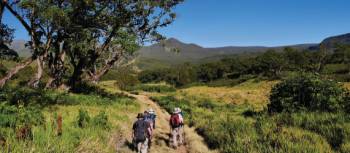
- Cookie Policy
- Strictly Necessary
- Performance
When you visit any web site, it may store or retrieve information on your browser, mostly in the form of cookies. This information might be about you, your preferences, your device or used to make the site work as you expect it to. The information does not usually identify you directly, but it can give you a more personalized web experience. You can choose not to allow some types of cookies. Click on the different category headings to find out more and change our default settings. However, you should know that blocking some types of cookies may impact your experience on the site and the services we are able to offer.
These cookies are necessary for the website to function and cannot be switched off. They are usually only set in response to actions made by you which amount to a request for services, such as setting your privacy preferences, logging in or filling in forms. You can set your browser to block or alert you about these cookies, but some parts of the site will no longer work. These cookies do not store any personally identifiable information.
These cookies allow us to count visits and traffic sources, so we can measure and improve the performance of our site. They help us know which pages are the most and least popular and see how visitors move around the site. All information these cookies collect is aggregated and therefore anonymous. If you do not allow these cookies, we will not know when you have visited our site.
These cookies allow the provision of enhance functionality and personalization, such as videos and live chats. They may be set by us or by third party providers whose services we have added to our pages. If you do not allow these cookies, then some or all of these features may not function properly.
These cookies are set through our site by our advertising partners. They may be used by those companies to build a profile of your interests and show you relevant ads on other sites and promotional activities through our newsletters. They work by uniquely identifying your browser and device. If you do not allow these cookies, you will not experience our targeted advertising across different websites or via newsletters.
Explore 360
Find Your Expedition
- Mountaineering
- Weekend Wonders
- 360 Pyrenees
- Womens Only
- Meet the 360 Team
- Latest News
- Terms and Conditions
- Grading Information
- 360 Blogs & Updates
- Social Media
- Testimonials
Select Expedition
Need inspiration, mount kenya.
4,985m/5,198m
P3 - This trip is physically tough. Frequent exercise is necessary to prepare properly for this expedition. Regular walking mixed with training at the gym to build up endurance and cardiovascular fitness is key. Expect to be able to do 8 hour days in hilly and often steep train, carrying a pack of 6-10kg in weight with the occasional extra long day.
Visit our Grading Information page for a full overview.
T2 - Consider this a trek, although there may be occasion to use hands for short sections of easy scrambling. No previous climbing or trekking experience is necessary.
Date & Prices
Pics & Vids
Mount Kenya may be Africa’s second highest mountain but it’s first for its fascinating variety of flora, fauna and magical landscape. Our expedition takes you to the trekkers ’ summit: Point Lenana (4,985m)– a stunning peak just below the highest peaks of Nelion and Batian which involve a true technical climb.
You also have the option to reach the true summit of Batian Peak on Mount Kenya (5,199m). This involves a long 22-pitch technical climb on summit day.
We trek through equatorial rainforest rich in wildlife, including elephant and waterbuck, across moorlands hiding crystal-clear lakes and above remote gorges where you can relive the excitement felt by the first explorers. We camp by mesmerising lakes fed by waterfalls. On clear days we can see the summit of Kilimanjaro, 200 miles away across the African savannah . Mount Kenya is a collection of sharp. jagged peaks forming a single mountain. Our objective. Point Lenana at 4,985m , is attainable for the fit and adventurous and is a perfect first trekking peak. We ascend at dawn to capture the sunrise over this spiky eerie landscape overlooking glaciers, and as we stand at the high point of our journey, we marvel at what seems like all of Africa falling away below.
The diversity of habitat and wildlife, the absence of other trekkers, and geography akin to the set of Jurassic Park combined with the challenge of the ascent make a climb to Point Lenana an experience never to be forgotten.
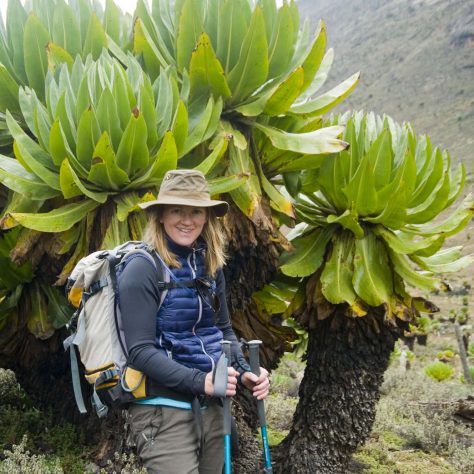
Date & Prices
For private trips or bespoke itineraries inc. different dates, please contact the 360 office on 0207 1834 360 . A monthly payment plan is possible, please contact the office to chat through the options.
Departure & Return
Flight included
Start: 14 March 2025 End: 23 March 2025
Land Only: £2,975 Flight Included: £3,475
Prices TBC mid-2024 Cost based on a group of 5 *If climbing Batian (technical summit) a supplement will apply
14 March 2025
23 March 2025
£2,975
£3,475
Please note that if 360 is booking your international flights, a supplement may be applicable
if the flight budget (as seen above) is exceeded.
- International Flights
- Local guides, 360 guide, porters, cook team and vehicle
- 3 nights hotel accommodation at start and finish of trek near Mount Kenya
- All camping and group equipment
- All meals as described in itinerary, including a celebratory dinner on final night at the traditional restaurant Carnivore
- Discount at Cotswold Outdoor
- Monthly payment plan, on request
Not Included
- Kenyan Visa
- Personal travel insurance
- Personal equipment
- Staff and guide gratuities
- Night in Nairobi on day 9 if there are no night flights back to the UK
- Unscheduled hotels and meals
- Items of a personal nature – laundry, room service
- Airport transfers when not booking on with flights
- Any additional costs associated with leaving the expedition early including any airline surcharges as a result of changing return airline tickets
DAY 1 : Depart UK
Today we depart the UK normally from London Heathrow airport.
DAY 2 : Arrive Nairobi, transfer to Mount Kenya
We land in Nairobi airport and transfer straight to Mount Kenya, a 4-5 hour journey through some amazing scenery to our simple but pleasant hotel. That evening your 360 leader will give a comprehensive briefing on the days ahead.
DAY 3 : Chogoria Gate to Lake Ellis (3,600m)
We are picked up early for the drive to Chogoria Gate a few hours away, our entrance to Mount Kenya national park where me meet our porters and cook. If the roads are good, we will drive through the rainforest and into the bamboo zone all the way up to Chogoria Bandas where our trek starts. We walk through ancient woodlands and climb up into the heath zone, traversing beautiful open moorland to reach a stunning, quiet lake, and our first camp. It’s a good few hours walk to get into the swing of things, and we’ll have the rest of the day to relax, or to explore the environs in search of the rock hyrax that inhabit this area.
DAY 4 : Lake Ellis to The Temple, Lake Michaelson (4,000m)
After breakfast we head out across more moorland through Africa’s unique high altitude plants, giantgroundsel and lobelia before crossing into the mouth of the great Gorges Valley where we find Lake Michaelson and our night’s camp. Set in a vast 400m high amphitheatre, we catch our first glimpse of some of Mount Kenya’s summits and glaciers above us.
DAY 5 : Lake Michaelson to Austrian Hut (4,750m)
We break the 4,000m barrier today as we climb up past the old wreck of an aircraft and up over the ridge surrounding Gorges Valley. Form there we scramble up scree towards Austrian Hut near the Lewis Glacier and our stop for the night before we go for the summit.
DAY 6 : Austrian Hut to Point Lenana (4,985m) down to Mackinder’s Camp
We wake early at Austrian hut, typically around 3am, and make for the summit in time to see the sun rise, bathing glorious light over the breathtaking eastern panorama of Mount Kenya. When we’ve finally taken in the glory of reaching the summit, with the incredible excitement at having completed such a fantastic challenge we’ll begin our descent down to Mackinder’s Camp for a well earned rest.
**For those climbing the technical summit of Batian, climbers will today say goodbye to their team and head to Shipton Kami Hut. Your personal full itinerary for these 3 days will be emailed to you separately and is also outlined in our FAQs.
DAY 7 : Descent to Naromoru River Lodge
From Mackinder’s camp we take a gentle walk down the valley following the Naro Moru route as we head for the gates of the National Park, and to our vehicles that will take us back to the Naromoru River Lodge, our hotel for the night in, enjoying a very well earned dinner and a few tuskers to celebrate our feat.
**Batian climbers today will attempt the 22 pitches to the summit.
DAY 8 : Naromoru River Lodge
Today is a free day at Naromoru River Lodge. Laze by the pool drinking beer and juices under the African sky. We have given you full board so you don’t have to think about your budget on this relaxing day.
**Batian climbers return this evening for a well-earned plate of food and rest.
DAY 9 : Nairobi
We will have a leisurely start today – perhaps starting with a swim – as there’s no rush to get back to Nairobi. On the way to the city we’ll stop at the equator for the fascinating demonstration of the Coriolis Effect. That evening we’ll head to the famous Carnivore for dinner before catching our night flight home, (if no night flight we’ll be catching the early morning flight on Day 10).
(If you have opted for a safari your plan starts this AM. Here is what you could be doing for the next 3 days: Kenya Safari )
DAY 10 : Arrive UK
Arrive back to the UK.
These are subject to minor changes depending on flight arrival and departure times, weather, group dynamics and fitness and so on, but the itinerary outlined provides an excellent indication of the trek and what you will experience.
Bags & Packs
A 80-120L duffel bag to transport kit. A duffel bag is a strong, soft, weather resistant bag without wheels but with functional straps for carrying. Suitcases and wheeled bags are not suitable
Approx. 30L capacity. Your day to day pack that you carry with your daily essentials, fitted with shoulder straps and importantly a waist belt
Waterproof rucksack cover
To protect rucksack from rain
For use on your kit bag for travel and on the expedition plus your hotel bag
Quantity: 2
Nylon rolltop bags that keep fresh clothing and other important items like passports and iPods dry in the event of a total downpour that seeps into your kitbag. Good for quarantining old socks.
Please note that many countries are now banning plastic bags. We would always advise buying re-usable nylon rolltop bags for keeping your kit dry (and sustainability).
Small kit bag or light bag
This is for any kit you intend to leave at the hotel and could even simply be a heavy duty plastic bag
Sleeping Gear
4 season sleeping bag.
You should get a sleeping bag rated to -10C and choose a sleeping bag that functions within the comfort rating of this temperature. A silk sleeping bag liner will enhance this rating on the coldest nights
Sleeping bag liner
Silk is best for keeping the bag clean and you a little warmer
Sleeping mat
Full length self-inflating rather than ¾ length Thermarest
Warm headgear
This can be a warm hat, beanie, balaclava, anything to reduce the heat loss from your head
Wide brimmed hat
Keeps the sun off exposed areas like ears and the nape of the neck
Essential for protection from the sun and dust
Worth spending money on good UV filters. Julbo is our preferred supplier
Buy the highest SPF you can find as UV intensifies with altitude
Sun cream will not work on your lips and they are very susceptible to burn without proper protection
This is the layer closest to the skin and its principal function is to draw (wick) moisture and sweat away from the skin. You can also get thermal base layers for use at higher altitudes that provide an additional insulative layer while still drawing sweat during times of high exertion
These are typically lightweight microfleeces or similar technology that provide varying degrees of warmth and insulation without being overly bulky or heavy to pack
Gilet (optional)
Optional – A great low volume additional layer to keep your core warm, whether down, primaloft or fleece
Light insulated jacket
A lighter jacket such as a Primaloft or lightweight down which can be worn at lower to mid altitudes is a great addition to your kit offering greater flexibility with layering
Soft Shell (optional)
Optional – These should be windproof (not all are) and insulative. They are mostly made of soft polyester and sometimes resemble a neoprene finish which makes them very mobile and comfortable to wear. While offering a degree of weather repellence, they are not waterproof
Essential waterproof, windproof kit, should be big enough to fit over several other layers and breathable. Heavy and bulky ski jackets are not suitable for this expedition
Down jacket
Generally made using feathers, these are the ultra-warm and insulated layer that are used when sitting in the tea houses or in extremely cold environments. Those with a windproof outer fabric will provide the best insulation. Ask advice in the shop (or from us) when buying the jacket and mention you want it rated to -10C and the assistant will recommend the correct fill for you
Warm gloves
Consider liners or a light polartec pair for lower altitudes and evenings, and a thicker waterproof pair like ski gloves for higher altitudes
Trekking trousers
These tend to be polyester so they dry quickly after a shower and weigh little in your pack. Consider perhaps a pair with detachable lower legs as an alternative to shorts
Softshell trousers
Windproof or thermal lined trekking trousers for higher altitudes and the summit phase. Thermal leggings can still be worn underneath if necessary
Thermal insulation for the lower body
Waterproof trousers
Like the jacket, an essential piece of kit to stay dry and should also be Goretex
Merino or wicking material, not cotton. How many pairs you take is entirely up to you
3-4 season walking boots
Well worn in 3-4 season waterproof boots with mid to high ankle support
Comfortable trainers
For evening use and to give your feet a break once we reach the lodges
Trekking socks
Start with lighter socks lower down, working up to thicker pairs for higher up as it gets colder. Some people like a clean pair every day, others are happy to change every other day – that’s a personal choice
Quantity: 4
Spare laces
Just in case
Water bottles/bladder
3L equivalent – Camelbaks are useful at lower altitudes but have a tendency to freeze up at higher altitudes without insulation tubes, Nalgene bottles are better at altitude. We suggest a combination of a 2L bladder and 1L bottle or 2 x ½L bottles to put in your jacket for summit night
Water purification
Although generally all water is boiled some prefer to double up and add purification tabs as well. Always good to have in your bag
Keep it simple on the mountain. Essentials are toothbrush, toothpaste and deodorant. Moisturiser is advisable, everything else is a luxury!
Preferably biodegradable, these are great for washing when modern shower facilities become a thing of the past
Alcohol gel
A must have for good camp hygiene
Insect repellent
For early stages and once back down
Toilet paper
Provided on the mountain but a spare in your daysack may be useful if you need to hide behind a rock between camps
Nappy sacks or dog poo bags
Please not that Kenya has a country ban on plastic bags, so biodegradable alternatives should be used
Medications
Personal first aid kit.
The 360 med kits are designed to be used in emergencies and akin to an A&E rather than a pharmacy on Expeditions so please come prepared with useful meds for yourself such as painkillers (Ibuprofen if you can take it and a Paracetamol) plus blister plasters, plasters, antiseptic, rehydration sachets and any muscle rubs you wish to use.
Personal medication
Keep this in your daysack
Miscellaneous
Bring spare batteries
Trekking poles
These tend to be a personal preference but help with your stability and can dampen the pressure on the knees coming down hill
Bring plenty of spare batteries and memory cards
Penknife (optional)
You will be fed very well and given snacks each day however we advise bringing a small selection as a little bit of comfort. Extra snacks can be bought en-route if needed. Energy gels and protein bars are not suitable
Entertainment
Of course optional, but most trekkers like to bring an iPod, book, Kindle, cards etc for evening entertainment.
Documentation
Don’t forget this! Your passport should have at least 6 months validity. With your passport expiry date at least six months after the final day of travel.
Copy of passport
Passport photos x 4.
Rarely needed but worth having just in case
Dental check up
We recommend you have a dental check-up before your trip. New fillings can be an issue at altitude if there is an air pocket left in the gap
Travel insurance
Copy of own travel insurance details. And relevant contact numbers.
We have a partnership with True Traveller and would recommend that you contact them when looking for travel insurance for your trip with 360. However, it is vital that you ensure that the insurance cover they offer is suitable for you, taking your personal circumstances (items to be insured, cancellation cover, medical history) into account. Many other insurance providers are available and we do recommend that you shop around to get the best cover for you on the expedition you are undertaking.
It is your responsibility to ensure that you have the appropriate insurance for your intended trip. To include medical evacuation and coverage up to the maximum altitude of this trip.
Technical Equipment
Climbing harness.
For those climbing the technical summit only.
Climbing helmet
Climbing shoes.
Please note that your climbing shoes need to be comfortable with socks – as it can get a bit chilly.
Food and Water
What is the food like on the mountain.
All meals on the mountain are of the highest possible standard. In fact considering that our cooks have to produce the best possible meals in a wilderness setting using only the most basic of facilities (kerosene stoves) the meals they produce are nothing short of a miracle. The meals are always fresh, nutritious and varied. We ensure that dietary preferences are always met and that the best local ingredients are used. The underlying aim is to provide balanced nutritional meals packed with carbohydrates to re-fuel hungry bodies and to replenish stores for the next day of activity. On top of well balanced meals clients are provided with coffee, tea and snacks upon arrival into camp. The morning wake-up call is usually accompanied with a cup of tea or coffee in your tent.
You are invited to bring along any of your favourite snacks and goody bags from home if they want. Concentrate on high energy food-stuffs such as Jelly Babies to give you that little boost on an arduous day.
I have food allergies, can these be catered for?
Absolutely, please inform the office of any allergies or intolerances and we will ensure that these are taken into account on the trek.
Where does the drinking water come from?
For the first day bottled drinking water will be used. At the higher camps we use locally sourced drinking water from streams or springs. These are usually fresh being topped up from melt water above or by rainfall but we also increase their purity by treating the water with purification tablets and by boiling it. We always ensure that our drinking water is 100% bug free.
How often is fresh water available for replenishing during the day?
Before leaving camp in the morning you will fill your water bottles or camel bladder. If this runs low you will have ample more water to replace it with. For most walking days water can be replenished at the lunchtime site.
Accommodation
How does tent sharing work and how big are the tents.
Most altitude related symptoms manifest themselves at night. We therefore recommend tent sharing from the onset of all our Mount Kenya expeditions. Tent share is always organised according to sex and where possible age groups. Obviously if climbing this mountain with a friend or partner then you will be able to share tents. If you have joined the team by yourself then it is highly likely that you will be sharing a tent with your pre-assigned room buddy unless prior arrangements have been made. We use high quality 3 man tents to be shared between 2 people to provide extra space for your comfort.
Will the camp be freshly set up or will we be staying at existing camps at a set site on the way up?
Our local camp crew will set up the tents for you each night. We send them ahead of the group to secure the best site and to get the site prepared before you arrive. Bear in mind that these guys are also porters and when our walking days are shorter we might get to camp before them. If this occurs then have a cup of tea in the dining tent and wait for your tents to be ready.
Will the toileting facilities will be “Au naturel”, or pit latrines?
We bring along our own toilet tents with Portaloo units. This method allows us to maintain the best possible levels of hygiene without contributing to the toilet problems that can happen at some camps.
Health and Safety
What happens if there is a problem on the mountain.
All our guides are in communication with each other by phone and radio. In addition the national park operates a rescue service on all the routes we use, this service is linked by radio to the park headquarters. In the vast majority of cases of emergency rescue the problems can be attributed to altitude and if so the solution is immediate descent to lower altitudes. Our local mountain crew are all experienced in dealing with any problems that arise. Our guides are either doctors or qualified with the highest standard of wilderness first aid qualifications and can handle any emergency to the highest level of competency, in the vast majority of cases without national park assistance.
Am I likely to suffer from altitude sickness on this expedition?
Although our acclimatisation regime ensures that everybody enjoys the best possible chance of getting high on the mountain, altitude related problems can happen. The most common of this is high altitude sickness – AMS (Acute Mountain Sickness). Symptoms for this can include headaches, nausea and vomiting.
In all this sounds quite dramatic but generally this is just the process your body naturally goes through to adjust to the higher altitudes and the reduced partial pressure of the atmosphere. For some people the acclimatisation process is a little longer and harder than others.
For our guides this is all part and parcel of ascending a near 5,000m peak and, although we asses each client’s personal situation carefully, we also further consider the compounding effects of dehydration brought on by excessive vomiting and continuing headaches.
AMS might sound frightening but our guides are fully trained (and experienced) in helping to relieve your personal symptoms and provide advice on how to best proceed.
What can I do to help prevent AMS?
In most cases AMS can be avoided by following these guidelines:
- Drink lots of water
- Walk slowly
We recommend that you familiarise yourself with the various affects that altitude can cause. During your pre-climb briefing, we describe altitude sickness to you in detail, and advise you how to cope with it. The most important thing is not to fear it, but to respect it and to know how to deal with it and more importantly tell your guides how you feel. Our guides have seen every condition that the mountain produces, and they will always know how to deal with problems. 360 ascends the mountain on the Chongoria Route. This is a longer route which greatly reduces the incidences of AMS developing.
Is there a risk of getting HACE (High Altitude Cerebral Edema) and HAPE (High Altitude Pulmonary Edema) on the mountain?
HACE and HAPE rarely occur on Mount Kenya and our guides are fully trained in the recognition of the onset of these problems and will deal with them at the first sign of their development.
Should I bring Diamox on the expedition with me?
Although we recommend you come armed with a course of Diamox or other high-altitude drug on this expedition, we do not recommend that take you these as a prophylactic during the trek or climb. We view Diamox as a treatment drug rather than a preventative medicine. Most adventure medics give similar advice, however we do appreciate this can be confusing, as many GPs (who aren’t necessarily mountaineers) do suggest taking it as a prophylactic.
We pride ourselves on designing all our itineraries with acclimatisation very much front and centre and this expedition itinerary has been carefully designed to allow for your body to adjust to the altitude gradually, safely and comfortably. However, if you find that you are still having problems adjusting to the altitude (see our FAQ on Altitude Sickness) then your expedition leader or expedition medic will recommend the correct course of action regarding taking Diamox.
Should I take Diamox?
It is far preferable to take Diamox if and when needed during the course of the expedition. If you are already taking it and then start having altitude related problems you are left with few options but to descend to a more comfortable altitude which sadly often means that the summit is not attainable.
Furthermore, Diamox is a diuretic, meaning you will have to drink a lot of fluid to prevent dehydration. Of course, the upshot of this is you’ll have to pee more which means you’ll probably be having to get up more in the night and take cover behind rocks during the day. Another quite common side-effect is that it can cause your extremities to “buzz and tingle” including your fingers, toes and lips which can feel quite unsettling. Other side-effects can include dizziness and light headedness with loss of appetite, nausea, vomiting and diarrhoea. Although all these side-effects are manageable when you have symptoms of altitude sickness, we personally believe it is counter-intuitive to take it unless necessary.
Of course, it is totally up to you, this is just our recommendation and we’re not doctors. If you do decide to take Diamox on the advice of your doctor then please do let your leader know in situ so they are aware of this. We also suggest you take the drug for a couple of days a few weeks before travelling so you can experience the symptoms before taking them during the trek.
Do I need to take Malarial drugs?
The Malaria protozoa generally does not survive over an altitude of 1,500m so once you start the actual Mount Kenya climb Malaria poses no threat. (The entry gate is at 2,800m). We personally do not take them. However we recommend that you visit your Doctor or travel clinic before departure for the latest advice. If you are extending your stay in Kenya to visit other areas, for example, doing the safari option, then you should take them.
You advocate taking a small first aid kit, what should it contain?
We advocate a little bit of self-help on the mountain. If you have a blister developing for example then please stop take off your boot and treat it before it becomes a problem.
Your own first aid kit should contain: a basic blister kit, plasters, antiseptic, sun-protection, your own personal medication (sometimes your porter might get to camp after you and if he is carrying your medication you may not be able to take it according to the regime you are used to), basic pain relief (aspirin and Ibuprofen), a personal course of antibiotics if prone to illness. Foot powder in your socks every morning is great for preventing blisters.
Generally the best approach to take when packing your first aid kit is to include such basic medications as if you would on a family or personal holiday.
Your 360 expedition leader and / or a local porter (we call the ambulance man!) carries a very comprehensive first aid kit which contains a wide range of supplies and medications. They are fully trained to use whatever is needed for any emergency that may arise. We advocate keeping this in mind when packing your own first aid supplies and keeping your own FA kit as compact and light as possible.
What vaccinations do I need?
The following vaccinations are recommended:
- Hepatitis A
Yellow Fever (see below)
This list is not absolute and it is important you should see your GP Surgery or travel clinic for latest recommendations and to ensure you are up to date on necessary vaccinations.
Do I need to have a yellow fever certificate?
If you have an International Vaccination Certificate, it should be carried with you. This certificate shows which inoculations you have had and when. In the past 2 years there have been some remote YF outbreaks in East Africa which have resulted in travellers having to provide proof of vaccinations before entry. This is not always enforced however (at least not in January 2015) but the International Vaccination Certificate is well worth obtaining. On the occasions when they had been necessary clients without the document have had to pay $50 to receive the inoculation at the airport before being permitted entry to the country. Please contact the 360 office to obtain the most recent travel information.
What happens if I need to leave the expedition early?
If a climber needs to leave early, arrangements can be made with the assistance our 360 Guide. Additional costs (transport, hotels, flights etc.) will be incurred by the climber but our guides will be able to assist in every detail of your departure.
All our guides are in communication with each other by phone and radio. In the vast majority of cases of emergency rescue the problems can be attributed to slow acclimatisation or altitude and if so the solution is immediate descent to lower altitudes. Our local crew is very experienced in dealing with any problem that may arise. Our guides are either doctors or possess the highest standard of wilderness first aid qualifications and can handle any emergency to the highest level of competency without assistance if necessary.
What clothing should I wear on the mountain?
We advocate the beg, steal and borrow principle for first timers instead of buying brand new stuff that may never get used again. The cost of equipment is usually a major deterrent for people coming onto trips in the first place.
Our guides usually start the walk wearing long, lightweight trekking trousers and T-shirts. Long trousers are recommended as a deterrent to insects, stinging plants and to act as sun protection. Shorts can also be worn on the initial few days of the trek as the temperature is usually warm. Ensure that you apply sun-protection frequently!
The prevailing conditions on the mountain will dictate what you will wear: if it is cold when you leave the camp in the morning then wear a fleece. As things warm up take advantage of the zipper system which most trekking clothing has and open and / or close the zips to adjust to your own preferred temperature. If you get too warm simply take a layer off.
Waterproofs are needed at all times. Mount Kenya is a big mountain that creates its own weather system. It is not unusual to be caught out in an afternoon rainstorm low down on the mountain. Waterproofs should be Gortex material or similar.
What do your guides wear on summit day?
On summit day it gets cold and temperatures of -10 to -15 C are not unusual.
Typically our guides wear 2 sets of base layers (Long Johns) a fleece layer (top and bottom) and then on the legs waterproofs whilst on the upper torso a down jacket is often worn. If the wind picks up near the summit ridge our guides will put on their wind proof layer to ward of the wind-chill. On their hands they’ll wear a thin layer of working gloves over the top of which is a thicker set of “ski gloves” or mittens.
Their heads are covered by a thermal “beanie” hat and the hood of their down jackets. On their feet the guides wear one pair of thin socks and one pair of thick socks.
On summit day Guides use waterproofs as an invaluable wind shield to protect themselves against wind-chill when a strong wind blows.
What is the best type of footwear to use?
Because of the huge variety of terrain encountered when ascending this mountain it is very important to wear the right footwear. Boots should be sturdy, waterproof, insulated against cold temperatures and offer adequate ankle support.
In addition it is highly recommended that your boots are well worn in to prevent the formation of blisters. A range of suitable boots are on the market and further advice as to which brand names are available can be found online or at your local gear store. When in-store try lots of boots on, use the ramps in the shops to test their traction, make sure they are comfortable as you will be almost living in them for days on end and they are very important.
To ascend Mount Kenya it is not necessary to buy technical boots with crampon clips as crampons are not used for climbing this mountain unless you plan to do more ambitious climbs in the future.
What should I carry inside my daysack?
A daysack is worn by the client at all times during the trek. The content of this is mandatory and should include: a fleece (for when taking breaks or weather changes) a full set (top and bottoms) of waterproofs, sufficient water for the day, snacks, camera equipment, personal medication and a head torch.
What do the porters carry? What is the correct porter weight?
Your day to day sack should weigh no more then 3 – 4 kg and a rucksack of around 30L capacity will more than suffice. This rucksack can be filled to brim with extra stuff when checking in at the airport. It is important that this bag has an adjustable waist belt to transfer the weight of your daily load onto your hips and from here onto your legs (your strongest muscles) to do most of the carrying.
Your porter bags should be off a soft material “duffel bag” or rucksack variety and should not be a suitcase or hard bodied metal case. Furthermore they should weigh no more then 12-14 kg when packed for the mountain. On all our Mount Kenya trips we have found this weight to be ample and usually everybody can plan to take only enough clothes and equipment needed for the mountain. Please bear in mind that park regulations restrict porters only carrying 20kg and that on top of your load porters will also have to carry a share of the food, kitchen equipment, camping equipment and their own survival gear.
Inside the porter bag should be a change of clothing, your clothing for higher up the mountain, a sleeping mat (thermarest), sleeping-bag, personal toiletries etc. (see equipment list).
Are down jackets necessary?
They are highly recommended and are often worth their weight in gold on summit day. Our guides wear them on all evenings from the first camp up. A layer system comprising of several layer of base layers, fleeces, and a thick jacket will suffice on most summit nights but nothing beats the efficiency of a good down jacket (especially when topped with a water proof layer).
How warm does my sleeping bag need to be?
Should be rated within the -10C comfort zone. From the first camp upwards it is not unusual to experience frosty nights and a good night’s sleep is important to giving you the best chance to climb this mountain. Ensure you get a sleeping bag that has this temperature rating at this comfort zone rather than as its extreme zone.
Our guides take sleeping bags rated to well below -10C to ensure that they are warm at night. 3 – 4 season sleeping bags can be enhanced by using an inner silk sheet (or similar). The idea is to be as comfortable and warm as possible for the night and henceforth to ensure plenty of sleep for the arduous days ahead. It is important to remember that down sleeping bags work by your own body heating the down that’s inside the bag.
Once you have warmed up the bag the down will retain the heat and ensure that you sleep at a temperature that’s your own body temperature. For best results it is best to wear as little as possible when inside your sleeping bag. Our guides will often only wear a set of thermals in their bag. It is important for the bag to trap the heat. By wearing multiple layers of clothing your clothing will trap this heat and your bag will not function properly.
Is it possible to rent equipment before I go?
You can rent equipment from www.outdoorhire.co.uk. Look under Partner Kit Lists, 360 Expeditions and Mount Kenya Point Lenana. However, we do advocate the use of personal equipment when it comes to footwear, your boots should be well worn in to your own feet.
What clothing is suitable for when we come back from the mountain?
Kenya straddles the equator and daytime temperatures are warm. When in Rome do as the Romans. Shorts and T-shirts are fine to wear during the course of the day. Evening wear generally tends to be casual: long trousers and casual shirt are fine for all hotels and restaurants.
Kenyans are generally quite conservative in their dress code and are generally well dressed despite their situation in life. Your town and party clothes can be left in a safe lock up and will not need to be taken up the mountain.
The Trek (Point Lenana)
What are the three high points on mont kenya.
There are three high points on Mt Kenya: Point Lenana (4,985m), Nelion (5,188m) and Batian (5,199m).
The trekking Peak is Lenana.
Nelion and Batian are technical climbs, with Batian being the true summit.
Our expedition takes you to the trekkers’ summit of Point Lenana but you also have the option to reach the true summit of Batian Peak (involving a 22-pitch technical climb).
How out of my comfort zone will I be?
On a day to day level remember that you will be camping at altitude. You are likely to be cold, washing and toilet facilities will be limited, your appetite may be affected by the altitude and as you get higher on the trek you are likely to suffer shortness of breath and many people experience difficulty sleeping. Remember that everyone on the trek is likely to be experiencing exactly the same symptoms: physical and mental.
How can I best train / prepare for trekking to Point Lenana?
The 360 Expeditions training programs have been devised to be expedition specific. Use these as a guide but also feel free to contact us for individual advice on how best to incorporate a suitable fitness program with your own lifestyle.
If you are struggling from day one then you will not enjoy the rest of the trip. Physical preparation does not have to be Herculean: concentrate on cardio-vascular exercise during the week by taking short runs when time allows and try to spend at least 2 weekends a month going on long duration walks (longer than 6 hrs) carrying a rucksack of around 10kg.
This kind of regime will not only prepare your body for carrying minor loads but will harden your body against the big days on the mountain itself. In addition it will help break in your boots and get you used to your equipment. In combination this will pay dividends when you reach Mount Kenya because even though you can’t train for altitude your body will be ready for arduous days and you will be familiar with how to best use your equipment, both adding to you being able to enjoy and appreciate the mountain all the more. Summit day can be up to 9 hours long.
The Technical Climbs (Batian & Nelion)
What is the plan to climb to the true technical summit.
For those wanting to climb to the true summit, you will bid farewell to your trekking team on day 6 and your plan will be as follows:
Austrian Hut- Point Lenana – Kami Camp.
You’ll climb the trekking peak Lenana (4,985 m) with your trekking team and enjoy their moment of reaching this spectacular summit with them. This climb also aids as a good acclimatisation climb before our ascent of Batian the next day. From this unique vantage point, you can see the eastern aspect of the massive climb ahead and begin to appreciate the exciting adventure in store. After our return to Austria hut you will have a final breakfast with your trekking team before saying goodbye and beginning your descend to Kami hut, the base of the climbing route on the north face of Mount Kenya.
Kami Camp-Batian.
You’ll have an early start (4am) and will be supplied with a packed lunch and hike the 30 mins to the base of the normal route for climbing Batian. The climb itself commences at 4500m and tops out on the 5198m high Batian, the true summit of Mount Kenya. Generally, the climb to the summit and return to Kami camp takes around 11 -12 hours.
The Batian ascent comprises of 18 pitches using a 60 rope or 22 pitches using a 45 rope. Depending on your ability and strength as seen the day before will often dictate which rope length we will be using.
The grade of the climb is:
GB: HVS French: grade 5b US: 5.8 UIAA: Grade 6-
Your pre-expedition climbing grade should be at least two levels higher than the above for a comfortable climb. You will not have to lead climb unless keen and the guide is comfortable with your ability.
Climbing on Mount Kenya is best during its two dry seasons. The first is from December to early March and the second from July to early October. Outside these two periods, it can rain quite heavily and the route can experience icy conditions. Although Batian can be climbed year-round the best conditions can be found from July to early October. If climbing in the December to February dry season, ice might still linger on the route and your guide might decide to climb the mountain via its eastern aspect instead. The most common route from here reaches the mountains lower summit Nelion by the Shipton route. This summit is 10 meters lower than Batian.
To reach the summit of Nelion comprises of 12 pitches using a 60 rope / 18 pitches using a 45 rope.
GB: Grade VS French: Grade 4b US: Grade 5.5 UIAA: Grade 4+
Both routes are on fantastic volcanic granite and even though the nature of the climbing is traditional, the quality of the rock is safe and normal mountain hazards are minimal.
If your guide decides that conditions are not suitable on the Batian route then the itinerary changes slightly and instead of descending to Kami hut after your ascent with the trekking team to Point Lenana you will return to Austria hut and use this as a base for your ascent the next day. If feeling strong, this day can be used to climb Point John, 4885 m (400 meters climb grade alpine D-) a short distance from the hut.
The descend the day after your climb to the summit of Nelion is via the same route your trekking team descended a few days before you, the Naru Moru route. You will join your team at the Naru Moru river lodge and will be able to celebrate your incredible experience with them.
Shipton Camp – Naru Moru River Lodge via the Sirimon Route.
After breakfast, you’ll descend down for 14km (4hrs) to Old Moses Camp before transferring to Naru Moru River Lodge where you will re meet with the trekking team for dinner/overnight.
What technical kit do we need to carry if I wish to climb the true summit?
The only items you’ll need to bring with you are your harness, helmet and climbing shoes (and socks for your climbing shoes as it can get chilly).
The rest we provide – including ropes, carabiners, climbing and belay devices.
What is the climber : guide ratio for reaching the true summit?
We have a 2:1 climber:guide ratio for reaching the true summit.
What are the climbing grades of the technical routes to reach the true summit?
The true summit of Mt Kenya is called Batian, (also known as the normal route). This peak can be climbed all year round BUT the best times are in the two dry seasons. December – March and June – October.
Batian comprises of 18 pitches using a 60 rope / 22 pitches using a 45 rope.
Nelion (also known as the north face) can also be summited. This peak can only be climbed in the longer dry season. December – March. Outside this season there is risk of lingering snow and ice.
Nelion comprises of 12 pitches using a 60 rope / 18 pitches using a 45 rope.
If you wish to attempt the true summit (Batian) your climbing grade should be 2 levels higher than the grade mentioned here. This is to allow for fatigue on a multi pitch route . Please also note the routes are well bolted.
We always climb Batian BEFORE we debate an additional climb on Nelion.
What is the technical ascent on Batian like? (The true summit)
Think a major Alpine ascent when considering an ascent to the true summit of Mount Kenya. The route we propose to guide you on is around 800-900m in length and involves continuous rock-climbing. It’s 18 pitches long in total (using 60 rope) / 22 pitches long (using a 45 rope). If you are comfortable climbing a multi pitch route at:
GB: HVS, FR: 5b US: 5.8 UIAA: 6-
then you have what it takes!
Multi pitch is far harder – so please do train with this in mind.
Your daily one pitch climbing should be at least two levels higher than the above mentioned.
The good news is that it is on fantastic granite and even though the nature of the climbing is traditional, the quality of the rock is safe and normal mountain hazards are minimal. Please also note that we like to try and include a practice climb to the summit of Point John. An equally impressive 400m route of grade Alpine D standard. This allows us to see your standard in situ and if we have a larger team to pair you with the correct climbing partner. You will climb with one guide to two climbers.
Your guide will do the lead climbing on these routes and remember the route is bolted, which helps.
What if I need to bail out halfway through the technical climb?
If you come to a point that you need to bail out whilst climbing the technical climb of Batian, then your climbing guide will make a plan in situ with you. Your safety will always come first and they will work a plan out with you.
Either they will secure you and take the other climber to the top and come back and collect you and take you down… or another plan will be put into motion in situ.
How do we go to the loo and eat on the technical climbing route ?
You will be given a picnic lunch and you will find ledge to have a pause and eat.
If you need the loo you will have to go in nature .. finding a suitable spot en route!
The Weather
What is the best time of the year to climb the mountain.
The optimal climbing seasons are late December through to early March when the daytime temperatures are the warmest and there is reduced cloud cover. June through to October are also good as the daytime conditions are generally cooler but clear. Bear in mind that this time-frame coincides with the European and USA holiday season and that the routes may be busy. In October the crowds vanish.
How cold can it get?
The temperature at the top of the mountain can vary widely. Sometimes it is only a degree or two below freezing, but visitors should be prepared for possible temperatures as low as minus 15 Celsius, especially in conjunction with wind chill.
What happens if there is a lot of rain on the trek/climb?
Please be assured that we only schedule our expeditions at the optimal time, during dry season, so we would not expect to encounter rain.
In the unlikely event of rain, this will not affect reaching Point Lenana. If you are undertaking the technical climb, rain will make the climb more difficult and if deemed too dangerous, will be void in situ.
Do I need to book my own flights to Kenya?
360 Expeditions will be booking flights on your behalf. We provide confirmation of flight times and departure terminal approximately three weeks before your departure date. Please be aware that flight schedules are subject to change. Please ensure that you have checked flight details before setting out for your flight.
Do I need special travel insurance for the trek?
You must carry individual travel insurance to take part in the expedition. We cannot take you on the mountain without proof of insurance.
It is your responsibility to ensure that you have the appropriate insurance for your intended trip. To include medical evacuation and coverage up to the maximum altitude of this trip.
Your insurance details are requested on the booking form, however this can be arranged at a later date. 360 Expeditions will be requesting your insurance details 8 weeks before your departure.
What insurance do I have to have for the technical summit?
You must have insurance that covers you for high altitude multi climbing that takes you to the height of 5200m.
Entry into Country
My passport runs out 3 months after the trek, is this ok.
Your passport should be valid for 6 months after the date the trek starts. If it runs out before you may be refused entry. It is also advisable to have a couple of photocopies of your passport in case of loss.
Do I need a visa for Kenya?
Visas are compulsory for entry into Kenya for all foreign nationals. These can be easily acquired at the border (Nairobi airport and all land borders) with a little patience and queuing (and $50). You can also contact your nearest Kenyan High Commission to avoid queuing, unnecessary delays and potential clearance problems.
The Kenya High Commission
45 Portland Place
London W1B 1AS
Telephone: 020 7636 2371/5
http://www.kenyahighcom.org.uk/visas/
When is the money due for this expedition? What kind of payment do you accept?
Generally speaking deposits are due upon booking as we need to book your international flights well in advance. The full amount should be paid 4 months prior to departure. However having said this, our aim is to get you to the top of this mountain and we understand that personal financial situations can vary.
Please contact our friendly office crew to discuss a suitable payment plan should you find raising the funds to be difficult. We have after all been in your shoes and go by the motto of where there’s a will there’s a way.
What is your cancellation policy? What is your refund policy?
Please read our terms and conditions carefully before you book. We highly recommend trip cancellation insurance for all expeditions. Due to the nature and heavy costs of government and operator permits we must adhere to a strict refund policy.
How much do we tip our local crew?
Our local crew work extremely hard to ensure that your expedition runs well. While tipping is not compulsory, it is very much ingrained in the Kenyan culture. Once someone sees the hard work the crew provides and realises the small amount of money they get paid relative to your own income, tipping will seem the least you can do to say thank you. We suggest a minimum of $200-250 dollars is given per trekker that will be then split across the team.
Money: am I correct in thinking we only need to take American Dollars with us?
American dollars are readily recognised and easily converted to the local currency at banks. Upon arrival there will always be a bureau the change at the airport as well as lots of ATMs including Barclays that will give you Kenyan Shillings. Once away from the airport you will need Kenyan Shillings, very few places will accept dollars except the bigger souvenir shops or your hotel, and they will not offer you a great exchange rate.
What additional spending money will we need?
The amount of money you will need depends on how many presents you wish to buy or how much you wish to drink when you come off the hill. As a basic rule of thumb $200 USD should be more than adequate for any post expedition spending. Kenya is a relatively cheap place and when indulging in the local custom of haggling then goods can be very good value for money.
Your 360 leader will be happy to point out the relative bargains and the suitable prices plus where to get the best value for money. The only cash you’ll need to consider taking with you on the mountain is the local crew tips which are presented to them before you sign out from the national park.
Electronics
Will i be able to charge my camera/phone battery on the trek.
Opportunities to charge your batteries will be limited. If you can get hold of a solar battery charger this is probably the best option. Also make sure that you keep your spare batteries warm i.e. by keeping them near your body day and night.
Is there mobile phone reception on the trek?
In Kenya, telephones and internet access are readily available in town. Our guides will carry satellite phones in the mountains. Mobile reception on the mountain is sporadic, but the locals know all the best spots to pick it up.
Do we need a travel adaptor for the plug sockets in the hotel or are they the same as UK?
The voltage is 220v / 50Hz like the UK. Rectangular or round three-pin plugs are used.
Will my valuables be safe?
While we will do everything we can to provide adequate safety for the group and security for your possessions, the general rule is that if you don’t need it, don’t bring it. This includes jewelry, necklaces, rings and even watches. Your passport and money should be kept on you at all times.
As with travel in any foreign country, you need to look after yourself and your possessions, and this is no different.
Has Kenya banned plastic bags?
Kenya has made a bold conservation move and has banned plastic bags – from production to importation and use within the country.
Visitors are advised to avoid carrying plastic bags or packing plastic bags in their luggage but please note that ziploc bags to carry toiletries will be permitted, on the basis they remain in your posession and are not disposed of within the country.
I always knew Mount Kenya was going to be spectacular but wow, I didn’t expect just how spectacular. The guides were brilliant…your Kenya team were outstanding. Thank you for such an amazing expedition. It was awesome & totally exceeded my expectation in every way.
Living the “high life”
Kenya – summit mt kenya, request a brochure.
Climbing Mount Kenya
Mount Kenya Trekking
Climbing Mount Kenya – Routes, Prices and Tips
Situated in the former Eastern province of Kenya, currently popular as the Eastern region of Kenya features this remarkable mountain approximately 17 kilometers south of Equator and 150 kilometers north-northeast of Nairobi capital city.
It is undeniably the highest mountain in this stunning East African state and second highest in the entire continent after Kilimanjaro which is about 320 kilometers in the south and can easily be spotted in the broad day light. Its highest peaks include Nelion which stands at altitude of 5188 meters, Batian at 5199 meters, Point Lenana at 4985 meters.

This mountain derived its name from state’s name itself. Mount Kenya features among the very few stratovolcanoes and it evolved about three million years ago after the opening of the East African rift. Prior glaciation, it stood at a height of 7000 meters and was filled with an ice cap for thousands of years. This however led erosion of slopes and several valleys that radiate from its center point. Today, this mountain features about eleven small glaciers and its forested slopes are significant source of water for most parts of Kenya.
Besides, it features many vegetation bands from its baseline up to its summit while its lower slopes comprise of distinct kinds of forests. Most of the alpine species are primarily endemic to this mountain and they include among others the giant lobelias, senecios as well as local subspecies of rock hyrax. About 715 square kilometers of this mountain is gazetted as a national park and became a UNESCO World Heritage Site in 1997.
Mount Kenya National Park registers about 16.000 tourists each year and it was founded in 1949. This park offers refuge to an areas which surrounds this mountain. The park itself was established basically for tourism, protect its scenic beauty, biodiversity and water catchment areas in its surrounding areas.
This mountain is surrounded by ethnic communities in Kenya most of which include Embu, Ameru, Maasai and Kikuyu. These ethnic groups look at this mountain as one of the most significant treasures especially when it comes to culture. The Kikuyu stay on the southern and western part of this mountain and these are mainly agriculturalists as the soils along this mountain slopes. This ethnic group believes that God-Ngai also known as Mwene Nyaga one point stayed in this place when he descended from heaven.

The Ameru on other hand live in the east, north and north-western slopes of this mountain. These are also agriculturalists and mainly rear cattle. The Maasai are found on the Kenyan highlands about 150 kilometers north-northeast of Nairobi. The Embu stay in the southeast of the mountain and treat this mountain as God’s refuge. This mountain looks like Mount Fuji. Its central peaks are volcanic plugs which resisted glacial erosion. The original crater stood at 6000 meters higher than even Kilimanjaro.
Ever since it became extinct, this mountain has had 2 main periods of glaciation that can be sighted around the 2 major rings of moraines below the glaciers. The lowest moraine lies at about 3300 meters. The lower slopes of Mount Kenya have not been glaciated and currently been cultivated and forested. These can be differentiated by steep sided V-shaped valleys with several tributaries. On the top part, you will find moorland and the valleys become U-shaped and shallower with flatter bottoms.
When this mountain was once active, satellite activity occurred. The northeastern part of it features ancient volcanic plugs and craters. The biggest of these include the Ithanguni and this featured its own ice cap when the main peaks were occupied in ice. This can be sighted by the smoothed summit of the peak. The circular hills with steep sides are common in this place that are perhaps the ruins of the small plugged vents. The rocks which make up this mountain comprise of rhomb porphyrites, basalts, phonolites, trachytes and kenytes.
Mount Kenya Climbing Tours
Mount Kenya is Africa’s second highest mountain and offers a choice of exciting treks and climbs through varied ecosystems and awe-inspiring scenery. With its volcanic ridges and glacial valleys radiating across the land like spokes from a wheel, the massive bulk of Mount Kenya straddles the Equator yet is permanently crowned with snow.
The Mount Kenya National Park , surrounded by 2000 square kilometres of Forest Reserve, is dominated by the twin summits of Batian (5,199 m) and Nelion (5,188 m). The Mount Kenya Forest Reserve provides the ideal habitat for vast herds of buffalo and elephant as well as a bright kaleidoscope of birds and other wildlife. At higher altitudes, the forest gives way to lush bamboo groves where colobus monkeys leap and leopard prowl and, higher up, there is tussock grass and alpine moorlands, jewel-studded by icy glacial tarns and moraines.
As for the globally unique alpine flora, it features 13 species endemic to the mountain including giant lobelias, groundsel and water-holding cabbages. Mount Kenya Treks & Climbing Tours We offer tailor made treks on Mount Kenya for small private groups.
Our trips are flexible, personalized itineraries (without set departure dates) with experienced guides who will make sure your trip is safe and enjoyable. Climbing Mount Kenya is an experience of a lifetime, highly recommended to the adventurous traveller willing to forego some of life’s luxuries for a few days. Point Lenana (4985m) can be achieved by any physically fit person and no climbing experience is necessary. It is also possible to hike on the mountain without the pressure of a summit climb.
There are plenty of trails off the beaten track where you can spend time appreciating the dramatic and varied landscape. Personalized Treks & Climbs Your trip will be just yours – a private trek. You will not be joining a bigger group. So even if your group is just two people, you will be on your own with your Guide. Small groups make the whole experience more personal and less regimented. The Mountain Team Your trip will be supporting a local group which makes its living from guiding guests around the mountain.
The Guide will lead you at a leisurely pace and chat to you about the mountain on the way. The Cook will produce delicious meals in camp and provide picnic lunches. The porters will help you with all your kit and also set up camp. The Guide, Cook and porters are all registered with the Kenya Wildlife Service, and are all locally based in and around Nanyuki town, located on the north western side of Mount Kenya. When to visit Mount Kenya The best times to visit Mount Kenya are June to October and December to March.
The ground is at its driest from January to March, the ideal months for camping and access to the park gates. At other times of the year, the ground is wetter and occasionally an itinerary has to be changed if an access route becomes too waterlogged. It is advisable to avoid April to May and November, the long and short rains respectively. You may well experience the odd shower whatever time of year you visit. The mountain has its own micro-climate with convectional rainfall sometimes occurring from late morning to late afternoon.
How to get to Mount Kenya
The main route to this mountain takes you through Nanyuki or Naro Moru and all these can easily be reached from Nairobi using bus or matatu, private means of transport. You can as well reach Mount Kenya from Chogoria. Besides, there is an airstrip in Nanyuki and there are scheduled and charter flights. On other hand, Mount Keya trekking companies can also arrange visitor transfer from Nairobi to this mountain. However, interested hikers are encouraged to come along with their climbing gear.
In conclusion, if you are good at hiking or mountain climbing, Mount Kenya should one of a must to include destination in your travel plan.
4 Days Mount Kenya Naro Moru Trek
4 days mount kenya climbing(lenana peak) via naromoru route..
4 Days Mount Kenya Climbing to Lenana Peak Via Naromoru Route. 4 days Mt. Kenya climbing to point lenana via Naro Moru route begins from Nairobi to Naromoru park gate for registration. Then follow the route to Met Station for your day 1 night, you will then proceed to Mackinders hut on day 2. Day 3 treks leads to point Lenana at 4,985 m , descending down to Mackinders camp for lunch and finally Naromoru park gate to Nairobi.
The most popular route although not the most scenic. It is also the fastest route to point Lenana . Take this classic route up Mount Kenya through the notoriously treacherous vertical bog and into the wide Teleki Valley beneath the Tryndall, The Lewis Glacier.
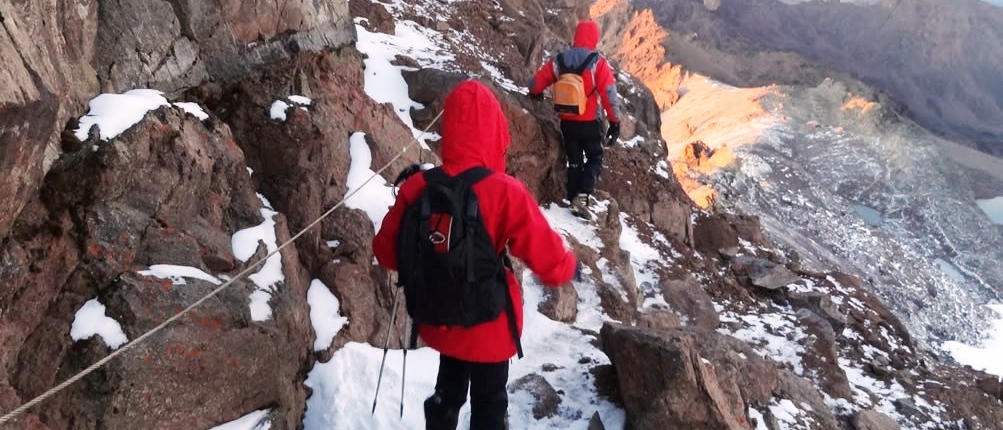
Trip Highlight For 4 days Mount Kenya Trek
Day 1: Nairobi/Meteorological Station 3-4 hrs, 10km, 400m ascent Day 2: Met Station/Mackinders Camp 5-6 hrs, 10km, 1200m ascent Day 3: Mackinders Camp/Point Lenana/Met Station 8-10 hrs, 11km, 785m ascent Day 4: Met Station/Naromoru/Nairobi 3hrs, 9km, 400m
Detailed Itinerary For the 4 days Mount Kenya Trek
Day 1: nairobi/meteorological station.
3-4 hrs, 10km, 400m ascent A Bushtroop Safaris & tours driver guide will transfer you to Naromoru Park Gate for registration and where the hike starts, 2600m From the gate, keep to the park track, which follows the crest of a board ridge between the Northern and Southern Naromoru valleys. The going is easy and its a pleasant walking through the forest. About two thirds of the way up after the bridge there are good views to the left north down into the Northern Naromoru valley. The trek ends at Met station 3,000m where dinner and overnight rest will be, B, L, D
Day 2: Met Station/Mackinders Camp
5-6 hrs, 10km, 1200m ascent Head uphill on the track to pass the radio must on your right after about half an hour. The trek runs into a path and after another 30 minutes, you will reach the end of the forest belt and enter the moorland. This is the vertical bog conditions range from damp to glutinous depending on when it last rained. Continue through until the going improves and you reach a fork overlooking Teleki Valley to reach Mackinders Camp, 4,200m. Dinner and overnight at Mackinders Camp, B, L, D
Day 3: Mackinders Camp/Point Lenana/Met Station
8-10 hrs, 11km, 785m ascent The normal approach is to start at 2 am in order to reach point Lenana taking about 4 hr walk by sunrise at 6:30am. After sunrise, descend down to Mackinders Camp for breakfast, 2hrs and walk further 4hrs, way back to Met Station for dinner and overnight, B, L, D
Day 4: Met Station/Naromoru/Nairobi
3hrs, 9km, 400m After breakfast, descend through the rainforest which is 9km to Naromoru Park Gate at 2,600m where you will connect with your transport back to Nairobi, B, L
1 Person US$ 800
2 Person: US$700 per person
3 Person and more US$ 660 per person
PRICE INCLUDE
-All transport from Nairobi to the mountain and back
-Camping fee
-3 Meals per day
-Porters fee
NOT INCLUSIVE
-Soft drinks e.g beer
-Equipments(we have them for hire)
WHAT YOU NEED TO BRING WITH YOU
-Down sleeping bag
-7 degrees centigrade
-Rain jacket
-Rain trouser
-Balaclava (woolen Hat)
-Warm Clothes
-Fleeze jacket
-Hiking boots
-Walking sticks
-Sunglasses
Fill Free To Fill This Contact Form
- Super Luxury
Bushtroop Tours & Safaris
Make Online Payments Here

Review Us Here
Experiences.
Gorilla Trekking Tours
Kenya Fly-in Safaris
Hot Air Balloon Safaris
Hiking Adventures
Honeymoon Safaris
Wildebeest Migration
Our Physical Address:
View Park Towers, 14th Floor, Utali Street, P.O. Box 1226 – 00515, Nairobi Kenya
Mobile / Telephone:
- +254 20 3316645
- +254 733 725823
- +254 722 802513
Bushtroop Tours & Safaris

Send us a message and we will get back to you back you. Thank You
THREE WAYS TO PLAN AND BOOK YOUR SAFARI WITH AFRICANMECCA
TRAVEL & OPERATIONS OFFICES
- United States
- United Kingdom
MOUNT KENYA CLIMBS
Want to trek mount kenya safely & successfully scroll down for details...
- Travel Guide
- Parks Reserves
- Mount Kenya
Review Our Recommended 7 Days Mount Kenya Climb Itinerary
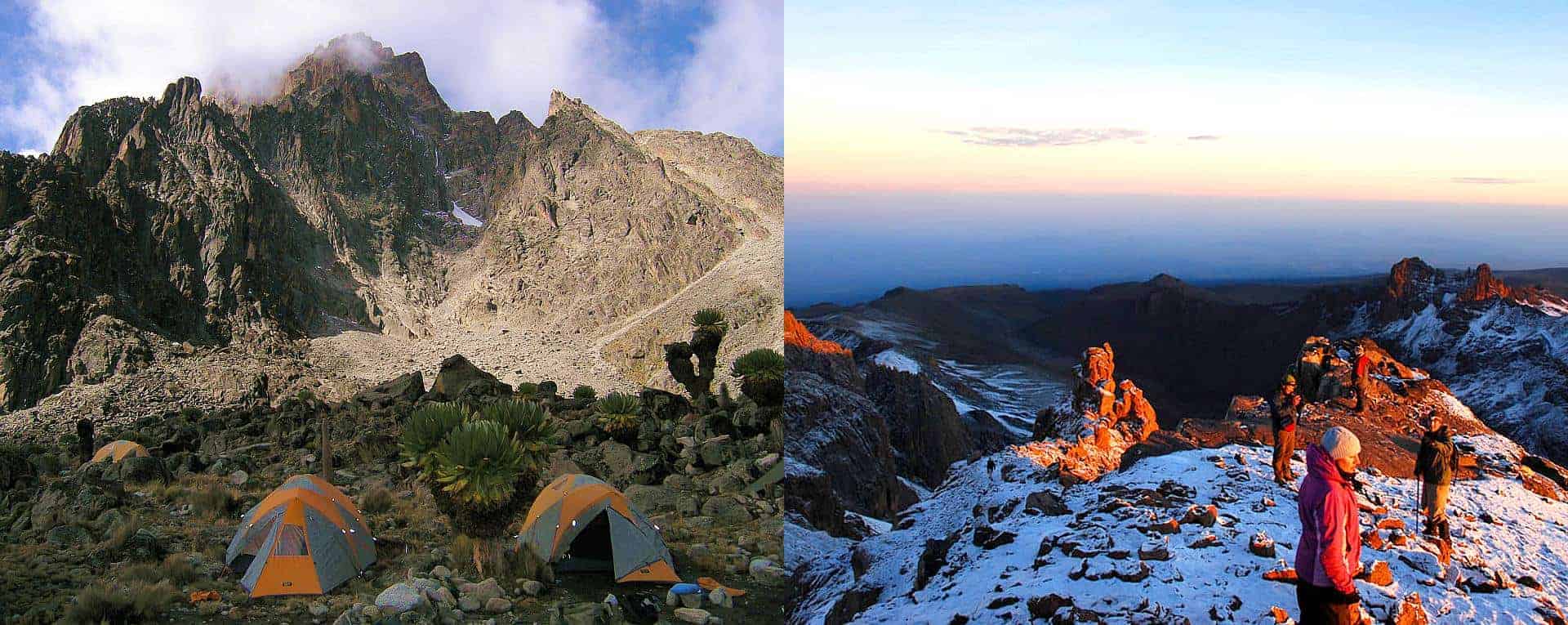
AFRICANMECCA REVIEWS
Dear Raza, You turned our dream into a reality. Our honeymoon and wedding in Kenya was so much more than we hoped for. We've never in our wildest dreams thought a vacation could be so perfect...
Mrs Annemarie Bain, Post Production Producer, Maury Show NBC Studios - New York, United States
To sum it up, it was awesome! The accommodations were beautiful, the food was great, and the people of Kenya were warm and friendly. I would give an A+ to the overall rating of this safari trip. Thank you....
Sharon Kolodziejski & Family - Michigan, United States
We are writing to you on our return to say what a marvellous job AfricanMecca did for us on our holiday in Kenya. All the arrangements you made went like clockwork. We are already recommending you to friends.
Liz and Nigel Barnes - West Sussex, United Kingdom
Our Best Of Kenya Tier I safari was really wonderful. Everything was perfect. Excellent top notch service from AfricanMecca! Thanks very much for making our trip really memorable.
Lorna Mata - Ottawa, Canada
Dear AfricanMecca, I could not think of any other better way to tell you about our superb safari that you organized in Kenya than to send you my 11 year old's safari Journal..Thank you
Zahira Hassanali & Family - Long Island - New York, United States
Hi Raza, I wanted to let you know trip was very well arranged; AfricanMecca's dealings were professional, informative and particular. Governors Il Moran and Mount Kenya Safari Club were great! Thank you.
Gurdeep Singh Bedi - New Delhi, India
Dear Raza, Just a note to let you know that my daughter and I had a wonderful time in Kenya. I fell in love with your beautiful country. You certainly lived up to your commitment of superb service.
Patricia Young - Universal Music Group - California, United States
East africa safari booking trip idea for mount kenya in central kenya, best safari planning ideas & trip experiences for kenya, 1. how to plan kenya safari trips (summary), 2. wildlife safari trip planning guide for kenya, 3. private & tailor-made safaris trip planning guide for kenya, 4. honeymoon safaris trip planning guide for kenya, 5. family safaris trip planning guide for kenya, 6. luxury safaris trip planning guide for kenya, 7. photo safaris trip planning guide for kenya, 8. cultural safaris trip planning guide for kenya, 9. primate safaris trip planning guide for kenya, 10. hike, trek & bush walk safaris trip planning guide for kenya, 11. birding safaris trip planning guide for kenya, 12. horseback riding safaris trip planning guide for kenya, 13. balloon safaris trip planning guide for kenya, 14. wedding safaris trip planning guide for kenya, 15. bush & beach safaris trip planning guide for kenya.
Read More +
Guide on mount kenya park.
Celebrating Kenya's iconic landmark, Mount Kenya National Park offers a distinct highlands tour to the discerning AfricanMecca guest, from forest walks, peak climbs to lodge game viewing and more.
WHERE TO STAY IN MOUNT KENYA
Fairmont Mount Kenya Safari Club is located outside the park borders near Nanyuki while Serena Mountain Lodge is sought by guests who want to stay inside the park amidst the forest wilderness.
SAFARI & TOUR IN MOUNT KENYA
The extraordinary beauty of Mount Kenya inspires you to venture into the wilderness. While safari game drives are not allowed due to its fragile ecology, you do enjoy nature walks in the foothills.
BEST TIME TO VISIT MOUNT KENYA
The weather at Mount Kenya National Park consistently offers guests a unique African highlands safari experience at any time of year. This park experiences two dry seasons and two rainy seasons.
Kickstart Your Safari Planning
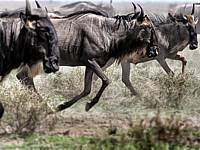
SAFARI PRICES
Find Kenya Safaris & Costs By Safari Tier Experiences
Mount Kenya Room Rate & Hotel Price Guide For Kenya
Kenya Safari Reviews For Mount Kenya National Park
Mount Kenya National Park Map Location In Kenya
PHOTO GALLERY
Images & Pictures For Mount Kenya Safari Park In Kenya
VIDEO GALLERY
Safari & Accommodation Videos For Mount Kenya Park
ARE YOU PLANNING TO BOOK AN AFRICAN SAFARI TO MOUNT KENYA IN KENYA?
Do You Need Knowledgeable, Experienced & Specialist Guidance For Your Travels In Mount Kenya ? Let Us Help Plan Your Trip Itinerary Correctly
MOUNT KENYA CAMPS & LODGES
Scroll and view more Mount Kenya safari accommodations in Kenya
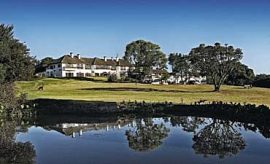
Fairmont Mount Kenya Safari Club
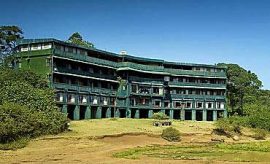
Serena Mountain Lodge
Explore more on mount kenya national park in kenya, safari tier ratings.
Understand Safari Tier Ratings & Experiences In Kenya
KENYA PARKS & RESERVES
Mount Kenya National Park & Safari Planning Guide
KENYA LODGES & CAMPS
Guide For Lodges & Camps In Mount Kenya
BEST TIME TO VISIT KENYA
Top 10 Trip Reasons For Kenya Vacations & Holidays

HAVE YOU VISITED MOUNT KENYA FOR AN AFRICA SAFARI IN KENYA?
Write A Travel Or Tourist Trip Review To Share Your Experiences
KENYA TRIP IDEAS
Africa safari prices.
Check Our Africa Travel Guide
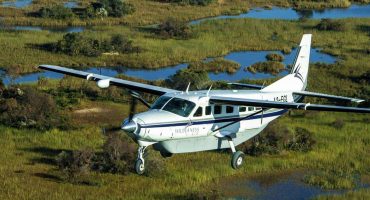
Baggage Guidance & Restrictions On Flying Safaris In Africa
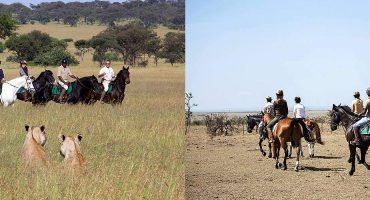
Masai Mara Horseback Riding Safari In Kenya With AfricanMecca
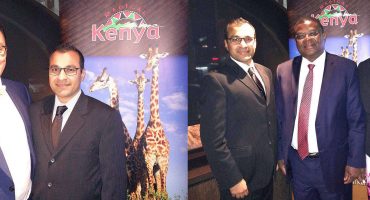
Times Square New York Hosts Kenya Tourism Board & Wilderness Safaris Meet Up
- Company Profile
- Why Travel With Us
- Our Safari & Tour Team
- Tier Ratings
- Awards & Press
- Customer Reviews
- SEARCH For Africa - Sustain & Conserve
- Travel Agent Support
- Jobs & Careers At AMS
- Newsletter Signup
- Contact Details
- Tanzania Travel Guide
- Kenya Travel Guide
- Uganda Travel Guide
- Rwanda Travel Guide
- Botswana Travel Guide
- South Africa Travel Guide
- Zambia Travel Guide
- Zanzibar Travel Guide
- Safari Trip Ideas
- Beach Trip Ideas
- Mountain Climb Trip Ideas
- Itinerary Trip Ideas
- Explore Park & Reserves
- Accommodations In Africa
- Read Trip Reviews
- View Photo Gallery
- View Video Gallery
- Read Our Blog
- Safari Prices & Itineraries
- Beach Prices & Itineraries
- Trek Prices & Itineraries
- City & Day Tours Prices
- Room Rate Guide
HOW TO CONTACT US

- Mount Kilimanjaro
- Mount Kenya
- Mount Toubkal
- Mount Aconcagua
- Mount Everest
- Mera Peak and Island Peak
- Mount Kinabalu
- Himalayan Mountains
- Borneo treks
- Nepal treks
- Moroccan Atlas treks
- Treks in East Africa
- Trek in Europe
- Wildlife Safaris
- School Expeditions
- Family Holidays
- Medical Electives
- Private Expeditions
- Indonesia and Papua
- Experiences
- Trip Finder
- Trip Leaders
- Sustainable Tourism
- Adventure blog
- Add a review
- Trip reviews
Ask Us A Question...

Mount Kenya Climbing Tours
Mount kenya routes, mount kenya trek.
5 day trip for £1,045.00
Trek to Point Lenana peak going up and down the Naro Moru and Sirimon routes on the North and West side of the mountain.
Mount Kenya Traverse
5 day trip for £1,145.00
Ascend by the west or northwest side and descend the south-eastern Chogoria route to traverse the mountain via the peak of Point Lenana.
Mount Kenya Summit Circuit
6 day trip for £1,395.00
A six day trek to Point Lenana crossing the mountain from West to East and circling the summit massif via several of the famous high camps.
'No Picnic on Mount Kenya' route
A six day trek up the less travelled Burguret route made famous by the Italian Felice Benuzzi, and descending the Chogoria route.
Mount Kenya Batian Peak
6 day trip for £0.00
Multi-pitch technical climb on Batian, the highest peak on this impressive mountain.
Mount Kenya Nelion Peak
Multi-pitch technical climb of the South East face of Nelion peak. Eight days including west-east traverse of the mountain and two summit days.
Mount Kenya is the less climbed cousin of Mount Kilimanjaro nearby in Tanzania, however many people prefer the wilderness, abundant wildlife and stunning mountain lakes that you find on Mount Kenya. Point Lenana at 4985m metres is a feasible trekking peak and also currently the worlds highest via ferrata summit route, which adds to the challenge and enjoyment. The panoramic views of the jagged volcanic peaks, wide valleys and surrounding savannah makes a trek on this mountain a thoroughly enjoyable African experience.
We have been guiding trips on Mount Kenya since 1996 and have full time mountain staff at the base. We adopt a proper approach to acclimatisation which means that the ascent is not rushed. We run advertised trips on all the main routes with scheduled dates but can also offer tailor-made private trips and can add-on safari's to experience a bit more of Kenya's diverse culture and unique wildlife in some of the world's great National Parks, Game Reserves and Conservancies.
About Mount Kenya
The tallest in Kenya, and the second highest in Africa, Mount Kenya stands 5199m tall. There are several summits on Mount Kenya : Batian, Nelion, and Point Lenana. Despite being a strato-volcano, the peak itself gets its rugged profile from previously being covered in ice. Today, there are 11 small glaciers still on the peak.
The area surrounding the peak make up Mt Kenya National Park, well known for its unique flora and fauna. From the lowland savannah and bamboo forests the flora changes as you rise in elevation. Here you will find the unique high-altitude equatorial environment. The landscape seems as if it belongs on another planet with strange plants and misty terrain.
The approach to Mount Kenya from Nairobi involves a journey of about four hours to either the town of Naro Moru or Embu, where we can provide accommodation in a local hotel or our Guest House. Naro Moru is the base for ascents on the Sirimon, Burguret and Naro Moru routes and Embu is used for the Chogoria route. All our advertised prices are based on camping on the mountain but there are also huts on the Sirimon, Naro Moru and Chogoria routes which you can upgrade to.
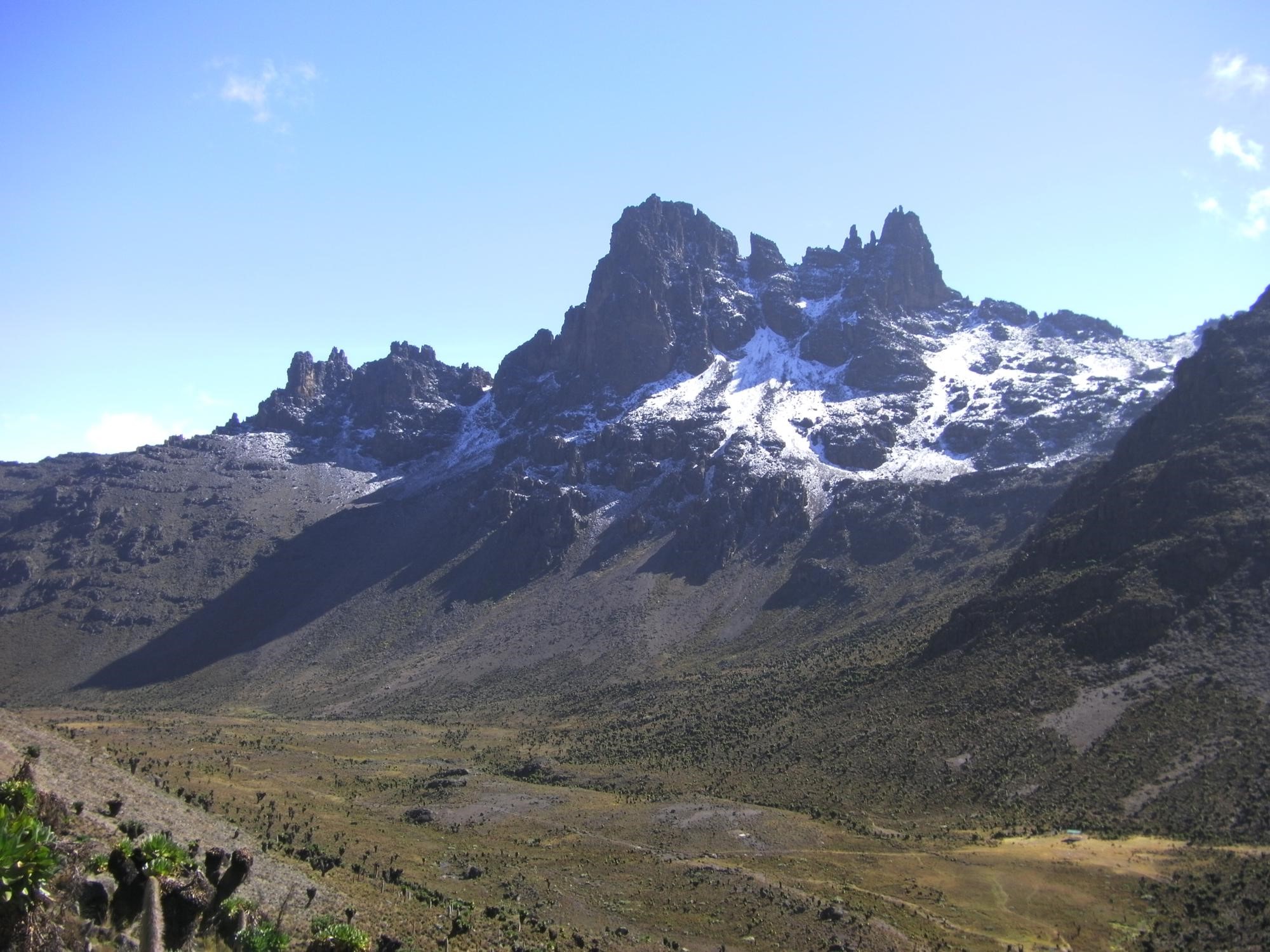
Mount Kenya Trekking Routes
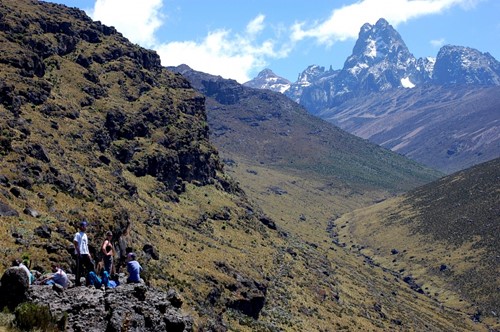
If you have any questions, we are happy to help. Simply drop us a line .
Mount Kenya Naro Moru Route
This particular trek ascends the Noro Moru Route from the west and is our most popular option for the ascent. It includes the notorious 'Vertical Bog' which ascends for an hour or so above the Met Camp and takes the hiker into the Teleki Valley and up to Mackinders Camp. From here, an acclimatisation day follows and then an early start to the summit, initially over easy paths to the head of the valley and then up a steep zigzag route on loose ground to reach the Austrian Hut at the base of the Lewis Glacier which has now retreated significantly over the past twenty years.
Aside from the stunning beauty, this route has the added challenge of a Via Ferrata. Feel the airy exposure of scrambling the side of the summit ridge from the Austrian Hut, the fixed lines help to provide a bit of extra confidence however the Naro Moru approach to the summit is definitely an adrenaline rush for those looking to experience the exposure of rugged peaks. From the summit our most popular descent is the stunning Chogoria route but cheaper and faster descents can be made down the Sirimon route or back down the Naro Moru route.
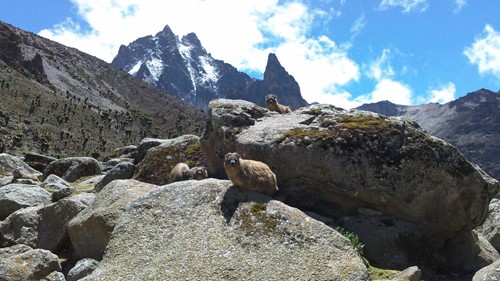
Mount Kenya Chogoria Route
Like the Noro Moru Route, the Chogoria Route of Mt Kenya does not require any technical climbing skills. Arguably this most beautiful of the trekking routes, it is also the longer option and our most popular option for the descent, however you can ascend the Chogoria route too. This route starts and ends at Embu and requires 4x4 transport to reach the starting point. It is also a trekking route that summits Point Lenana taking you through the Gorges Valley and the Lewis Glacier. There are lakes and tarns to explore along this route, although not the same infrastructure that you get on the Naro Moru and Sirimon routes, any climb on the Chogoria side will be a camping trip.
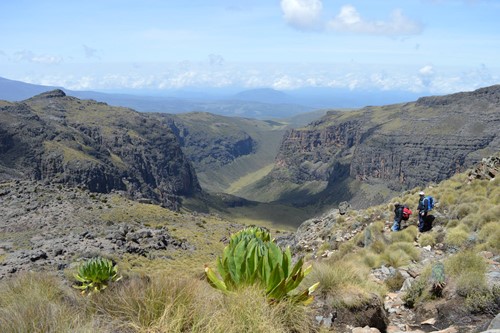
Mount Kenya Sirimon Route
Sirimon is another walking route that reaches Point Lenana, this route is the easiest of the three trekking routes to Point Lenana. Also starting from Naro Moru, the route takes five days and the diverse scenery and enjoyable hiking make this route the perfect choice if accompanied with a descent down the other side on the Chogoria route.
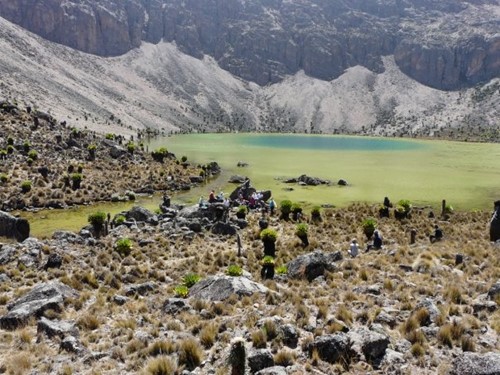
Combination Routes, Traverses & Summit Circuits on Mount Kenya
We have several different combination routes for trekking to Point Lenana, allowing you to go up one route and down another. Almost all are camping routes, but some have mountain huts that you can upgrade to. Our Mount Kenya Traverse ascends the Naro Moru and descends via the Chogoria route over 5 or 6 days and would be our recommendation as it combines spectacular beauty with airy and challenging trekking and good acclimatisation. The Summit Circuit is a bit longer at seven days and explores the nooks and crannies of the mountain, circling the summit massif and camping high throughout. It includes going on a hunt for “Icy Mike” a very lost elephant!!
Technical Climbs up Mount Kenya Batian Peak
If you are a proficient trad climber, you will love the challenge of Batian Peak, the true summit of Mount Kenya (5,199m) . Previous technical rock climbing experience is required for this 21-pitch climb. All 21 pitches are done in one day, making this Mt Kenya summit not only a beautiful climb, but an exhausting one as well. This peak is best attempted in June through August.
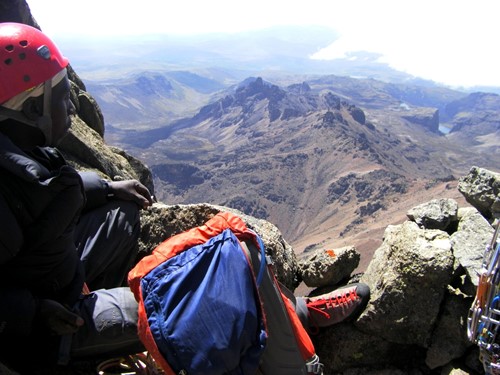
Technical Climbs up Mount Kenya Nelion Peak
The second tallest peak on Mt Kenya demands 18 pitches of trad rock climbing. Like its neighbor, plenty of technical rock climbing experience is required prior to climbing this demanding point. It is possible, if the weather and snow pack permits, to climb both Nelion and Batian Peak in the same day if you are a well-experienced fit climber, but this involves traversing between the two. There is in fact a small bivi hut right on the summit of Nelion which can take two people who get weathered out or have run out of time. Prime times for climbing Nelion are September through to March.
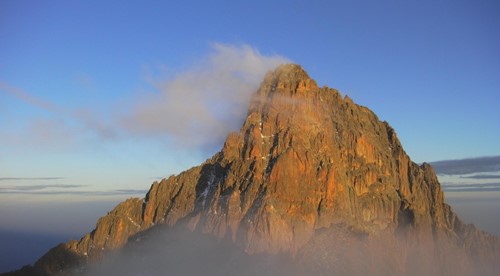
Best Times to Trek Mount Kenya
Best times for climbing Mount Kenya from any of the trekking routes are January to March and June to October but it can be climbed year-round. The rainy seasons typically occur in April, May and November. However, with the onset of climate change they have been difficult to predict in recent years.
Fitness Level Required to Climb Mount Kenya
For the trekking routes up to Point Lenana, you do not need to be an ultra-fit mountaineer. However, you should have some previous hiking experience over hilly terrain and a good overall fitness. For Nelion or Batian Peak you will need to be in excellent climbing shape. Multi-pitch climbs involve a lot of stamina and strength. Not just in your ability to climb, but walk as well. The technical climbing routes require you to summit Point Lenana as well, so be prepared to both trek and endure a multi-pitch climb.
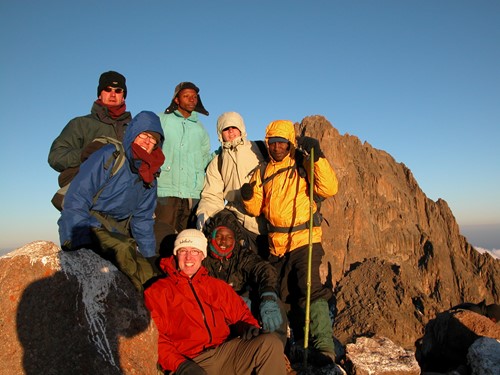
Whichever route you choose, Adventure Alternative promotes proper acclimatization. We build extra days and hikes into our itineraries to ensure that you do not ascend too quickly and you are properly acclimatized.
Cultural Importance of Mount Kenya
Mount Kenya holds deep cultural value in the eyes of the Kenyan people. Local tribes have use this peak as a meeting place and it is seen as a throne of the gods. This mountain gave the country of Kenya its name and it holds a special place in the heart of all Kenyans.
Gear and Kit Required to Climb Mount Kenya
Aside from personal articles, having the right layering and clothing is key for climbing Mount Kenya. Having a few moisture-wicking, non-cotton layers are essential. Furthermore, you will want an insulating layer like a puffy jacket, hat and gloves for higher elevations. Mount Kenya does get rain and snow, so a waterproof layer and gaiters are useful for keeping the wind and rain at bay.
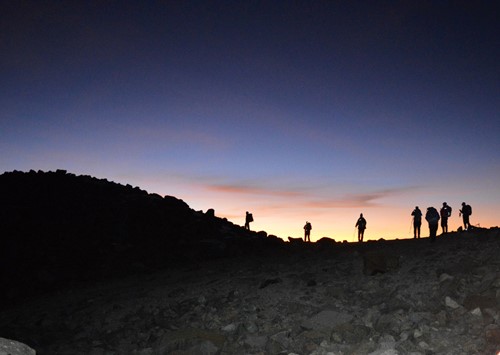
If you are climbing Nelion or Batian peaks, you are responsible for bringing your own trad racks, ropes, harness, helmet, cams and anchoring systems.
For a more comprehensive list of gear see our trekking kit list for Mount Kenya .
Need to know more? We’re here to help. Feel free to contact us with any questions you may have regarding your trip to Mount Kenya.
Mount Kenya books and maps
Maps & guides.
Mount Kenya 1:50,000 Map & Guide. Wielochowski. EWP 2007 Kilimanjaro & East Africa, Climbing & Trekking Guide. Burns. ISBN 0-89886-604-9 Guide Book to Mt Kenya & Kilimanjaro. Mtn Club of Kenya, (4th Ed 1990) ISBN 9966-986-0-3 Trekking in East Africa, Lonely Planet, ISBN-10: 1864502894, ISBN-13: 978-1864502893
Factual Stories & Autobiographies
No Picnic On Mount Kenya. Felice Benuzzi. ISBN 978-1-59228-724-6 Upon That Mountain, Eric Shipton, Ashdown. ASIN:B000QREDLY Chapters 4 & 5 That Untraveled World, Eric Shipton, Hodder & Stoughton. ISBN 0-340-21609-3 Snow On The Equator, H.W.Tilman, The Travel Book Club. Chapter 4 Kenya Mountain, E A T Gregory, Jonathan Cape. 1929. The First Ascent of Mount Kenya, H Mackinder, Hurst. ISBN 1-85065-102-7 Through Masai Land. J Thomson. Frank Cass & Co Ltd. ISBN 1-141-95717-5
Large Format Pictorial & Descriptive
Snowcaps On The Equator. Ward, Boy & Allan. ISBN 0-370-31126-4 On God’s Mountain. Amin, Willets, Tetley. ISBN 0-86190-393-5 Mount Kenya, John Reader, Elm Tree. ISBN 0-241-12486-7
Expedition Reports, Journal Articles & Scholarly Publications
A Journey to the Summit of Mount Kenya. H. Mackinder, The Geographical Journal, May 1900. The Glacial Geology of Mount Kenya. J Gregory, Quarterly Journal of the Geological Society, 1894. The Great Rift Valley. J W Gregory, Frank Cass & Co. ISBN 0-7146-1812-8 The Glaciers of Equatorial East Africa. S. Hastenrath. D. Reidel. ISBN 90-277-1572-6 Discovery of Lakes Rudolf and Stefanie. L. Höhnel, S. Teleki. Longmans Geological Map of the Mount Kenya Area. Cartography by B. H. Baker
General Country Information & Relevant Books
Kenya, Lonely Planet Guide. ISBN 978-1-74104-773-8 The Rough Guide to Kenya, Rough Guides, ISBN-10: 1848361378, ISBN-13: 978-1848361379 Born Free, Adamson, Pan Books, ISBN-10: 0330391909, ISBN-13: 978-0330391900 Out of Africa, Blixen, Penguin Classics, ISBN-10: 0141183330, ISBN-13: 978-0141183336
Mountain Travel & Altitude
Altitude Illness: Prevention & Treatment. Bezruchka. ISBN 0-89886-985-5 Travel At High Altitude. Medex. ISBN 0-901100-76-5 http://medex.org.uk/v26%20booklet.pdf British Mountaineering Council website : http://www.thebmc.co.uk/Feature.aspx?id=3158 International Mountaineering and Climbing Federation website : http://www.theuiaa.org/medical_advice.html UNESCO listing info http://whc.unesco.org/en/list/800
Summary & Aerial Shots of Mt Kenya. https://vimeo.com/80359250 Aerial shots and Time lapse of Mt Kenya. https://vimeo.com/80375283 Volcanic Origin, Retreating Glaciers, Watersource. https://vimeo.com/80362793 Volcanic Mechanism of Rift Valley & Mountains. https://vimeo.com/80375280 Flora & Fauna on Mt Kenya. https://vimeo.com/80364403 Flora & Fauna on Mt Kenya. https://vimeo.com/80377285 Kikuyu Beliefs & Ngai. https://vimeo.com/80365566 Kikuyu Beliefs & Drought. https://vimeo.com/80365567 Weather & Climate on Mt Kenya. https://vimeo.com/80375277 Forest Zone- Colobus Monkeys. https://vimeo.com/80368535 Aberdares- As an ancient version of Mt Kenya. https://vimeo.com/80367751
- Blueline Hotel - Mount Kenya
- Top 5 routes on Mount Kenya
- General Information
- National Parks
- Mount Kenya food & lodging
- Mount Kenya advice
- Trekking boot advice
- Acclimatising safely
- Mount Kenya routes
- Mount Kenya trek kit list
- Mount Kenya trek options
- Hygiene on trek
- You are here:
- All Kenya Tours
Mt Kenya Climbing, Trekking and Hiking Tours
Your safari, tour length, rates in usd $ – change currency, starting from.
- Nairobi (51)
- Mombasa (0)
- Diani Beach (0)
- Entebbe (0)
- Johannesburg (0)
- Zanzibar (0)
- Dar es Salaam (0)
- Victoria Falls Town (0)
- Kampala (0)
- Windhoek (0)
- Cape Town (0)
- Addis Ababa (0)
- Livingstone (0)
- Hoedspruit (0)
- Port Elizabeth (0)
- Antananarivo (0)
- Pretoria (0)
- Nelspruit (0)
- Hazyview (0)
- Upington (0)
- Bujumbura (0)
- Blantyre (0)
- Lilongwe (0)
Comfort Level
- Luxury+ (0)
- Mid-range (0)
- Budget (51)
Private or Shared Tour
- Private tour (21)
- Shared tour (31)
Safari Type
- Lodge, tented camp or hotel (24)
- Camping (28)
Operator Rating
- & up (46)
Specialized Tours
- Fly-in safaris (0)
- Beach time (0)
- Honeymoon (1)
- Gorilla trekking (1)
- Photographic safaris (0)
- Mountain climbing (52)
- Walking safaris (0)
- Self-drive (0)
- Guided self-drive (0)
- Chimp trekking (1)
- Overland tours (0)
- Cycling safaris (0)
- Canoe safaris (0)
- Horseback safaris (0)
- Birding tours (0)
- Accessible safaris (0)
- Golf & Wildlife (0)
Other Tour Features
- Airport transfer is included (51)
- Itinerary can be customized (27)
Filter by Operator
Filter by accommodation, operators from.
- South Africa (0)
- Tanzania (0)
- United Kingdom (0)
- United States (3)
- Australia (0)
- Belgium (0)
- Botswana (0)
- Comoros (0)
- Denmark (0)
- Ethiopia (3)
- Eswatini (0)
- Germany (0)
- Ireland (0)
- Lesotho (0)
- Madagascar (0)
- Mauritius (0)
- Mayotte (0)
- Mozambique (0)
- Namibia (0)
- Netherlands (0)
- New Zealand (0)
- Nigeria (0)
- Portugal (0)
- Reunion (0)
- Seychelles (0)
- Singapore (0)
- Switzerland (0)
- United Arab Emirates (0)
- Zimbabwe (0)

29-Day Authentic Kenya and Uganda Safari Experience
$10,780 to $11,000 pp (USD)
Kenya & Uganda: Private tour Lodge & Tented Camp
You Visit: Nairobi (Start) , Meru NP, Samburu NR, Shaba NR, Mt Kenya, Aberdare NP, Lake Baringo, Lake Naivasha (Naivasha) , Amboseli NP, Tsavo West NP, Tsavo East NP, Nairobi (City) , Entebbe (City) , Bwindi NP (Gorillas) , Ishasha Sector (Queen Elizabeth NP) , Queen Elizabeth NP, Kampala (City) , Mt Elgon, Murchison Falls NP, Entebbe Airport (Entebbe) , Kampala (End)

5.0 /5 – 122 Reviews

2-Day Mt Kenya Trek and Ol Pejeta - Home of Chimpanzees
$715 pp (USD)
Kenya: Private tour Hotel
You Visit: Nairobi (Start) , Mt Kenya, Ol Pejeta (Laikipia) , Nairobi (End)
Maasai Mara Train Tour operator has an office in Kenya
5.0 /5 – 52 Reviews
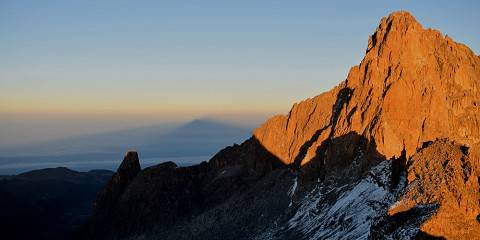
5-Day Mount Kenya Scenic Chogoria down Sirimon Route
$770 to $880 pp (USD)
Kenya: Shared tour (max 20 people per group) Camping
You Visit: Nairobi (Start) , Mt Kenya, Nairobi (End)
Hyrax Safaris Tour operator has an office in Kenya
4.9 /5 – 250 Reviews

4-Day Mount Kenya Trekking Safari Tour 2024
$531 pp (USD)
Kenya: Shared tour (max 6 people per group) Camping
Karibu Safaris In Kenya Tour operator has an office in Kenya
4.8 /5 – 1340 Reviews

8-Day Mt Kenya, Plains and Wildlife Elegance Safari
$3,065 to $3,450 pp (USD)
Kenya: Private tour Lodge & Tented Camp
You Visit: Nairobi (Start) , Amboseli NP, Mt Kenya, Ol Pejeta (Laikipia) , Lake Naivasha (Naivasha) , Masai Mara NR, Nairobi Airport (End)
Jastro Safaris Tour operator has an office in Kenya
4.9 /5 – 26 Reviews

6-Day Mt Kenya Climbing via Chogoria Sirimon Hike
$1,485 pp (USD)
Kenya: Private tour Camping
Kentau Safaris Tour operator has an office in Kenya

7-Day Mt Kenya Climb Chogoria – Sirimon Route
$1,771 pp (USD)
Kenya: Private tour Mountain Hut & Camping
Reliable Tours Tour operator has an office in Kenya
4.9 /5 – 32 Reviews

4-Day Mount Kenya Trek Using the Sirimon Route
$913 pp (USD)
Kenya: Shared tour (max 20 people per group) Mountain Hut
You Visit: Nairobi (Start) , Mt Kenya, Point Lenana (Mt Kenya) , Nairobi (End)
CKC Tours & Travel Tour operator has an office in Kenya
4.9 /5 – 115 Reviews

4-Day Mt Kenya Climbing via Sirimon -Descending Sirimon
$836 pp (USD)
Kenya: Shared tour (max 8 people per group) Mountain Hut
Oakland Tours and Safaris Tour operator has an office in Kenya
5.0 /5 – 80 Reviews

5-Day Mount Kenya Chogoria up and down Sirimon Route
$880 pp (USD)
Kenya: Shared tour (max 50 people per vehicle) Camping
Equitorial Star Adventure Safaris Tour operator has an office in Kenya
5.0 /5 – 13 Reviews
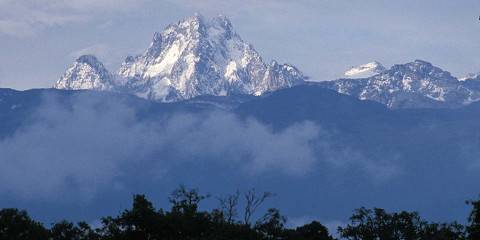
5-Day Mt Kenya Trekking with Tropical Wild Expeditions
$924 to $935 pp (USD)
Kenya: Shared tour (max 60 people per group) Mountain Hut & Banda
Tropical Wild Expeditions Tour operator has an office in Kenya
5.0 /5 – 5 Reviews
5-Day Mt Kenya Trekking Sirimon Gate down Chogoria
$677 pp (USD)
Kenya: Shared tour (max 8 people per group) Camping
Dennsland Trekktours Tour operator has an office in Kenya
4.4 /5 – 21 Reviews

5-Day Chogoria-Sirimon Mt Kenya Trek
Kenya: Private tour Camping & Banda
Lilac Roller Safaris Tour operator has an office in Kenya
4.9 /5 – 15 Reviews

5-Day Mt Kenya Trekking -Sirimon down Chogoria
Kenya: Shared tour (max 7 people per group) Camping
Africa Magical Scenery Tours and Safaris Tour operator has an office in Kenya
4.3 /5 – 7 Reviews

5-Day Mount Kenya up Sirmon down Chogoria
$897 pp (USD)
Kenya: Shared tour (max 8 people per group) Mountain Hut & Banda
Epic Star Holidays Tour operator has an office in Kenya
5.0 /5 – 2 Reviews

5-Day Mt Kenya Sirimon Route down Chogoria Route
$680 pp (USD)
You Visit: Nairobi (Start) , Mt Kenya, Chogoria Gate (Mt Kenya) , Nairobi (End)
Tegu Tours and Safaris Tour operator has an office in Kenya
4.8 /5 – 6 Reviews

5-Day Mt Kenya Trek up Chogoria down Sirimon
Kashipa Adventures Tour operator has an office in Kenya
5.0 /5 – 1 Reviews
5-Day Exciting Mount Kenya Trek (Chogoria down Sirimon)
$735 pp (USD)
African Uncut Safaris Tour operator has an office in Kenya
5.0 /5 – 3 Reviews

5-Day Mount Kenya Sirimon- Chogoria Route(5 Days)
$1,221 pp (USD)
Kenya: Private tour Mountain Hut & Lodge
You Visit: Nairobi (Start) , Mt Kenya, Point Lenana (Mt Kenya) , Chogoria Gate (Mt Kenya) , Nairobi (End)
Africa Outdoors Tour operator has an office in Kenya
Not yet rated
5-Day Mt Kenya Hike via Sirimon Route
$825 pp (USD)
Kenya: Shared tour (max 10 people per group) Mountain Hut & Tented Camp
Sun Summit & Safaris Tour operator has an office in Kenya
Related Searches
- Kenya Safari Holidays
- Mt Kenya Tour Operators
- Mountain Climbing Tours in Africa
- Mt Longonot Climbing Tours
- Mt Bisoke Climbing Tours
- Erta Ale Climbing Tours
- Mt Sabyinyo Climbing Tours
- Ol Doinyo Lengai Climbing Tours
- Mt Stanley Climbing Tours
- Mt Moroto Climbing Tours
- Mt Elgon Trekking Tours
- Rwenzori Mountains Trekking Tours
You are using an outdated browser. Please upgrade your browser or activate Google Chrome Frame to improve your experience.

- Chogoria route
- Bushland to Moorland
- Sirimon and Naro Moru routes
- Off the beaten track
- The Aberdares – new route
- Safari & Beach
- On the Equator

Scenic Mount Kenya
Guided walking tours to kenya's highest peaks, welcome to kenya treks.
We organise tailor-made walking safaris on Mount Kenya for groups or individuals who are looking for a mountain wilderness adventure.
Our trips are personalised itineraries without set departure dates.
We have an experienced mountain team who will do their utmost to ensure your trip is as safe and enjoyable as possible.
Mount Kenya is on the Equator, 4 hours drive north of Nairobi. On Africa’s second highest mountain, you can experience a high altitude walking trip amongst rugged peaks and glaciers, without the crowds.
If you are fit and active and want to challenge yourself to a high peak, you can trek to the third highest point, Point Lenana, which at 4,985 metres is higher than Mont Blanc. Or you can stroll in the eastern foothills, camping by Lake Ellis, visiting the spectacular Nithi waterfalls and climbing the mini summit of Mugi Hill.
You can combine your mountain trip with a safari either in one of the neighbouring conservancies such as Ol Pejeta, or in a national reserve such as Samburu, a few hours drive from Mount Kenya.
Please come and visit this beautiful region of northern Kenya, ‘Kenya’s high country’.
We look forward to welcoming you back this year as soon as global restrictions start to lift. Kenya has adopted health and hygiene protocols of the World Travel and Tourism Council and is a ‘Safe Travels’ destination.
Thank you for your support. Lucy Booth Fellow of the Royal Geographical Society

Anna Vernon-Evans and friends, UK

The Hardwick family, UK
Lucy (and Kenya Treks) were so ‘can do’, knowledgeable, reliable and efficient with our family trip to Kenya. We had a clear brief: essentially to climb Mt Kenya the ‘less trodden’ route, visit remoter game reserves, see old Mombassa, and use the new fast x-country train to the coast for diving and beach-time. Kenya Treks (Lucy and John) put together and delivered a trip that ticked every box and much much more. We especially loved the variety: from a ‘biophilic’ boutique highland lodge with views of Mt Kenya for acclimatisation, to eco-safari tents, mountain refuges, ‘pup tents’ and stunning beach lodges. The 5 day trek was stunning, if undeniably challenging. But all six summited! The team’s deep understanding of these mountains, their organisation and positive attitude throughout were fabulous. Thanks again from all the Hardwicks – August 2022.

Jan Rowland, UK
It was the most special of family holidays. Lucy and her team organised everything beautifully.
The team’s breadth of local knowledge is second to none, and as a result we had the most memorable experiences. We rode horses alongside grazing giraffes, camped under the stars and stayed on an idyllic desert island.
We can’t wait until our next Kenyan adventure – August 2022.
Paul Aldretti, USA
Thank you for a wonderful adventure! Mark and I had a great time. I feel really good about both of us making the trek (including the summit) without too much trouble on our part and hopefully yours. The staff were terrific and we appreciated their work – August 2019.
Peter Jenks, UK
We wanted to let you know how much we enjoyed our recent holiday in Kenya and would like to thank you for arranging it….probably the best holiday we’ve had.
The expedition up Mount Kenya was everything we had hoped for. The Chogoria route provided stunning scenery and flora (as well as an elephant and buffalo on the way). The whole team of porters were friendly and supportive and did everything to ensure we were looked after, comfortable and made it to the summit. We cannot speak highly enough of the core team of John, James, Jackson and Sam who were exceptional – July 2019.
Anne Tissier, France and Kenya
Mount Kenya 60+ was a very special project to me. Lucy Booth enthusiastically agreed to join me and designed the best itinerary I could imagine. The most pristine areas, including Point Lenana, for ourselves with plenty of time to enjoy them. Kenya Treks’ guides, porters, cook and waiter are a team of professionals, mountain lovers and fun people. All equipment is top quality and well maintained. This together transformed the climb into un voyage inoubliable… à refaire ! Asanta sana !! – January 2019.
Nick Buckland, UK
Just a quick note to thank you so very much for organising our amazing trip. Memories abound but what will most stick are the smiley faces and laughter of the team, welcoming bowls of hot water to wash our hands, hot water bottles, tea in the morning, copious amounts of food and amazing scenery. Thanks again to you and the team – October 2018.
Cheryl Talbert, USA
Hello! I wanted to send a quick note with the photos from our group’s recent trek to Point Lenana (Chogoria-Sirimon) with John, James and team from Kenya Treks. They did a fantastic, professional job in all aspects and I won’t hesitate to recommend them to others. Thanks for all your great work! – August 2017
Recent News
- Alice Thomson of The Times bonds with her family on Mount Kenya
- High adventures in Northern Kenya
- Jonathan Dimbleby travels with Kenya Treks
- Why I Love Kenya – Issue 14
- Mount Kenya Trust 60 plus climb
© 2007 - 2024 · Mukima Walking Safaris Ltd t/a Kenya Treks, PO Box 84, Nanyuki 10400, Kenya
Wilderness Alternative Expedition
Beyond African Trails
Travel to east africa
Home of authentic safaris.
Wilderness Alternative Expeditions is an independent mountaineering and safari company founded in 2015 by mountaineer and photographer Kenny, who started as a porter. Wilderness specializes in unbeaten paths in Kenya, such as Lake Turkana, Lake Baringo, Samburu, Mount Kenya, and the entire Northern Kenya region. Renowned for the comfort provided to clients climbing Mount Kenya, we are recognized as one of Kenya’s premier mountaineering companies. Our emphasis on responsible travel and extensive knowledge distinguish Wilderness Alternative Expeditions.
We have organized trips to the border of Kenya and Ethiopia, Mount Kilimanjaro, Lake Turkana, Chalbi Desert, Maasai Mara, and numerous other beautiful destinations in Kenya. Offering a variety of trips for all levels, including mountain treks, safaris, and desert excursions, our most popular expeditions include treks to Mount Kenya, safaris to Maasai Mara, Lake Turkana, and Meru National Park.

Maasai Mara
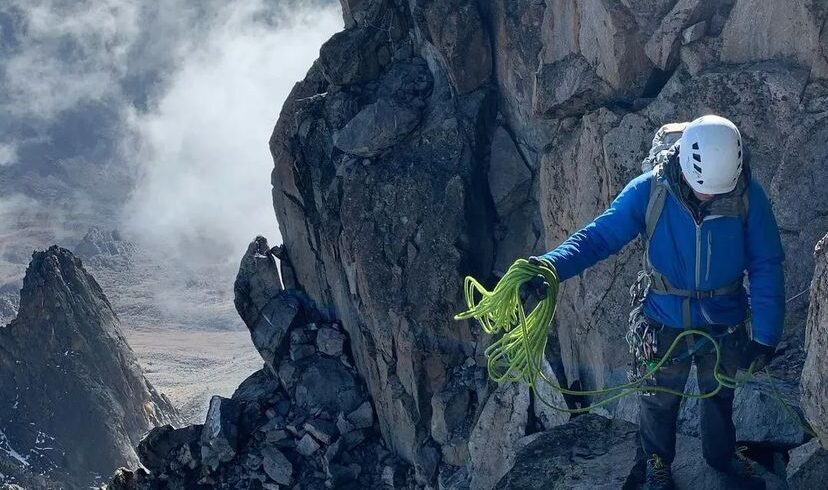
Mount Kenya Combined Routes Itinerary
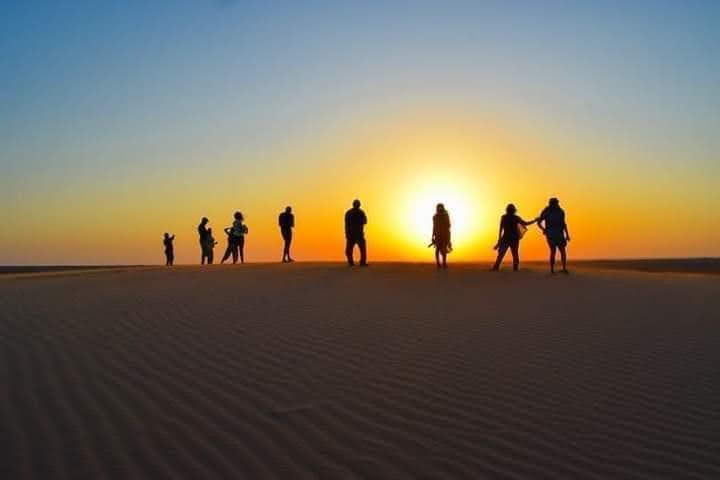
The Nothern Kenya
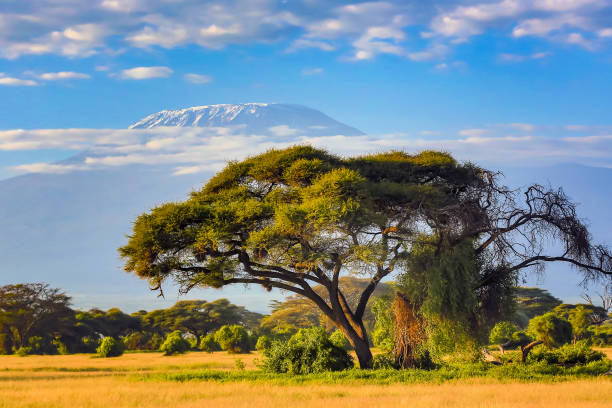
Mount Kilimanjaro
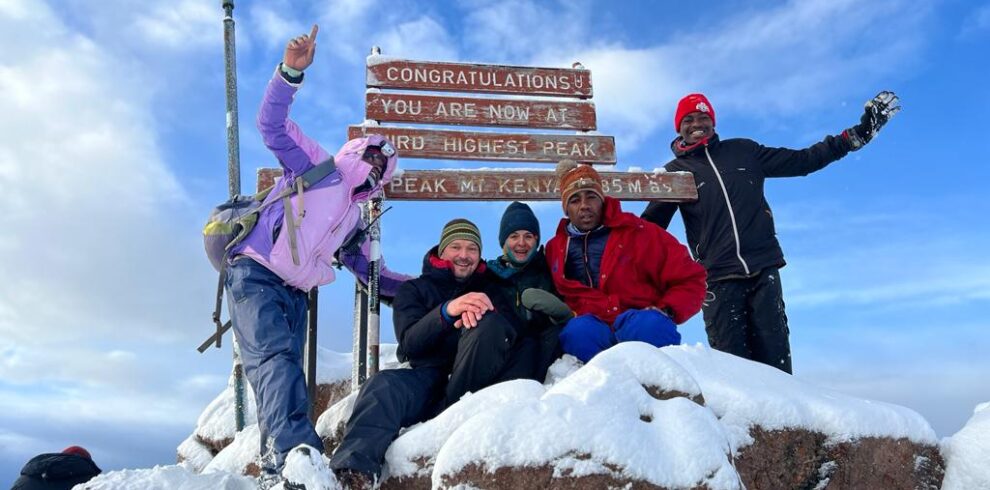
Mount Kenya
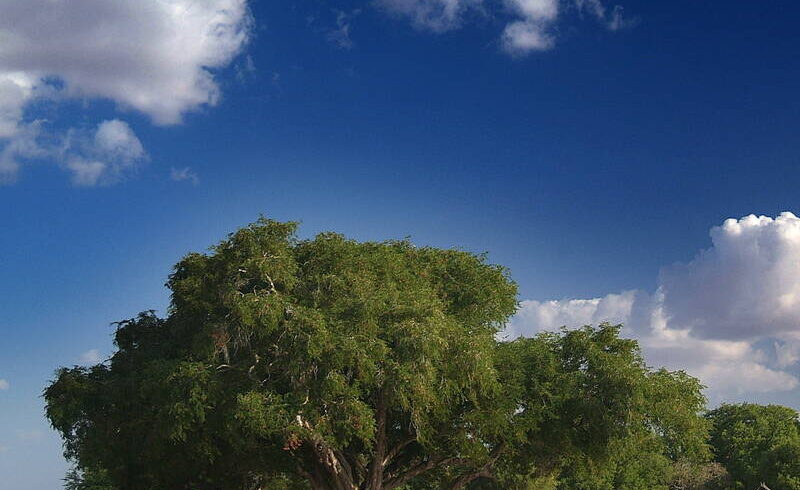
Tsavo National Park

- Combinations
- Mount Kenya
- South Coast
- North Coast
- Aberdare National Park
- Amboseli National Park
- Lake Nakuru National Park
- Lake Naivasha
- Lewa Wildlife Conservancy
- Masai Mara Game Reserve
- Mt Kenya National Park
- Meru National Park
- Nairobi National Park
- Ol Pejeta Conservancy
- Samburu National Reserve
- Shaba National Reserve
- Tsavo East National Park
- Tsavo West National Park
- Meet the Team
- Fleet & Vehicles
- Camping Equipment
- Terms & Conditions
- Tailor-made tours
Trekking Mount Kenya
Hiking up Mount Kenya, the second highest mountain on the African continent, is on the bucket list of many travellers and an amazing trekking adventure for nature lovers.
You will hike through the thick montane and bamboo forests of the lower slopes, where zebras and eland antelopes often graze. Passing babbling brooks and dark blue mountain lakes, you might be lucky and spot our mountain’s big brother, Mount Kilimanjaro, in the distance.

Nature lovers appreciate Mount Kenya for its impressive landscapes and diverse wildlife, acknowledged even by the UNESCO as a world heritage site. Adventure seekers long to conquer the rugged cliffs and ice walls, navigating the highest via ferrata in the world.
Whether you are an experienced expeditioner or a novice hiker, there is a peak for you on Mount Kenya: you can reach Point Lenana at 4985m even if you don’t have climbing experience. The snow-capped peak of Batian at 5199m on the other hand is reserved for those with technical finesse and an appetite for adventure.
No worries, at Kenya-Experience we will walk with you and have your back:
- You won’t get lost – thanks to our professional guides who will lead the way.
- You will be comfortable – thanks to our high-quality camping gear and experienced crew.
- You will get the strength you need – thanks to our mountain-chefs cooking up a storm for breakfast, lunch and dinner.
We have climbed Mount Kenya via different routes and specialise in treks to Point Lenana.
Our Trekking Routes options

from 1,010 USD pp (2 pax)
Sirimon route – 4 day mt kenya trekking tour.

from 1,195 USD pp (2 pax)
Chogoria route – 5 day mt kenya trekking tour, what to expect on a mount kenya trek.
Our professional and experienced guides will take the lead and guide you every step of the way. They know the mountain, its wildlife and vegetation well. They will share their knowledge with you, letting you experience the trek and appreciate the beauty of the mountain on a deeper level.
On most treks, you will overnight in tents, carried and set up by our crew. You will share a two-person-tent with your fellow traveller or a traveller of the same sex, if you are going solo. Good-quality camping gear is of the essence, giving you a good night’s rest before you embark on the next leg of the journey.
Our chefs will make sure that you not only won’t go hungry, but will enjoy wholesome, delicious meals in the middle of nature. Equipped with a gas cooker and fresh nutritious ingredients, they will conjure up breakfast and dinner for the whole hiking party, plus pack lunch boxes for a snack along the way. You’re vegetarian, vegan or have any other dietary requirements? Don’t you worry, our chefs have cooked for every palate.
You will only need to carry your own daypack with lunch box, water and other essentials. All other gear and equipment, such as bags, tents and food, will be carried by our porters, the true heroes of the mountain.

OUR FAMILY OF COMPANIES


Destinations
Trekking type, climbing mount kenya - expert tips from a guide, by rintsje bosch.
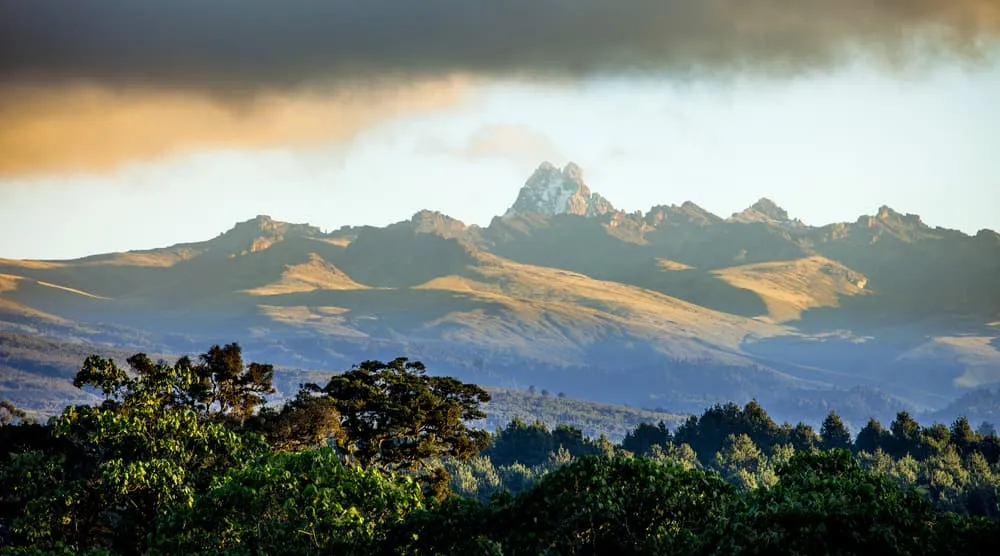
Climbing Mount Kenya is something else. Yes, of course, you should climb Kilimanjaro but when you are looking for a more interesting piece of rock in Africa, you will sooner or later come across Mount Kenya. Mount Kenya offers outdoor enthusiasts and mountaineers different options to bag one of the three peaks on Mount Kenya. You can make it as difficult as you possibly want. In this blog post we will focus mainly on the easiest but not less exciting way of your Mount Kenya climb: By foot. Yes, you can go trekking on Mount Kenya. We spoke to Evans Mwangi, who has climbed Mount Kenya hundreds of times as a guide and a porter and share his insights and tips for this trek.
Everyone can name the highest mountain in Africa but did you know that Mount Kenya is the second highest? With 5,199 meters Batian Peak is a bit higher than Nelion (5,1888m) and Point Lenana (4,985m). If you want to summit the first two peaks mentioned, you will need to gain some experience in traditional rock climbing. However, if you want to climb Point Lenana, you can just buy a decent pair of hiking shoes. You can get to the third highest peak on the second-highest mountain of Africa in only a few days of hiking. Evans Mwangi of Go To Mount Kenya has gone a few hundred times before you and these days he is sharing his expertise with trekkers from all over the world who want to trek to Point Lenana.
Mount Kenya Facts
Climbing mount kenya with guide evans mwangi, the importance of mount kenya, tips for climbing mount kenya from evans, what is the best season for a mount kenya trek, what should i pack while hiking mount kenya, itinerary for a mount kenya hike, how to train for climbing mount kenya, how much does climbing mount kenya cost, should i tip my guide after have climbed mount kenya, mount kenya map, how to identify and prevent ams on the mount kenya, where can i book the mount kenya.
How High is Mount Kenya?
Everyone can name the highest mountain in Africa but did you know that Mount Kenya is the second highest? With 5,199 meters Batian Peak is a bit higher than Nelion (5,1888m) and Point Lenana (4,985m). If you want to summit the first two peaks mentioned, you will need to gain some experience in traditional rock climbing. However, if you want to climb Point Lenana, you can just buy a decent pair of hiking shoes. You can get to the third highest peak on the second-highest mountain of Africa in only a few days of hiking.
Where is Mount Kenya?
The mountain is located in central Kenya, 150 kilometers northeast of the capital Nairobi. The snow-capped mountain is also surprisingly close to the equator located 16.5 kilometers south of the Equator. Mount Kenya is situated 320 kilometers to the south of the Kilimanjaro .

Burguret - Chogoria Traverse

Naro Moru - Sirimon Route
"I was only 18 years old when I started as a porter on Mount Kenya. It was a good way to make money in those days," remembers Evans Mwangi, managing director of Go To Mount Kenya, a trekking company specialized in Mount Kenya tours. "It was 1989. As I liked hiking so much, it was an obvious choice for me. The money was good and it kept me fit. No one in my family was into it, but I went for it anyway. Before I knew it, I was in my 20s and I had climbed Mount Kenya so often that I knew the mountain like the back of my hand. I was a cook for a few years and I then became a guide and started leading trekking expeditions."
I remember the mountain in those days. The glaciers on Mount Kenya, especially the Lewis Glacier, could be enjoyed in all their glory. Over the years the glaciers became smaller and smaller. One of them is just dust and rocks these days", says Evans with a slightly sad tone. "Climate change definitely took its toll on Mount Kenya. Everything else if still as it was, of course. The route itself hasn't changed.

Mount Kenya isn't just a great mountain to see and climb. The second-highest mountain of Africa is a massive catchment area and plays a vital role in the agricultural sector on the lower slopes of the mountain. "This is why you will see that every door in houses around Mount Kenya is facing the mountain. People believe the Gods are on the mountain and they provide. Without rain, no crops," explains Evans. "On top of that, tourism on Mount Kenya plays another vital role. Many people have jobs as a guide, a cook or a porter on the mountain. The trekking industry definitely makes a positive change in the livelihoods of people on and around Mount Kenya." The Kikuyu, Ameru, Embu, and Maasai all call Mount Kenya their home.
There came a point for Evans to professionalized and to start his own company. Evans took a course in guiding and can now name all the vegetation on Mount Kenya and is a professional when it comes to preventing altitude sickness. Evans now has two daughters and one son. Will they be part of the company one day? "I will leave that up to them. If they want to, they are welcome to. Of course, I am not as often on Mount Kenya as I used to be, but I do try to bring my family or my friends every now and then. Nothing is more rewarding than to have a few Tusker Beers after having successfully made it to Point Lenana."
"Some friends and I tried to climb to one of the other peaks some time ago. But for this, you need to be a very experienced rock climber. We didn't make it all the way to Batian, unfortunately. But, the trek to Point Lenana can be done by everyone, especially if you take it pole pole. This is Swahili for taking it easy", explains Evans. A guide will tell you the same when climbing Kilimanjaro. Taking it easy is key if you want to prevent altitude sickness and make it successfully to your goal. "As soon as you make it to 3000 meters, it is okay to take it slower. Also, you must drink lots of water to stay properly hydrated."
Most treks on Mount Kenya are either 4,5 or 6 days. If you have the time, Evans suggests doing it in 5 days at least. "This will give you more time for acclimatization and this way the trek doesn't become the rush. This will also allow you to do one of the longer routes, like the 6-day Burguret-Chogoria Traverse. Personally, I love the Chogoria side of the mountain", tells Evans. Further one you will find one of Evans his favourite itineraries.
Mount Kenya can be climbed all year round. But if you want the best weather then you should be planning for January to March or June to October. Then you are avoiding the rainy season and you get the best weather and with that the best views", Evans agrees. Of course, the weather on the mountain can be hard to predict and all seasons are possible at any time on the day, but if you stick to the best seasons, you can get the best bang for your buck.
Trekking in Mount Kenya requires decent gear. Especially the basics like an 80-90 L backpack and quality trekking socks.
Technical clothing
- Waterproof jacket, breathable with hood
- Insulated jacket, synthetic or down
- Soft jacket, fleece or soft-shell
- 2 Long sleeve T-shirts, light-weight, moisture-wicking fabric
- Short sleeve T-shirt, light-weight, moisture-wicking fabric
- Waterproof pants, breathable (side-zipper recommended)
- 2 Hiking pants (convertible to shorts recommended)
- Fleece pants - shorts (optional)
- Long underwear (moisture-wicking fabric recommended)
- 3 Underwear, briefs (moisture-wicking fabric recommended)
- 2 Sport bra (if applicable)
- Brimmed hat, for sun protection
- Knit hat, for warmth
- Bandana (optional)
- Gloves, warm (waterproof recommended)
- Glove liners, thin, synthetic, worn under gloves for added warmth (optional)
- Hiking boots, warm, waterproof, broken-in, with spare laces
- Gym shoes, to wear at camp (optional)
- 3 Socks, thick, wool or synthetic
- 3 Sock Liners, tight, thin, synthetic, worn under socks to prevent blisters (optional)
- Gaiters, waterproof (optional)
Accessories
- Sunglasses or goggles
- Backpack cover, waterproof (optional)
- Poncho, during rainy season (optional)
- Water bottle (Nalgene, 32 oz. recommended)
- Water bladder, camelback type (recommended)
- Towel, lightweight, quick-dry (optional)
- Stuff sacks or plastic bags, various sizes, to keep gear dry and separate
- Sleeping bag, warm, four seasons
- Sleeping bag liner, for added warmth (optional)
- Trekking poles (recommended)
- Head lamp, with extra batteries
- Duffel bag, (waterproof recommended) for porters to carry your equipment.
- Daypack, for you to carry your personal gear
- Toiletries (Optional)
- Prescriptions
- Insect repellent, containing DEET
- First aid kit
- Hand sanitizer
- Toilet paper (To be provided)
- Wet wipes (recommended)
- Snacks, light-weight, high calorie, high energy (optional)
- Pencil and notebook, miniature, for trip log (optional)
- Camera, with extra batteries (optional)
The following itinerary is a favorite of Evans Mwangi: "Chogoria is fantastic. This shows a more beautiful side of the mountain and allows us to camp in some special places. An absolute favorite of mine."
Nairobi – Mt Kenya Bandas
Meru mount kenya bandas.
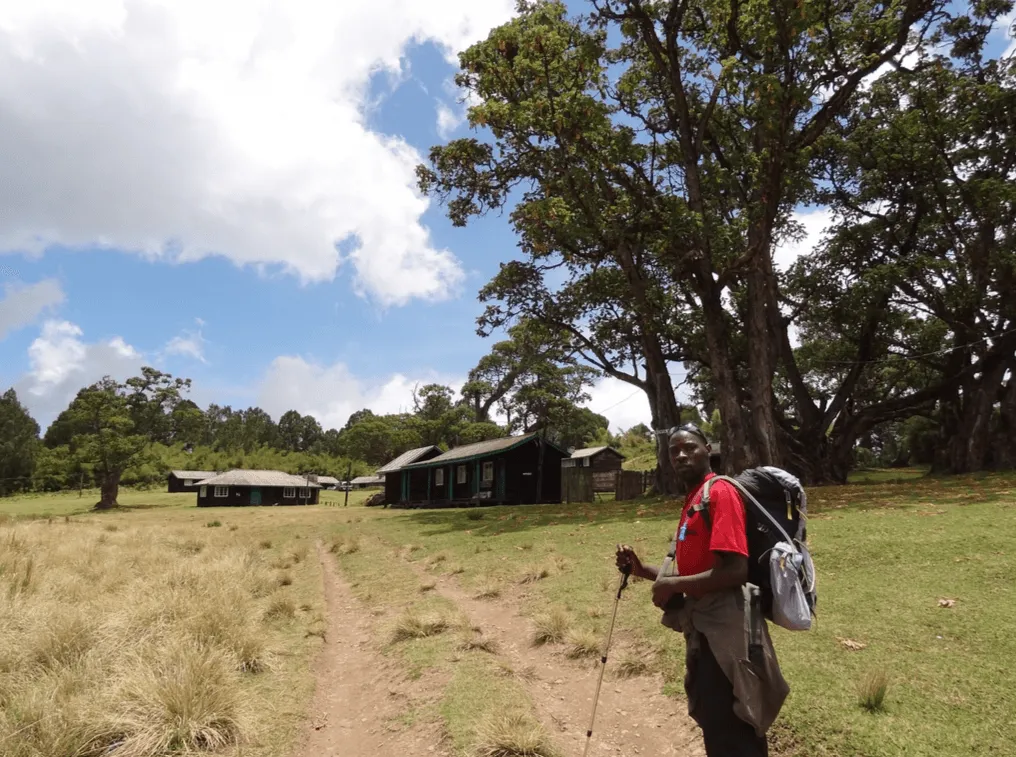
Meru Mount Kenya Bandas - Lake Ellis Campsite
Lake ellis campsite.

Lake Ellis Campsite - Minto's Camp
Minto's camp.
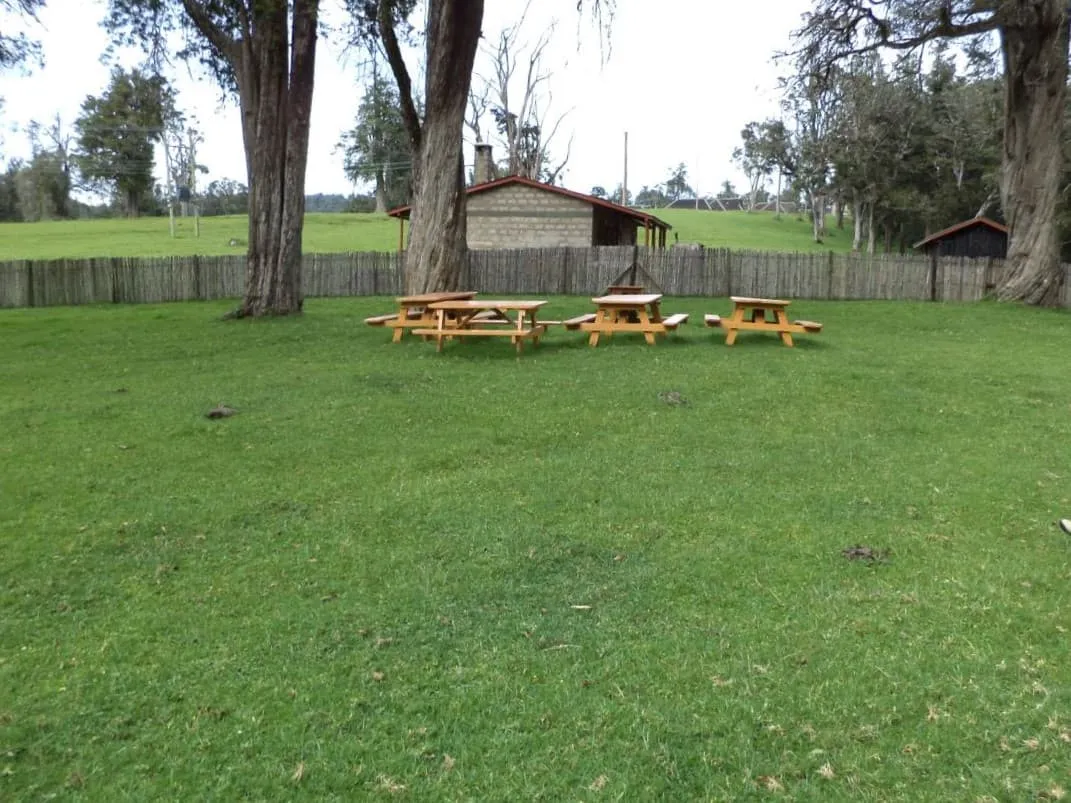
Minto`s - Pt Lenana - Judmiere Camp
Judmaier camp.
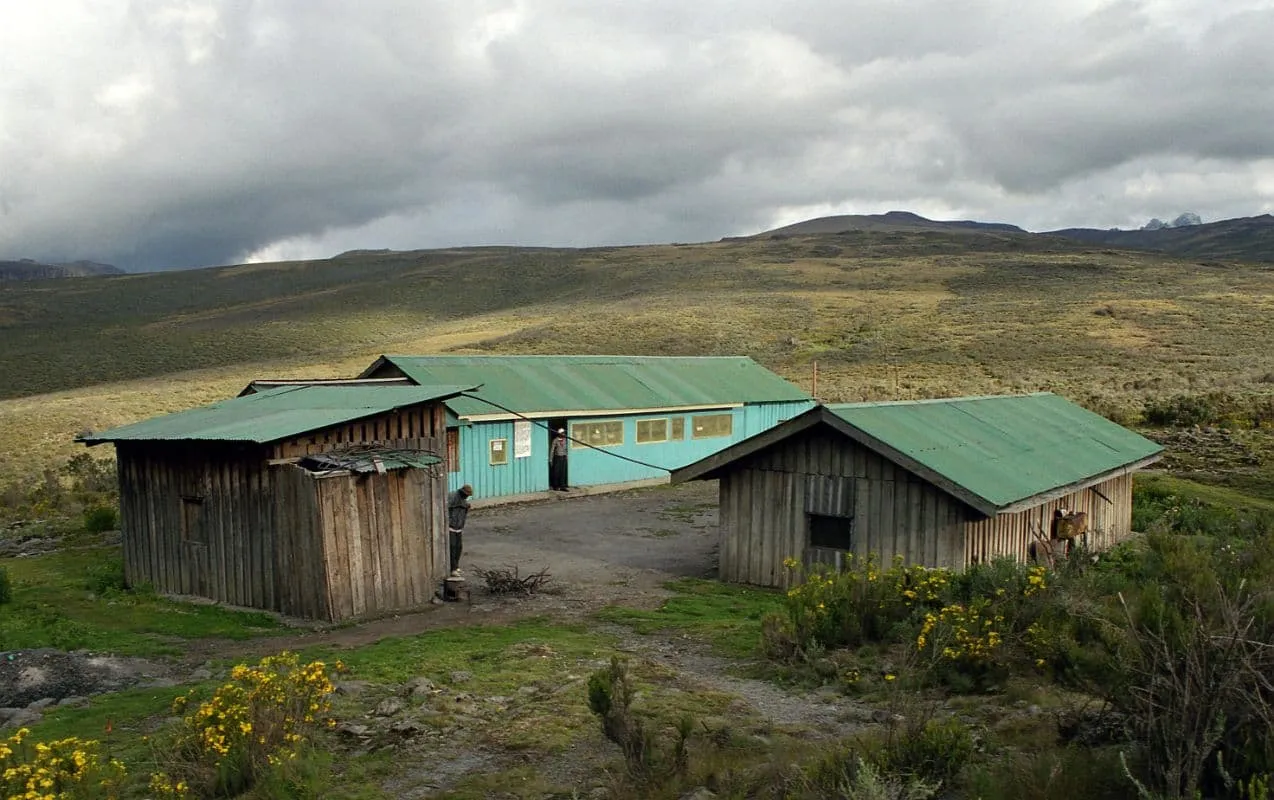
Judmiere Camp – Nairobi
If you are wondering about how to train for your Mount Kenya trek, you can use these five steps to become the best version of yourself. Fitness is not as important as the right acclimatization, but it can definitely make things easier and help you on your way to Point Lenana.
Aerobic fitness
You best get moving as soon as you have your mind set on your Mt Kenya climb. With the right aerobic fitness, you will have an improved heart rate, healthy muscles, and great lung capacity. Do power walking, running, hiking, trekking, cycling and/or swimming. Don’t worry. you don’t need to train for a marathon. One hour, 3 to 4 times a week is plenty of exercise.
When you are comfortable doing exercise a few times a week, you can fire it up by doing some longer sessions. The best thing you can do is walking long distances, at least once a week. If you can hike comfortably for a prolonged time, you are good to go.
Don’t use your backpack and shoes that you purchased for your Mt Kenya ascentfor the first time after your land. Break them in and use this equipment when you are working on points 1 and 2. Altitude: If you can, you can mimic the altitude by hiking and trekking in the hills and mountains. If you do not live in the right area for that, then don’t panic. The first two points are most important.
Know your body
This is perhaps the most important part. If you are questioning your physical capabilities, you should perhaps go see a professional for monitoring. It is important to know your body, so you can notice any warning signs when you are on your way to Point Lenana.
As there is different trekking routes on Mount Kenya, there are different options and prices as well. You can climb Mt Kenya in as little as 4 days but you can also do a traverse and spend 6 days on the mountain. 4 to 5 days on the mountain, regardless of which route you choose can cost between 600 and 700 EUR or 700 and 800 USD. If you are interested in doing the Burguret - Chogoria Traverse, for example, you can expect to pay about 975 EUR or 1080 USD.
In the mountaineering and trekking industry, it is common to tip your guide and other support staff after you have safely descended. And why not? If it wasn't for them, you might not have submitted and they are there to keep you safe. Just as when you are trekking in Nepal or when you are climbing Kilimanjaro or Mount Meru, it is expected to give your guide and porters a tip. It is normal to tip about 8 to 12% of the total trekking price. The tips will be split among your staff.
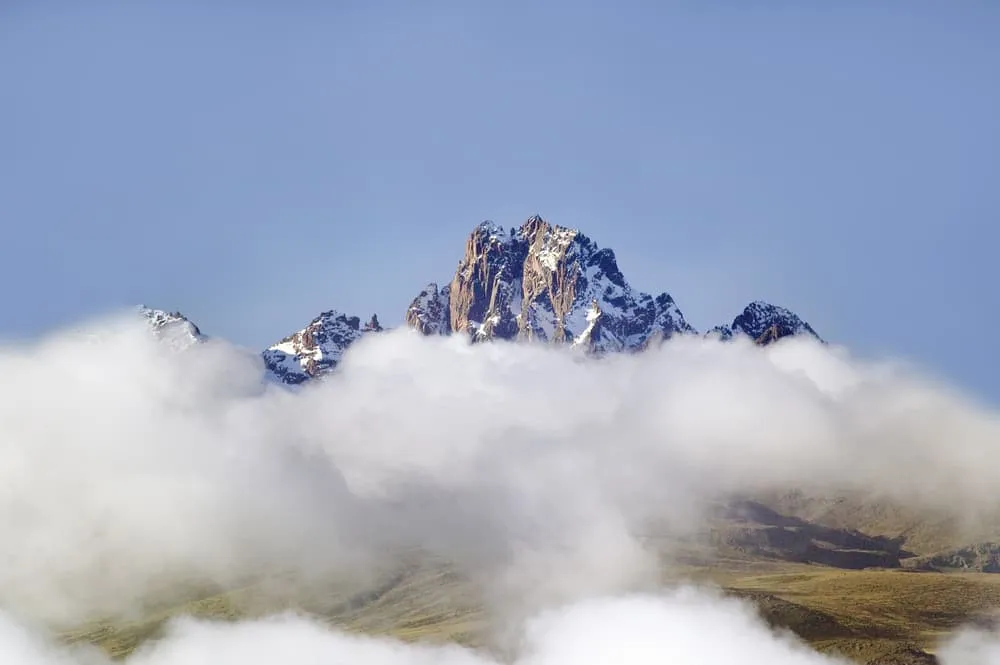
Not sure yet or want to discuss your plans for the Mount Kenya with one of our trekking experts? Get in touch today and turn your dreams into memories!
Here below you can find a Komoot map that shows some of the different alternatives available in the Mt. Kenya National Park.
It's essential to understand that altitude sickness can affect anyone, regardless of age, fitness level, or previous high-altitude experience. These days there are several tools to monitor your health at altitude. A widely-used (analog) method is the Lake Louise score card. It ticks the altitude symptoms while keeping the severity in mind. It’s a common tool used by guides. Nowadays, most trekking and mountain guides bring a blood oxygen saturation meter, which also measures the heart rate. These are key indicators whether a person adapts to altitude well or not. AMS can occur when trekking the Mount Kenya. Below you can find everything you need to know about altitude sickness.
Acute Mountain Sickness (AMS)
Altitude sickness, also known as Acute Mountain Sickness (AMS) is a health condition that occurs when someone is exposed to low levels of oxygen at higher altitudes. AMS is a serious condition and as the name suggests acute. It needs to be dealt with immediately, as it is potentially life-threatening. Most people will experience some mild symptoms of altitude sickness. It’s important to be aware of these symptoms and act before symptoms become more severe. Below we break down the different forms of AMS and how you can reduce the risk of getting it.
AMS symptoms
It is key to know how to identify altitude illness. You may experience the following symptoms due to the jump in altitude: headache, lack of appetite, breathing difficulties, insomnia, nausea and vomiting. The intensity and severity of these symptoms may increase with altitude and an overall feeling of fatigue will take all your joy away. This may further deteriorate to one of these life-threatening conditions.
High Altitude Pulmonary Edema (HAPE) : HAPE is a condition in which fluid accumulates in the lungs, making it difficult to breathe. Symptoms may include shortness of breath, a persistent cough, chest tightness, and an increased heart rate. It can be a life-threatening condition and requires immediate descent to lower altitudes and, in severe cases, medical treatment.
High Altitude Cerebral Edema (HACE) : HACE is a more serious condition in which fluid accumulates in the brain. Symptoms may include severe headaches, confusion, loss of coordination, and altered mental status. HACE is also a medical emergency and requires immediate descent and medical attention. Below 7 ways of minimizing the risk of AMS:
1. Gradual Ascent
One of the most effective ways to prevent AMS is to ascend gradually. When traveling to high altitudes, try to take several days to acclimatize before going higher. This allows your body to adapt to the reduced oxygen levels. All our treks in Nepal keep sufficient acclimatization into account.
2. Stay Hydrated
Dehydration can increase the risk of AMS, so drink plenty of fluids. Avoid excessive alcohol and caffeine consumption, as they can contribute to dehydration.
Consume a balanced diet with adequate carbohydrates and avoid heavy, fatty meals. Carbohydrates can help your body utilize oxygen more efficiently at high altitudes.
4. Medication
Some individuals may consider taking medication, such as acetazolamide (Diamox), to help prevent AMS. Consult with a healthcare professional before using any medication, and be aware of potential side effects.
Ensure you get enough sleep and rest during your ascent. Fatigue can increase the risk of AMS.
6. Avoid Overexertion
Pace yourself and avoid overexertion. Listen to your body, and if you experience symptoms of AMS, rest or descend to a lower altitude.
7. Descend if Symptoms Persist
If you experience symptoms of AMS, such as headache, nausea, dizziness, or difficulty breathing, it's crucial to descend to a lower altitude. Symptoms should not be ignored or dismissed.
At Bookatrekking.com you can book this trek and many others. Our guided options come with experts on the ground, and offer you a convenient, stress-free, safe, and educational way to explore the outdoors. Find our offers here . Our easy-to-use platform allows you to browse and compare different trekking options and find the perfect fit for your interests, abilities, and budget.
If you have any questions about a specific trek or need help choosing the right one for you, our team of trekking experts is here to assist you. Simply reach out to us and we will be happy to provide you with personalized recommendations and advice to help you plan the trekking adventure of a lifetime.
Is this not your cup of tea and are you looking for other epic adventures? Check out one of our blog posts:
Summit climbs
- Climbing Kilimanjaro
- Climbing Triglav
- Climbing Island Peak in Nepal
- Climbing Mount Kenya
- Climbing Mount Elbrus
- Climbing Mount Kinabalu
- Climbing Toubkal
- Climbing Rinjani
- Everest Base Camp Trek
- Annapurna Circuit Trek
- Nepal Travel Guide
- Salkantay Trek
- Peru Travel Guide
Kilimanjaro
- Machame Route
- Lemosho Route
- Kili Travel Guide
Self-guided treks
- Tour du Mont Blanc
- West Highland Way
- Camino de Santiago

Also Interesting
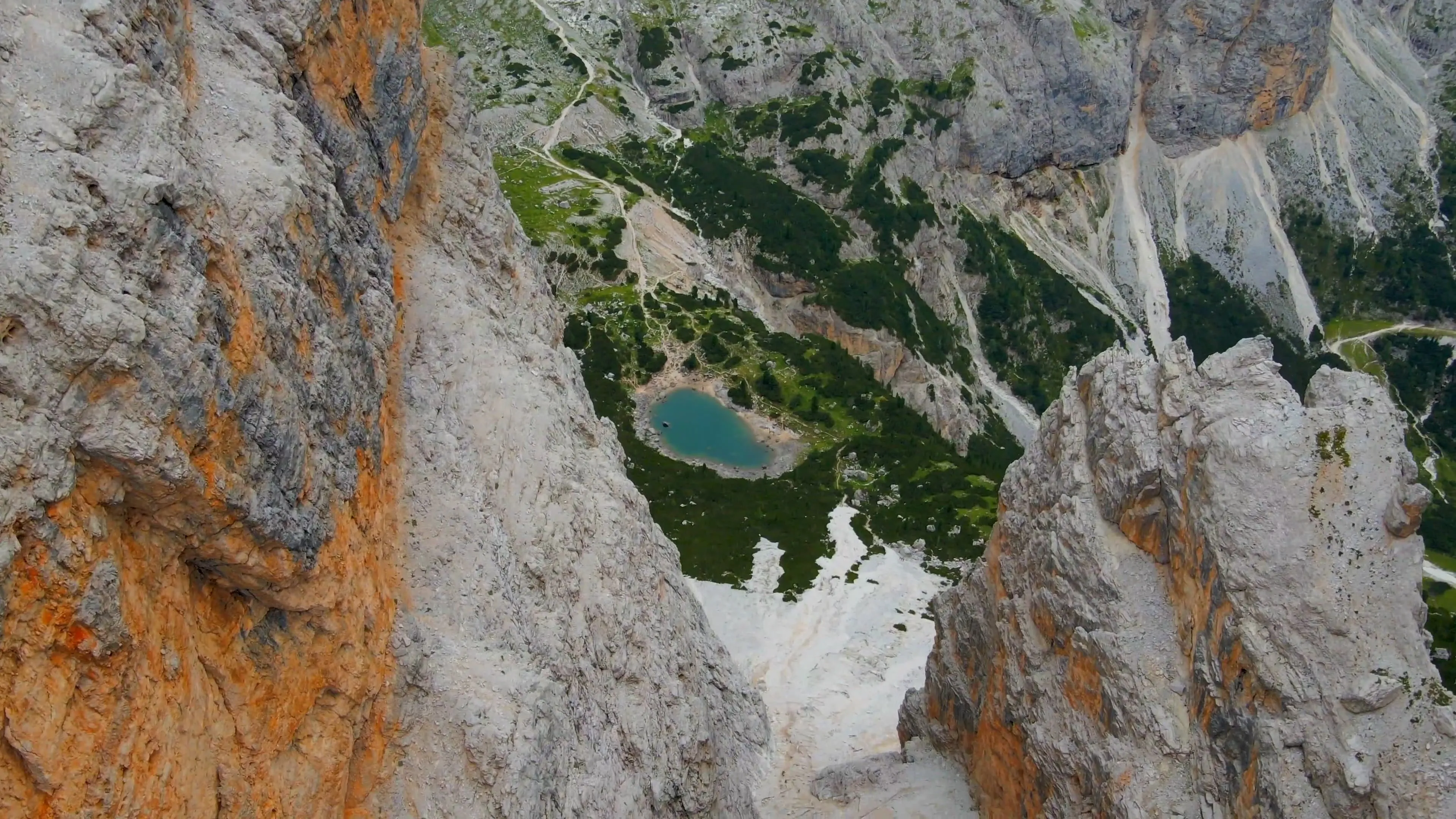
Alta Via 1: Map, Difficulty, and Route on the Italian Dolomites
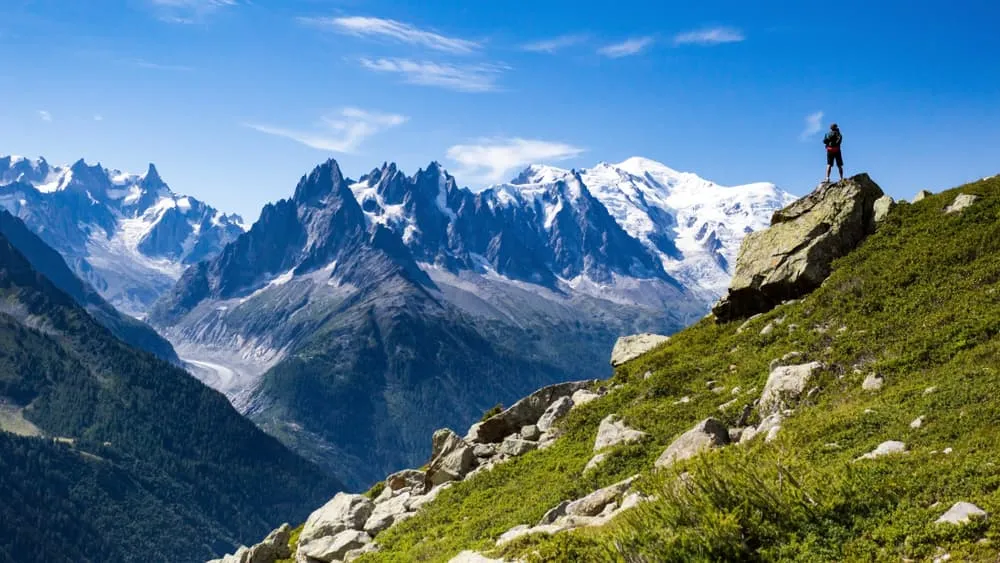
Tour du Mont Blanc: All You Need To Know
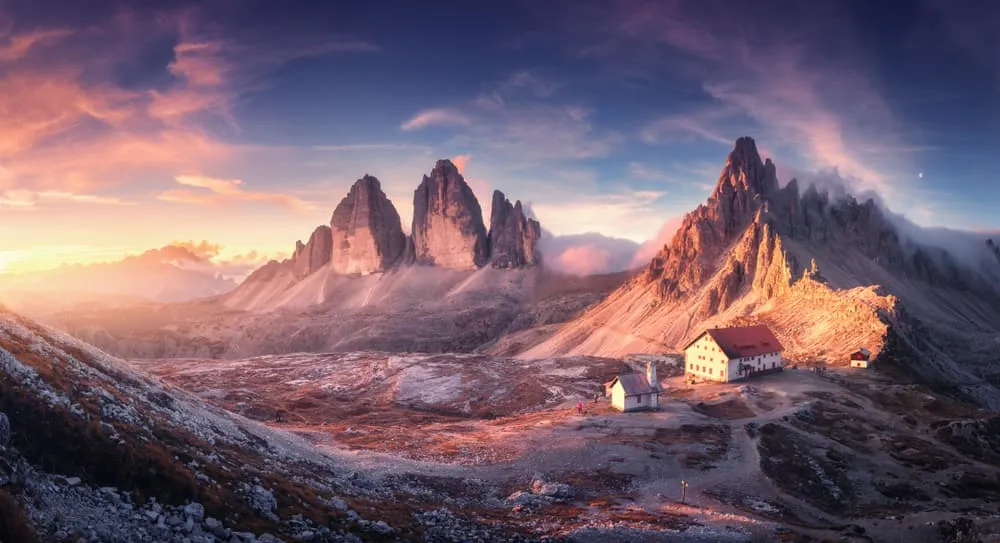
Dolomites Hiking: The 8 Best Options for Hiking Hut-to-Hut in Italy
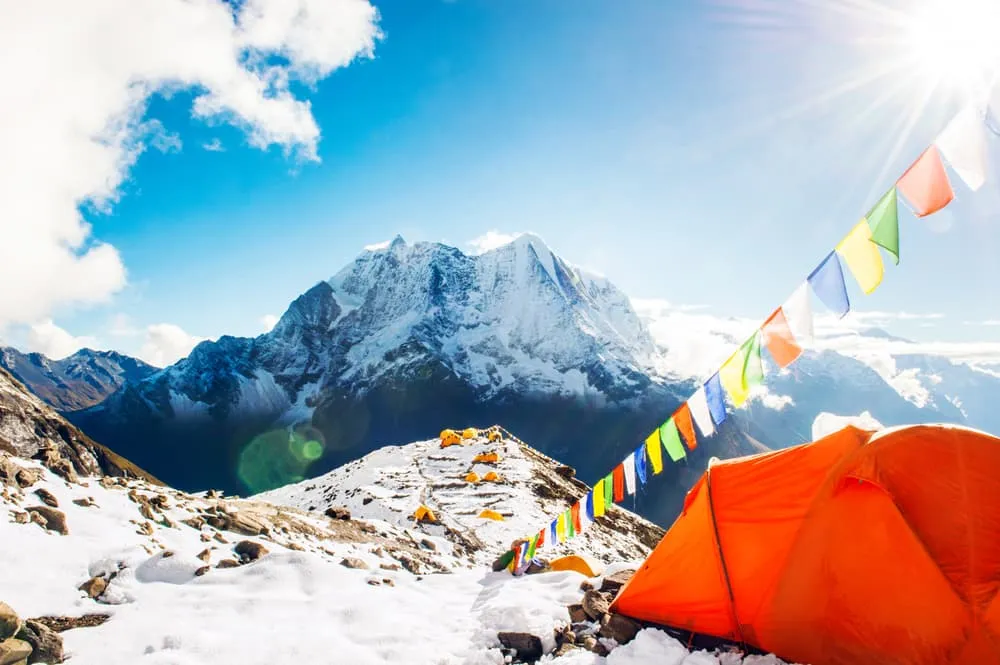
Everest Base Camp: A Trek to The Roof of The World
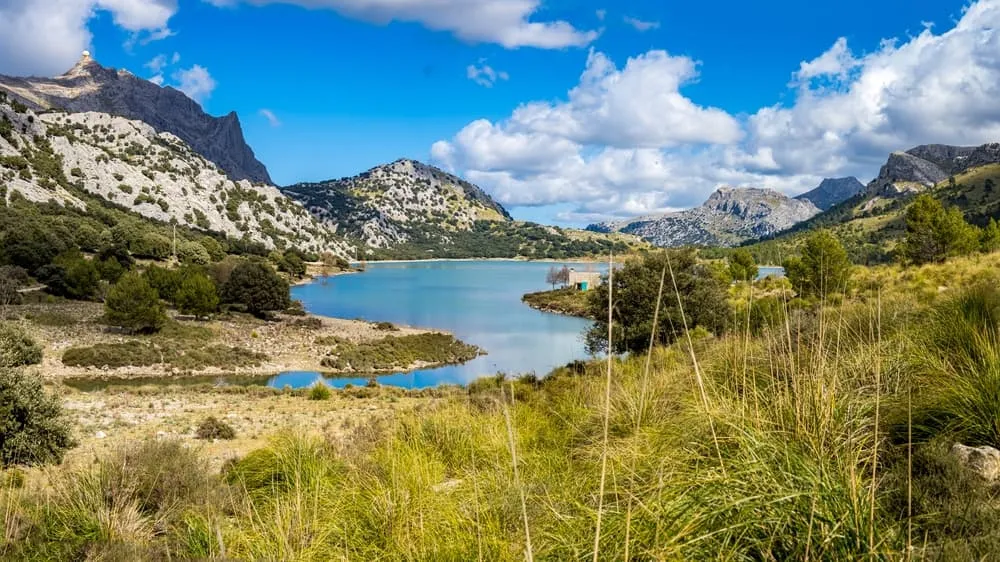
Hiking the GR221 in Mallorca: Everything You Need to Know
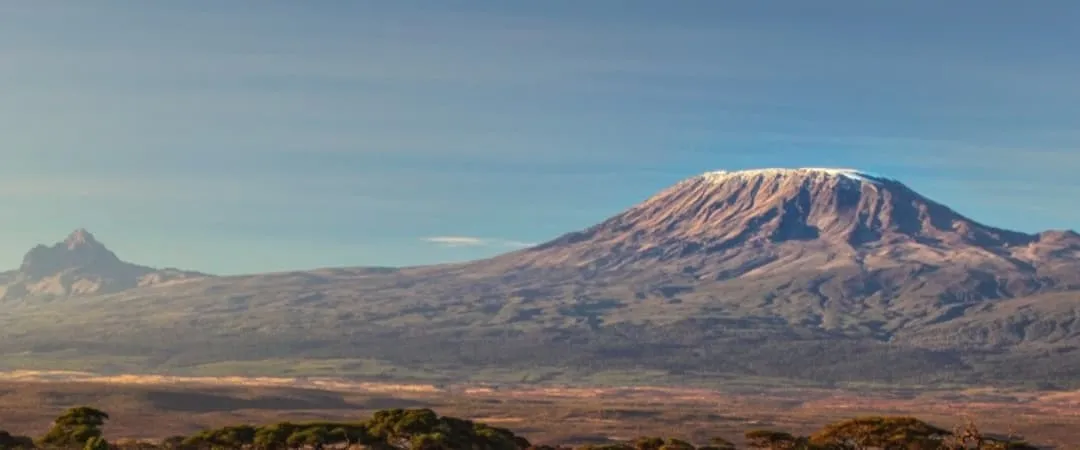
Climbing Kilimanjaro: All You Need To Know For Your Climb
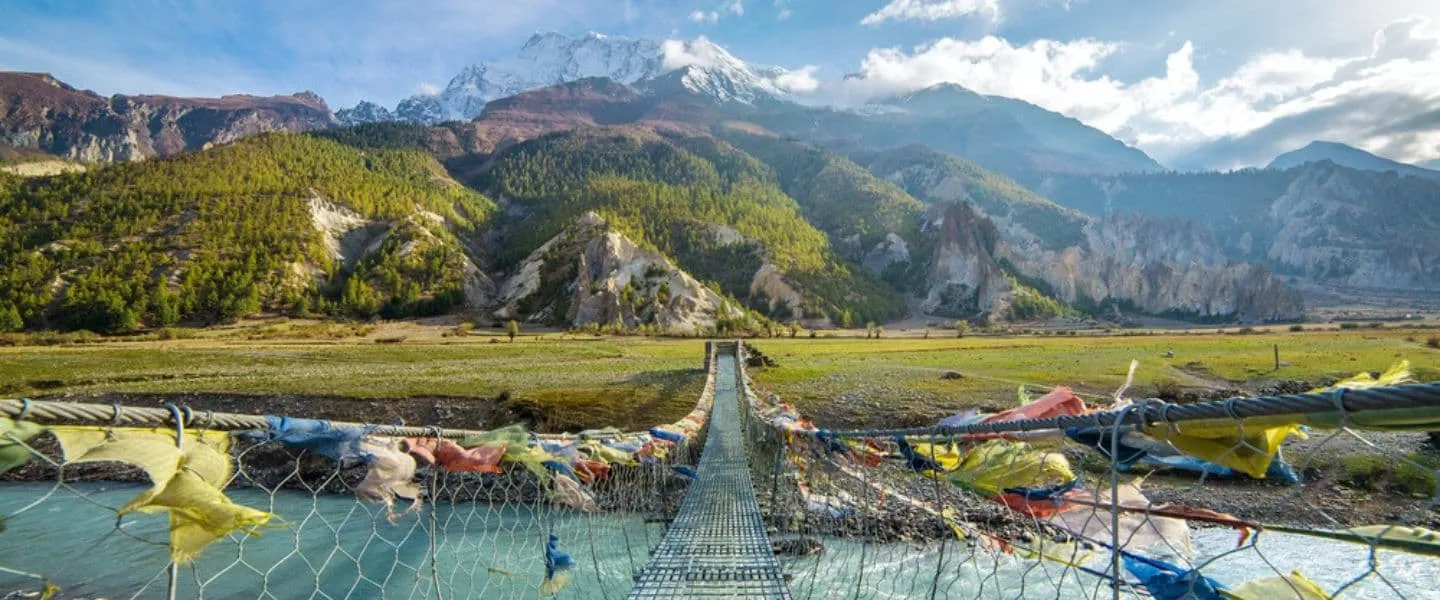
Annapurna Circuit Trek: How to Hike Around the Annapurnas
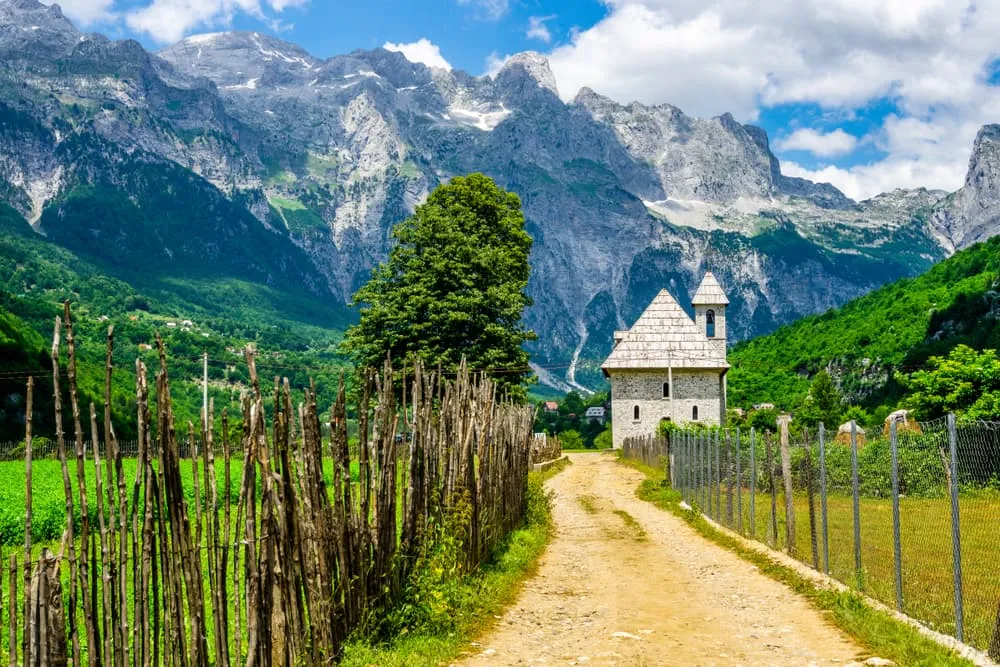
Peaks of the Balkans Trail: All You Need to Know

Hut-to-Hut Hiking in the Pyrenees: The 4 Best Walks
Get weekly inspiration with the best treks.

Covid Policy

MT Kenya Trek
Mt Kenya has many sides offering both the climber and the trekker plenty of routes and options to gain the summits. Point Lenana is the mountains trekking summit. A wonderful journey to its lofty 4995 meter summit. A walk through the lush forests to the moorland and on into the Alpine terrain on the high summits. We take the Chogoria route past beautiful high lakes and up to the summit via one the last remaining glaciers on the equator. Descending via the Siromon route.
We deliver a guided climbing journey to both summits with a ratio of one guide to two climbers. From Shiptons camp we take the regular route involving superb climbing to the summit followed by multiple abseils back to the bottom. This is a catered and trip with all logistics in country provided for in the course.
As part of this package to ensure the best success in Kenya a trekking weekend in the UK. Based in the Scottish Highlands we have a two day trip ticking classics such as CMD arête on Ben Nevis to get us moving well on mountain terrain. We also have an evening lecture on Mt Kenya and discuss kit and equipment that would be needed on the trip.
Please get in touch for further details and to discuss this further. Contact
Africa Home

Maximumum 1 instructor to 12 cl ients
£4500 for one person
We offer a 20 % discount to NHS Staff, Police, Military and Students
This cost is inclusive of all costs from arrival to departure from Nairobi Airport.
Excluding Flights


Trek Mt Kenya Sirimon - Naro Moru Route
Masai mara safaris, tanzania safaris, uganda tours.
KENYA SAFARIS - Mount Kenya Climbing Safaris
Sirimon - Naro Moru Route Trek Mt Kenya
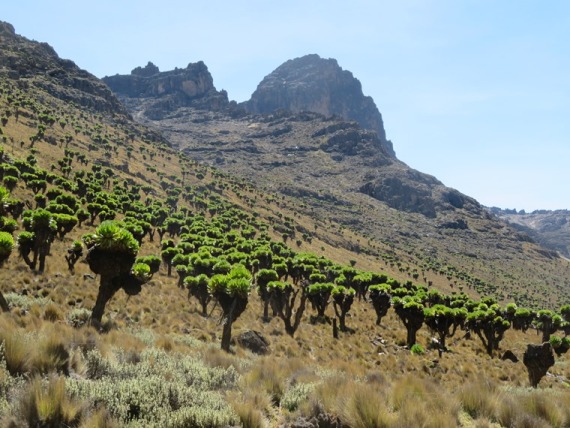
Day 6: Met Station | Naro Moru Gate, 9km, 3hrs| Nairobi After breakfast, hiking descent through the rainforest which is 9km to Mount Kenya National Park's Naro Moru Gate at 2,600m. Here, you will connect with your transport back to Nairobi arriving at approximately 3pm, B, L. Tour cost: US$ 980 per person Included in the price: • Guarantee price/guarantee trek on confirmation • Transfer to and from the base of the mountain • Full board accommodation whilst on the trek. • Meal plan as detailed: B=Breakfast, L=Lunch and D=Dinner • Accommodations in camps/huts as per the itinerary • All park entrance fees to include government taxes • Service of an English speaking professional guide, porters and skilled cook • Start and finish Nairobi • Treated water on the trek • On completion, successful Mount Kenya Climbing Expeditions certificate Excluded: • Laundry, tips, sleeping bags, drinks, accommodation before the trek and climbing gears • International flights • Visas to Kenya • Items of personal nature • Any other extras not detailed in the above itinerary

Sirimon Route, Naromoru Route Trek Mt Kenya, Mount Kenya climbing Sirimon route/Naro Moru, Mount Kenya Trekking, Climbing Mount Kenya, Mount Kenya Hiking, Mt Kenya trekking .

Sirimon Route, Naromoru Route Trek Mt Kenya, Mount Kenya climbing Sirimon route/Naro Moru, Mount Kenya Trekking, Climbing Mount Kenya, Mount Kenya Hiking, Mt Kenya trekking

Use the form below to contact us directly.
Please complete all required fields.
Booking details
Submit booking, confirmation, booking info.
First name:
Special requirements:
Total price:
We wish you a pleasant trip your Primate Safari Experiences LTD team
Climbing 3 Highest Mountains in Africa
Climbing 3 Highest Mountains in Africa; Mt Kilimanjaro, Mt Kenya and Mt. Stanley on 20 Days Mountaineering expedition journey covering Volcanic mountain , Snow Capped Mountains and Mountain Gorilla trekking in Bwindi impenetrable national park or Mgahinga National Park.
Africa is best renowned for Wildlife & Primate Watching in the wilderness of Virunga Mountains , but it also boasts its share of enchanted, high-altitude mountains that should be at the top of every hiker's bucket list and these mountains are the 3 highest mountains in Africa , that is Mount Kenya , Mount Kilimanjaro , Mount Stanley.
Take an expeditious adventure to explore and summit all the 3 highest peaks in East Africa and in African in general with the leading Mountaineering operator. You will start with the highest peak of Kilimanjaro ( Kibo Peak ) Mount Kenya ( Batian, Nelion and Point Lenana) and Rwenzori Mountains ( Magherita Peak ).
Trip Summary 20 Days Mount Kilimanjaro , Kenya & Rwenzori Climbing
Day 1: Marangu Gate to Mandara Hut (Elevation (ft): 6,046 ft to 8,858 ft) Day 2: Mandara Hut to Horombo Hut (Elevation Day 3: Horombo Hut to Mawenzi Hut to Horombo Hut Day 4: Horombo Hut to Kibo Hut Day 5: Kibo Hut to Uhuru Point to Horombo Hut Day 6: Horombo Hut to Marangu Gate Day 7: Nairobi- Mt Kenya Bandas Day 8: Mt Kenya Bandas - Lake Ellis Campsite Day 9: Lake Ellis - Minto`s Camp. Day 10: Minto`s - Pt Lenana ( 4,985m)- Liki North camp. Day 11: Liki North camp - Nairobi Day 12. Transfer to Rwenzori Mountains National Park. Day 13. Nyakalengija (1600m) to John matte hut (3420m) Day14. John matte to Elena hut (4563m) Day 15. Elena to Bujuku camp (3930m) Day 16. Bujuku to Nyabitaba hut (2660m) Day 17. Nyabitaba back to Nyakalengija Day 18: Transfer to Bwindi Impenetrable National Park Day 19: Gorilla Trekking in Bwindi Impenetrable National Park Day 20: Transfer to Kigali for flight back home.
This is a luxury adventure that is recommended to experienced Mountaineering that have been mountaineering in the world. 20 Days East Africa Mountaineering tours starts in Tanzania Arusha and ends in Entebbe Uganda after the summit to Mount Stanley with extension to relaxation in the Mountain gorilla watching in Bwindi Impenetrable National Park.

Facts about Climbing Routes

Chogoria Route: is the best route that Rwenzori expeditions recommends to travelers since it has registered high success in summiting to the peak from the eastern side of mount Kenya having been open since 1920s. The trail begins from chogoria town as the route name suggests which is about 96km from Embu and 64km from Meru.
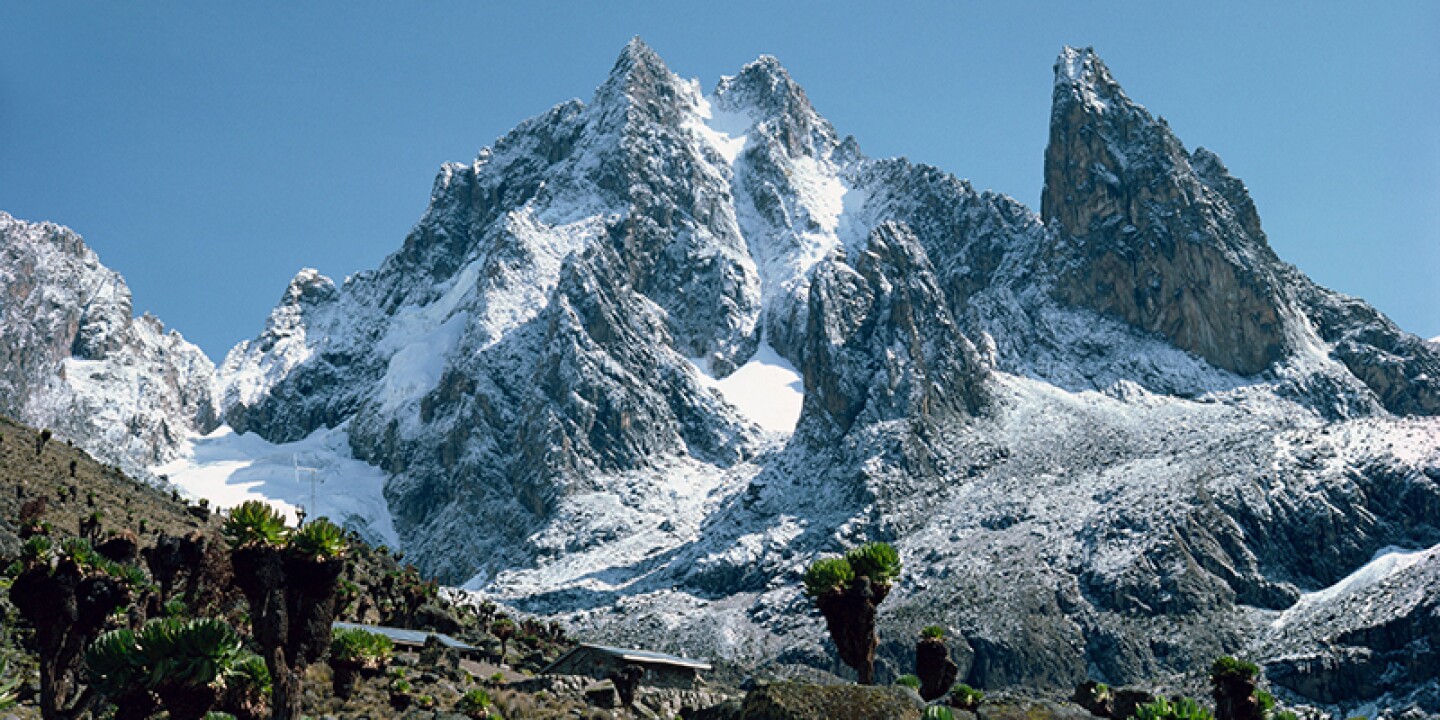
Camping is possible at the road head and water is available from a stream that passes by Mintos Hut (4,300m) is an excellently sited hut on the plateau overlooking Lake Michaelson 300m below. Spectacular views can be sighted at the Nithi George, by walking ten minutes south-east of the Mintos hut to the edge of the “Temple.” From Hall Tarn, the trail continues to the Austria Hut (4,790m) via square Tarn and the Tooth Col, then round the head of the Hobley Valley. Alternatively, Shipton’s Camp (4,200m) may be reached (3 hours), via Simba Col. Drop down towards lower Simba Tarn and turn left to Shipton’s Camp.
- Mount Kilimanjaro Climbing
- Mount Kenya Trekking
- Rwenzori Mountains Hikes
- Mountain Gorilla Watching
Key Points to Summit
Name: Kilimanjaro Elevation: 19,341 feet (5,895 meters) Mountain Range: Kilimanjaro Mountain Range Country: Tanzania Difficulty of Ascent: Rated as Walk-Up
Name: Kenya Elevation: 17,047 feet (5,199 meters) Mountain Range: Mount Kenya Mountain Range Country: Kenya Difficulty of Ascent: Rated as Technical Climb
Name: Stanley Elevation: 16,794 feet (5,119 meters) Mountain Range: Rwenzori Mountain Range Country: Democratic Republic of Congo and Uganda Difficulty of Ascent: Rated as Scramble
Preparation & Arrival in Tanzania.
Our Local Tanzanian Operator will meet your, brief you on your upcoming Kilimanjaro trek and do an equipment check to make sure you have all the necessary mountain gear. The missing gear can be rented on this day.
Day 1: Marangu Gate to Mandara Hut (Elevation (ft): 6,046 ft to 8,858 ft)
We head to the Marangu Gate for the necessary formalities before beginning our trek. The trail climbs through a tropical rain forest near the upper edge of the forest line, where we sometimes see playful blue monkeys. The trail then widens to expose beautiful hillsides until we reach Mandara Hut.
Hut: Mandara Hut.
Day 2: Mandara Hut to Horombo Hut (Elevation (ft): 8,858 ft to 12,205 ft)
Our second day on the trail begins with a steep ascent through the forest and opens into high moorland. If the sky is clear, we may get our first views of Kibo and Mawenzi peaks, two of the three volcanic peaks that make up the summit of Kilimanjaro.
Habitat: Heath / Moorland
Day 3: Horombo Hut to Mawenzi Hut to Horombo Hut (Elevation (ft): 12,205 ft to 14,160 ft to 12,205 ft)
This extra day is used for acclimatization. We hike towards or all the way to Mawenzi Hut and back. The unique landscape offers motivating views of Kibo and Mawenzi.
Habitat: Heath
Day 4: Horombo Hut to Kibo Hut (Elevation (ft): 12,205 ft to 15,430 ft)
Today we climb gradually, then cross the lunar desert of the “Saddle” between Mawenzi and Kibo to reach our campsite which sits at the bottom of the Kibo crater wall. Once at camp we rest, enjoy an early dinner and prepare for summit day.
Habitat: Alpine Desert
Day 5: Kibo Hut to Uhuru Point to Horombo Hut (Elevation (ft): 15,430 ft to 19,341 ft to 12,205 ft)
We wake in the middle of the night and begin the final push to reach the Roof of Africa. The trail to Gilman’s Point is very steep and the ascent will be slow and steady. From Gilman’s, it is a traverse along the crater rim to Uhuru Peak. We stay at the summit for a short time, to take photos and enjoy the views, before retracing our steps to all the way back to Horombo Hut.
Habitat: Arctic
Day 6: Horombo Hut to Marangu Gate (Elevation (ft): 12,205 ft to 6,046 ft)
A long trek is in store for today, however it is mostly downhill. Once at the park headquarters at Marangu Gate we pick up our certificate that proves our achievement and catch our vehicle transfer to Kilimanjaro international Airport for the flight to Kenya for the next hike to the second highest mountain in Africa.
Day 7: Nairobi- Mt Kenya Bandas (2,900m) 3hrs, 10km walk, 650m ascent.
Depart from Nairobi at 0800hrs, driving through agricultural country up to Chogoria town for lunch. After lunch, we drive up to the edge of the bamboo forest where we start our trekking through the dense bamboo forest for a distance of 10 km to the Mt Kenya Bandas. Dinner and overnight at the Meru Mount Kenya Bandas.
Day 8: Mt Kenya Bandas - Lake Ellis Campsite ( 3,600m) 3hrs, 9km, 700m ascent.
After breakfast and sorting of porter loads, we set off up the mountain at a nice and easy pace. A slightly longer walk via Lake Ellis gives scenic views of Mugi, Ithanguni, and the Giants Billiards Table, whilst if we follow the river near road head, upstream for about 3 km, the foreground scenery and flora is particularly beautiful. Lunch on the banks of a stream, then it's time to cut up the left-hand hillside to our camp at about 3,600m, well away from any of the more "touristy" areas
Day 9: Lake Ellis - Minto`s Camp. ( 4,200m) 4 hrs, 12km, 600m ascent.
Similar early start. Again well off the beaten track to follow a ridge up the mountain for about 3 hours to eventually join the tourist track on the normal Chogoria route at an altitude of about 4,100m. Breath-taking views over the Gorges Valley and back over towards Ithanguni and the Northern Moorlands. Lunch is served at a small stream crossing, before continuing for a further hour to the Mintos Hut area at 4200m and our night's rest. The afternoon is spent relaxing at camp, though a 10-minute walk to the "Temple" is well worth the effort. This is a 150 meters vertical cliff that gets its name from the position visitors often adopt when peering over the edge - they look as if they are praying. An early night is recommended as you are attempting the summit the next day.
Day 10: Minto`s - Pt Lenana ( 4,985m)- Liki North camp. 8-9 hrs, 785 ascent, 1,085 descent, 19km,
Predawn attempt of the summit starts at 0300hrs and you hike for about three hours up to Point Lenana (4,985m), the hiker's summit, arriving there in time to watch the African sunrise. Descend to Shipton camp for breakfast. After breakfast, begin a 3-hour descent via Mackinder`s valley to the Liki North camp (3,900m). The descent is gentle and it offers ample time to enjoy fascinating scenery which includes the moorlands before reaching the camp. Dinner and overnight at Liki North camp.
Day 11: Liki North camp - Nairobi- 3 hrs.
After early morning breakfast, descend for 2-3 hours to Old Moses camp to catch a vehicle for transfer to Nairobi arriving late afternoon and take a connecting flight to Entebbe International Airport.
Day 12. Transfer to Rwenzori Mountains National Park.
After your morning breakfast, the company driver guide will be there to pick you up to transfer you to the Mountains of the Moon in western Uganda with en route lunch in Fort portal. Upon reaching the area, you will check in the lodge and spend a night relaxing as your first day trekking awaits you. Dinner and overnight stay at Snow Heights Lodge.
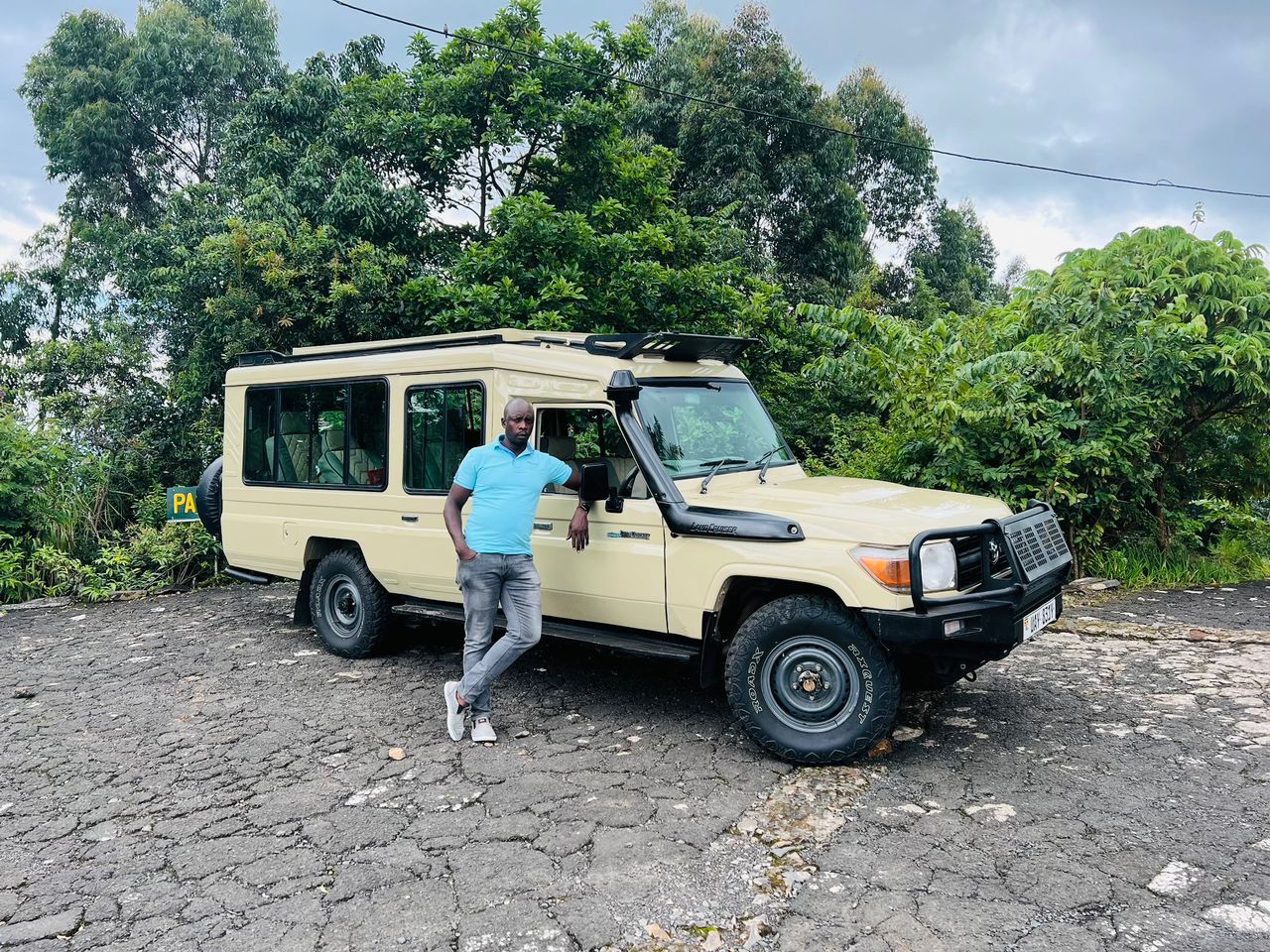
Day 13. Nyakalengija (1600m) to John matte hut (3420m)
You will go to Rwenzori Mountains National Park offices in Nyakalengija where you will be briefed and then pick your hiking equipment. The guides and porters will be ready and you will start the hike passing through the local settlements, tropical forests, montane forests, bamboo forest and part of the alpine. As you hike, you will have a stopover at Nyabitaba hut for lunch and then proceed through the Kurt Schaffer Bridge which is at the conference of Mubuku and Bujuku Rivers. You will then reach john matte where you will have dinner and spend the night.
Day14. John matte to Elena hut (4563m)
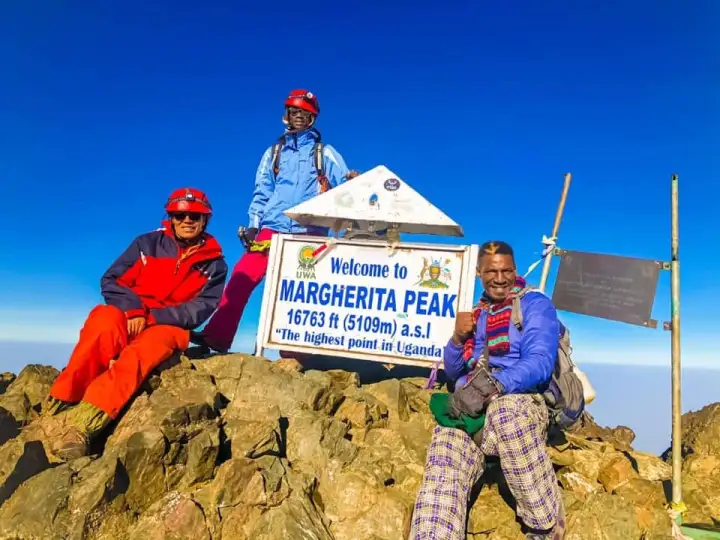
Day 15. Elena to Bujuku camp (3930m) – Hiking to the top
On this day you will start the hike at around 2am, get ready with your hiking gear and headlamps, you will hike through the rocky area, and you will use the ropes as you hike on some spots to the Stanley glacier. You will need your crampons. After the Stanley glacier, you will remove the crampons and continue with the hike through the rocks to the Margherita glacier. The hike through the Margherita glacier will lead you to Margherita peak which is the highest point of the Rwenzori. You will then descend back to Elena hut where you will rest and have lunch. And then continue to descend to Bujuku hut where you will have dinner and spend the night.
Day 16. Bujuku to Nyabitaba hut (2660m)
After breakfast at Bujuku you will move through the upper bigo bog, continue descending through the lower bigo bog to john matte where you will rest and have lunch. You will then proceed to Nyabitaba hut where you will have dinner and spend the night.
Day 17. Nyabitaba back to Nyakalengija
After breakfast at Nyabitaba, you will descend back to Nyakalengija and head to Snow height lodge for overnight stay
Day 18: Transfer to Bwindi Impenetrable National Park
You will set off from Rwenzori Mountains National Park and start on the journey to connect to Bwindi Impenetrable National Park, the home to the mountain gorillas which hosts half of the world's mountain gorillas. The journey takes you 5 hours to connect to Bwindi where you will be checked in at your accommodation for relaxation.
The alternative destination for gorilla trekking is Mgahinga national park depending on availability of the Gorilla Permits, Sleep and dinner at Gorilla Forest Camp/ Ikoro Lodge.
Day 19: Gorilla Trekking in Bwindi Impenetrable National Park.
After Early Morning breakfast, you will head to the park office headquarters with packed lunch for an inevitable briefing ready to trek for the gorillas in the thick impenetrable forests. You get to spend an hour with the gorillas after having trekked for about 3-5 hours. If you are not so worn out in the evening, head for a brief nature walk to the Batwa community.
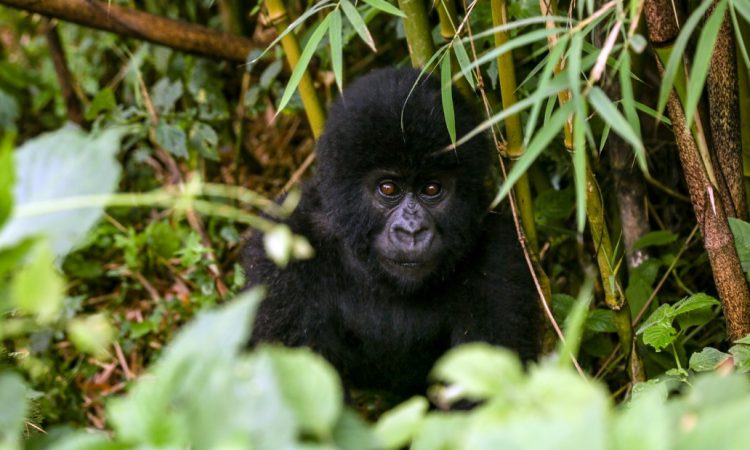
Day 20: Transfer to Kampala for flight back home.
You will have morning breakfast before starting on the journey to connect to Kampala which is 8 hours drive, you will have stop over at Equator for experiment and later proceed to Entebbe.
Includes & Excludes
- Kilimanjaro Hiking permit
- Mount Kenya Climbing Permit
- Rwenzori Mountaineering Permit
- Mountain Gorilla Trekking Permit
- Ground Transportation
- Porters and Rangers
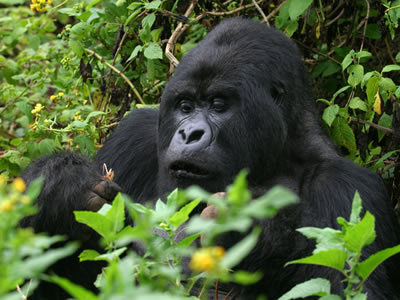
Bwindi Impenetrable National Park
Bwindi Impenetrable national park is located in south western Uganda with four gorilla trekking sector and holds half of the world's mountain gorillas? Go on gorilla safari afrer Climb to Rwenzori with us.
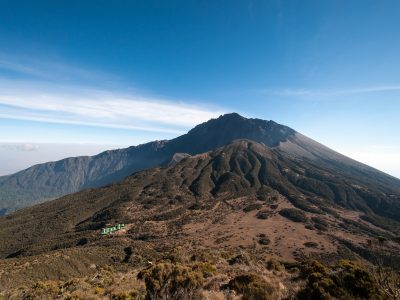
Mount Kenya
Dont miss to climb Mount Kenya with Extension to visiting Rwenzori mountains or Kilimanjaro Mountains on an East African Tailored Mountaineering tours staying in Luxury lodges. Mount Kenya national park is the most popular national park in the mighty Republic of Kenya.
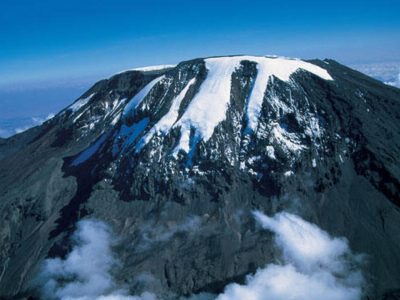
Mount Kilimanjaro National Park
Explore Kilimanjaro Mountains National Park on climbing adventure to Tanzania once combined with Rwenzori trekking tailored by the local experts in Mountaineering tours that have a decade in leading East Africa Safari tours at affordable rates from Rwenzori Expeditions.
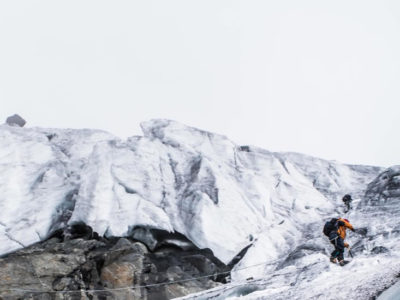
Mount Rwenzori National Park
Learn About Rwenzori Mountains national park that offers breathtaking views of of glaciers, snow caped mountains, lakes, waterfalls, where it is contiguous with Virunga National Park in Congo which offers great chances of gorilla trekking.
Rwenzori Mountain National park can be visited at any time of the year. June, July, August, September, October, December, January, February and March
Interested in Rwenzori Trek?Contact Halima
9 of the best hiking routes in Kenya

Mar 24, 2023 • 8 min read
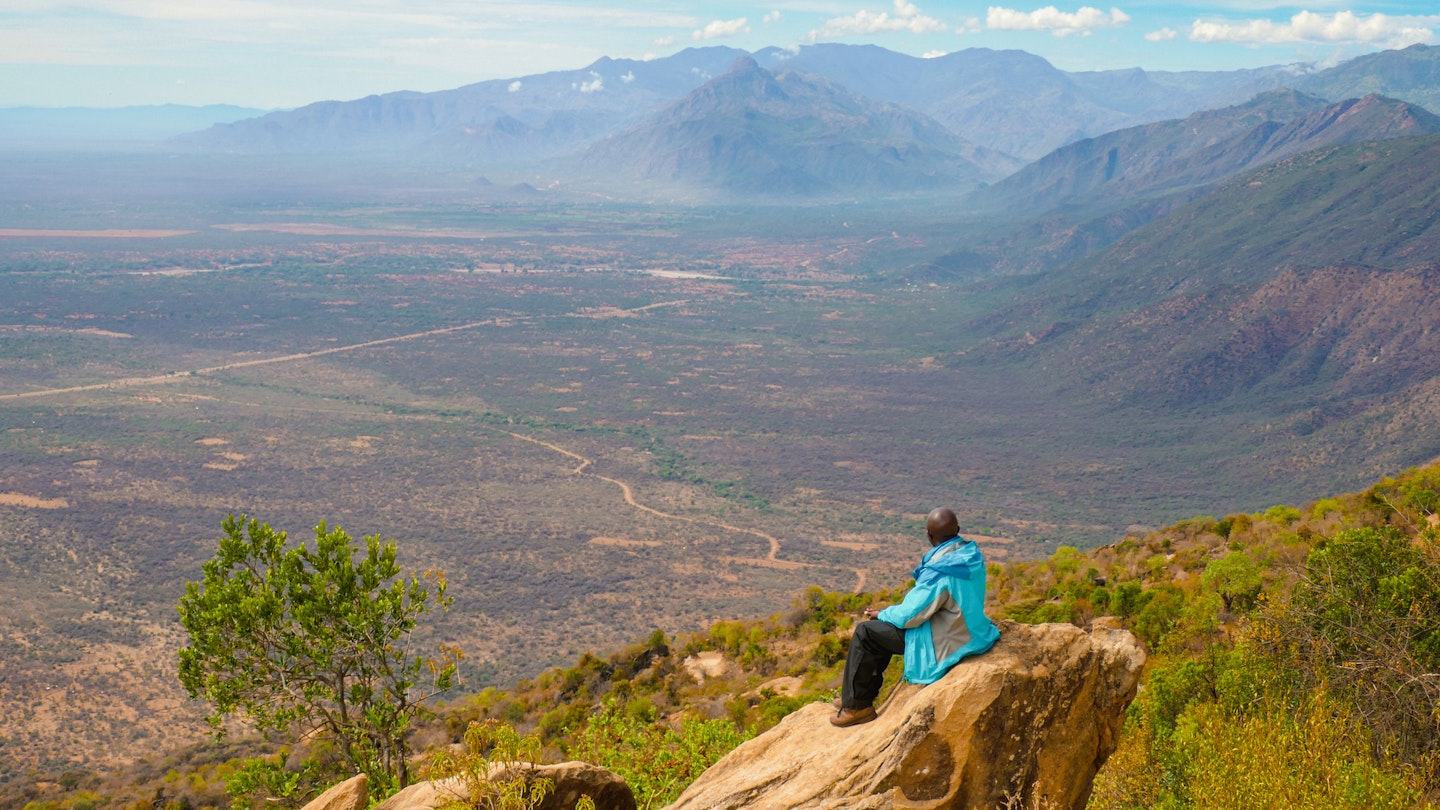
Walk through Kenya's varied landscapes on these top hiking routes © Martin Mwaura / Getty Images
Between spotting the Big Five on safari and lounging on the white-sand beaches , it’s easy to forget that Kenya has some superb hikes.
This country features spectacular scenery: you could be trekking through lush emerald-green forests or hiking along a crater ridge with views over a shimmering lake, spotting colobus monkeys scampering across the path, and taking in vast valleys, baobabs and acacia trees as the sun sets. Kenya’s trails aren’t just for hikers: they also attract birders, cyclists and runners.
From the country’s highest peak of Mt Kenya to the scenic, flat paths through Karura Forest on Nairobi ’s outskirts, Kenya has a variety of hikes, paths and trails to suit every level. None of the trails are so crowded that it’s an issue, and many offer genuine tranquility.
Community tourism is an integral part of Kenya’s travel landscape, and local guides offer insights into their culture, traditions and relationship with the land, which is as much a part of exploring the country’s diverse and fantastic trails as the walking itself. Guides are always available at national parks , and you can also ask your accommodations for recommendations.
Here are Kenya's best hiking routes.
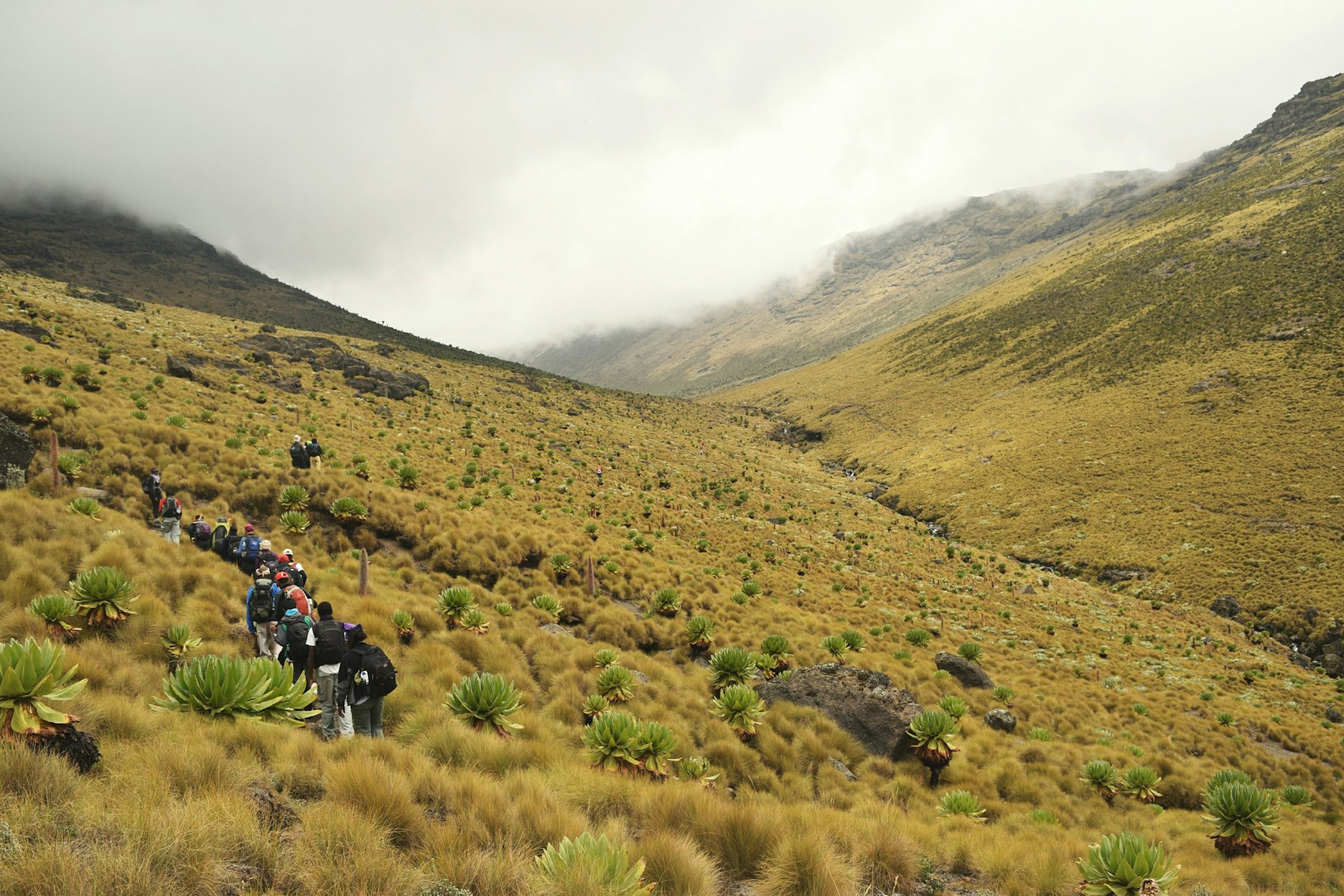
1. Mt Kenya
Best bucket list hike 70km (43 miles) round trip, 4–7 days, challenging
Mt Kenya’s X factor isn’t just that it’s Kenya’s highest peak (and the second-highest in Africa) – the scenery of Mt Kenya National Park is astonishing. Ridges and valleys fan out from the summit as you hike on Afro-Alpine moorland, home to flora such as giant lobelia trees and groundsel, and take in the views of the massif from the MacKinder Valley.
It’s a challenging but doable hike with the right support and guide. Point Lenana at 4985m (16,355ft) is the main trekking peak (the two highest peaks, Batian and Nelion, are more technical and not climbed as frequently). The three main routes to Point Lenana – Naro Moru to the west, Sirimon on the northwest and Chogoria (the driest route and the most scenic ascent) on the southeast – start in Mt Kenya National Park.
The park is well-staffed with rangers and guides, and huts and campgrounds are set up on the trails. A guide is strongly recommended: you can book one at the entrance/visitor center or in advance, through your accommodations or through word of mouth. A reasonable degree of fitness helps, and it's wise to allow time for altitude and acclimatization.
2. Mt Kenya–Met Station
Best one-day hike 20km (12.5 miles) round trip, 7 hours, moderate
Instead of spending days trekking up Mt Kenya, you can hike to the Met Station campsite at 3050m (10,000ft) altitude. It’s a great hike through forest and bamboo habitat, starting from the Naro Moru gate, with a steeper section kicking in about two hours into the trek at Percival’s Bridge. Look out for buffalo, elephants and colobus monkeys.
If you’re a fast walker or time is on your side, you can keep going for another hour or so into the Alpine habitat beyond the camp, the first campsite on this Naro Moru trail. It’s worth it for the views over the Alpine zone, across the savanna to the snow-capped peaks ahead, while classic flora such as lobelia and giant heather fills the foreground with color. There is a water supply en route, but walkers need to bring their own food.

3. Hell’s Gate National Park
Best hike for rock climbers 24km (15 miles) round trip, 7 hours, easy
Don’t be fooled by the name: Hell’s Gate National Park is a place of joy. After two volcanoes erupted, the volcanic rock formed a series of gullies, ridges and remarkable formations, giving one of Kenya’s smaller national parks a surreal and striking landscape.
The cliff face formed by the Rift Valley is popular with both beginner and experienced rock climbers, and you can go abseiling too. Fischer's Tower, a 23m-high (75ft) rock formation is a rock climber’s dream. This is classic Rift Valley scenery, formed after molten volcanic lava shot up through a crack in the earth. You can book expeditions through Climb BlueSky , a Nairobi-based rock climbing center.
The trail along Ol Njorowa Gorge is one of the best ways to explore the landscape of Hell’s Gate. Along the way, you’ll see the steamy plumes of hot water springs that feed into a stream on the bottom of the gorge.
4. Mt Elgon
Best hike for Kenya–Uganda views 56km (38 miles) round trip, 4 days, moderate
An extinct volcano on the border of Kenya and Uganda, Mt Elgon and its eponymous national park is renowned for mist and drizzle, but you'll be rewarded with scenes of rolling hills, caves created by ancient lava tubes, two gorges and hot spring lakes (mostly on the Uganda side). Best of all, it's relatively uncrowded and tranquil. One of Mt Elgon's best treks – the trail up to Koitoboss Peak at 4187m (13,700ft) – falls on the Kenya side with views over Uganda and Kenya.
Park fees include a guide and ranger (you can’t hike without a guide). Contact Kenya Wildlife Service before you arrive to arrange a local guide or book through a private travel company. The trail to Koitoboss Peak begins at the Rongai gate and steadily rises into the misty hills. If you’re lucky, you might spot a genet cat as you go.

5. Mt Longonot
Best day hike from Nairobi 10km (6 miles) round trip, 7 hours, challenging
A hike up Mt Longonot , a now-dormant volcano that last erupted in the 1800s, entails a stiff but scenic ascent through dense mountain forest before you reach the summit at 2276m (7500ft). Located in the Great Rift Valley southeast of Lake Naivasha and just an hour from Nairobi, Mt Longonot is one of Kenya’s best trekking trails.
It’s a steep 3.2km (2-mile) trail up to the rim of the crater – Longonot takes its name from the Maasai word for “steep ridges” – and doable in a day if you’re in good shape. Add on a couple of hours if you want to explore and walk around the crater at the summit. The 7.2km (4.5-mile) loop is well worth it for the panoramic view over the Rift Valley and Lake Naivasha, and you’ll often see birds of prey swooping into the scene.
6. Menengai Crater
Best hike for expansive views 10km (6 miles) round trip, 6 hours, challenging
An entire natural world has formed inside the caldera depression that’s been created at the Menengai Crater , the world’s largest surviving crater. It makes for a unique hike as you explore this ecosystem of wildflowers, grasslands and forest, and spot the geothermal plants that thrive in this landscape of geysers, hot springs and mud pots. You can also visit a cave that was a hideout for Mau Mau freedom fighters.
A ring of walls and hills circle the crater, around 600m (1968ft) from the base, while the summit lies at 2288m (7506ft). The views from the crater ridge over Lake Bogoria, Lake Nakuru and the Northern Rift Valley are wonderful as the water glimmers in the distance. From the viewpoint, take a steep hike down to the crater floor or head into the lush forest for sightings of dik-dik (small antelope), vervet monkeys, reedbuck and forest birds.

7. Masai Mara National Reserve
Best hike for wildlife Variable distances, 2 hours to full day, easy to moderate
While walking safaris aren’t hikes in the traditional sense, they offer a new way to experience the terrain of the Masai Mara versus the classic 4WD experience. You can't walk freely in such a wild environment – armed rangers ensure safety – but being on foot allows you to see animals such as zebras, antelopes and giraffes in a more intimate way.
The best way to walk here is with an indigenous Maasai guide: these traditional pastoral herders know their land intimately. Many conservancies are on private Maasai-owned land that has been earmarked for conservation, so lodges often have strong ties to local communities, and you can request a local guide. Tell the guide what types of wildlife and landscapes you want to see and learn about Maasai customs. At the Maasai-run Semadep Camp you can stay in a traditional village and walk with the warriors: an unforgettable experience.
8. Karura Forest
Best hike for families 5–15km (3–9 miles) round trip, 1–3 hours, easy
With waterfalls, a lake, Mau Mau fighter hideout caves, a forest cafe with animal sculptures and a small children’s playground, Karura Forest off Limuru Road is a much-loved oasis just on the outskirts of Nairobi. The forest has more than 50km (30 miles) of hiking trails, which are mostly flat and perfect for families.
The 9km (5.5-mile) trail takes in some of the key attractions, such as sections home to Sykes’ monkeys, Karura Waterfall and Lily Lake. Also in Karura forest are the Mau Mau caves, which housed fighters and their supplies during Kenya’s fight for independence from Britain between 1952 and 1960. Finish your visit with a drink or lunch on the terrace of the swish River Cafe where wildlife sightings over a shake and panini are not uncommon.
9. Loop trail, Nairobi Arboretum
Best accessible hike 2.5km (1.5 miles), 1 hour, easy
Nairobi Arboretum is just 3km (1.8 miles) from Nairobi’s city center, and short, flat paths make it an ideal spot for an accessible walk. Inside the 74-acre arboretum are more than 350 exotic and indigenous trees and more than 100 bird species. You’re pretty much guaranteed to see Vervet and Sykes’ monkeys. The walkways are paved, the route has plenty of seating and the facilities, including public toilets, are decent.
This article was first published September 2022 and updated March 2023
Explore related stories
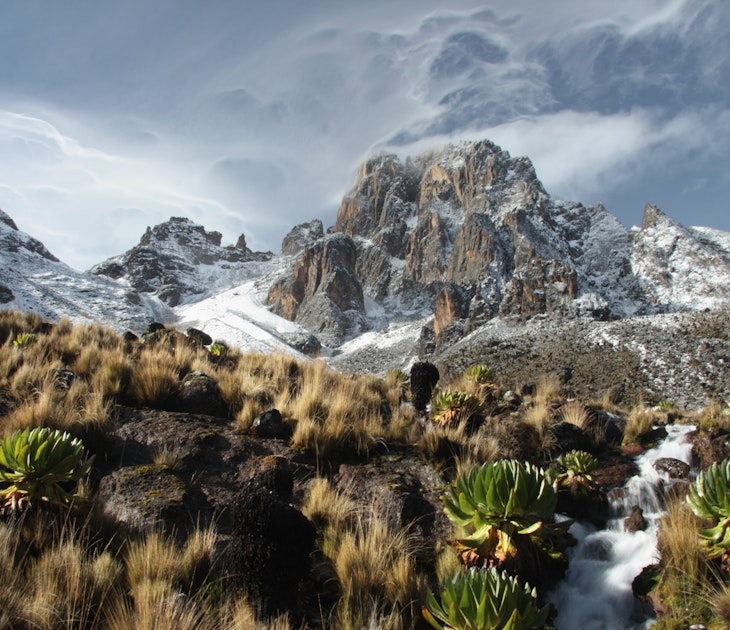
Jun 10, 2022 • 8 min read
Peter Elia headed to Mt Kenya in search of a less crowded alternative to Kilimanjaro, and found he had Africa's second-highest mountain almost to himself.

Feb 20, 2024 • 17 min read
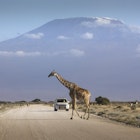
Dec 13, 2023 • 9 min read
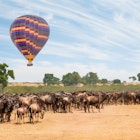
Nov 23, 2023 • 8 min read
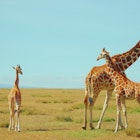
Aug 4, 2023 • 6 min read
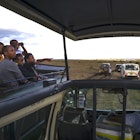
Apr 4, 2023 • 13 min read
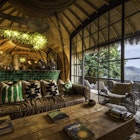
Jan 12, 2023 • 9 min read

Jan 2, 2023 • 12 min read
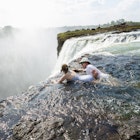
Oct 11, 2022 • 7 min read
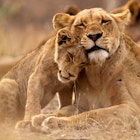
Sep 8, 2022 • 7 min read

How to Take a Self-Guided Hike up Mount Kenya
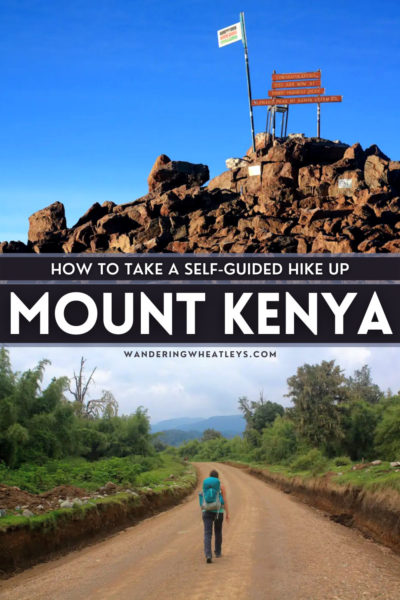
Mount Kenya is the second tallest mountain in Africa behind Kilimanjaro. As one of the main attractions, this volcanic mountain stands at 5,199 meters (17,057 feet), and it is a haven to hike up Mount Kenya for experienced trekkers and mountain climbers.
Most national parks in Kenya and in neighboring Tanzania are very expensive, but the national parks in Kenya do not require a guide when hiking, unlike parks in Tanzania. This makes a huge difference in the cost for those who are budget conscience. Hiking the tallest mountain in Africa is impressive, but you’ll need a guide to tackle Mount Kilimanjaro.
A hike up Mount Kenya is actually more challenging and many think it’s a more beautiful and dramatic mountain. And it is MUCH cheaper to climb. Hiking in Africa comes with a cost and climbing Mount Kenya is a great alternative to Kilimanjaro for those on a shoestring budget.
Mount Kenya is a high-altitude mountain and extremely steep. While climbing Mount Kenya is allowed without a guide for groups of two or more, it is a serious mountain and comes with serious consequences. Altitude sickness occurs here often, so proper acclimatization is very important.
If you are not an experienced trekker, there are two options that can help you on this hike – hiring one guide or getting full coverage with a guide, porter, and transport. If experienced in high altitudes, this hike is possible entirely self-guided and it is incredibly rewarding.
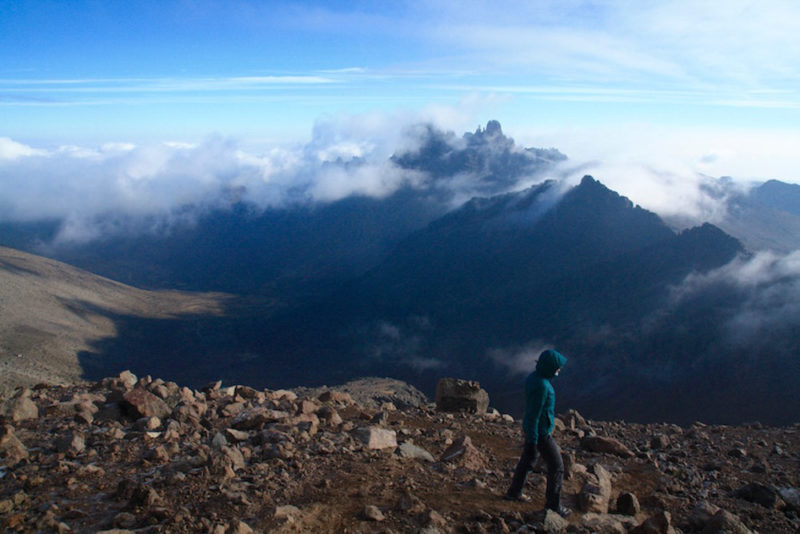
Content and photographs provided by Yana Kogan and Timon .
Disclaimer: This post may contain affiliate links. If you make a purchase or booking through one of our links we may earn a small commission (don’t worry, it’s at no extra cost to you).
How to Get to Mount Kenya
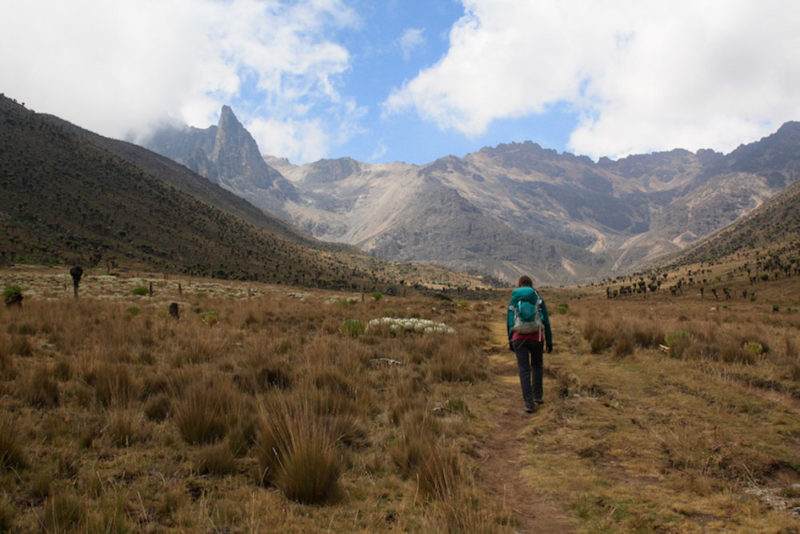
Mount Kenya is roughly three hours north of Nairobi. Either hire a private car or take the public matatu to Naro Moro/Nanyuki depending on your route. Nanyuki is a bigger town and will be easier to arrange everything if you’re going without a guide, but everything can be done from Naro Moru.
Nanyuki is the start of the popular Sirimon Route, while Naro Moru is the start of the Naro Moru route.
Where to Stay near Mount Kenya
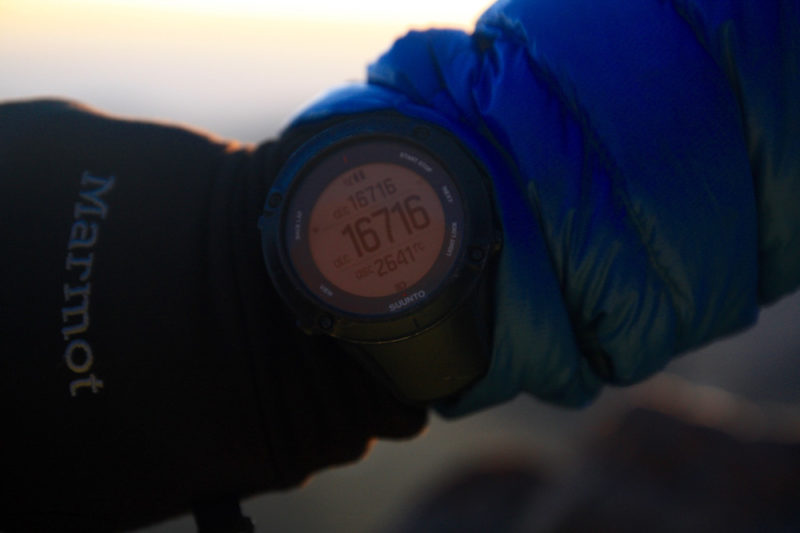
Depending on your route, stay in Nanyuki or Naro Moro prior to your hike. The Sirimon Route is close to Nanyuki, whereas the Naro Moro route is closer to the village in Naro Moro. Most budget hotels and campsites cannot be booked online ahead.
Hotels in the area are relatively basic but have a helpful staff and great service. If you plan on staying in Naro Moru, the Anka Resort is your best option. The resort features an outdoor swimming pool with a beautiful garden. Rooms come equipped with a flat-screen TV, a small refrigerator, a kettle, and all rooms have a private bathroom.
And if you’re staying in Nanyuki, Ngomongo is a great accommodation choice. It’s just 19 miles from Mount Kenya National Park and they’ll serve you a full English/Irish breakfast each morning!
Booking a Guide for Trekking Mount Kenya
While there likely are good companies that arrange hiking trips for Mount Kenya, it is also important to know the truth about booking guides. On several occasions, guides lied to us. We had a friend forced to skip a night at Old Moses Camp going up Sirimon and went straight to Shipton’s Camp at 13,800 feet, a dangerous move not allowing for proper acclimatization.
Some guides will require payment for a four-day hike, but then guide a three-day hike and pocket the extra money per person that they will charge. They may say backcountry camping is illegal, or it costs extra each night to camp. They often try to pocket as much money as possible when there is little truth to what is being told. Make sure you select a guide that you trust and one that takes safety seriously.
Climbing Mount Kenya Without a Guide
The only time it is a requirement to book a guide is when hiking Mount Kenya solo and the park allows only groups of two or more to hike unguided. This also applies to rock climbing at Mount Kenya. So, should you just skip the guide and porter and hit the trail? Before you do, be sure to take a few safety precautions.
This is a high-altitude hike. It is also one of the quickest hikes from the base of the mountain to get to alpine conditions, with glaciers, and above the elevation levels needed for proper acclimatization. This is not a hike to try to rush through as you’ll need to be properly acclimated.
It is important to make sure to have REALLY warm gear. It might be really warm in Nanyuki and Naro Moro before your hike, but up near the summit, the temperatures are consistently below negative throughout the year. Bringing the right gear is crucial.
Also, sections of the mountain are not properly marked, and it can be very hard to follow a trail while crossing screes or near the summit. Within minutes, all visibility could be lost due to weather, so having very good navigation skills is important.
How to Properly Acclimatize for a High Altitude Hike
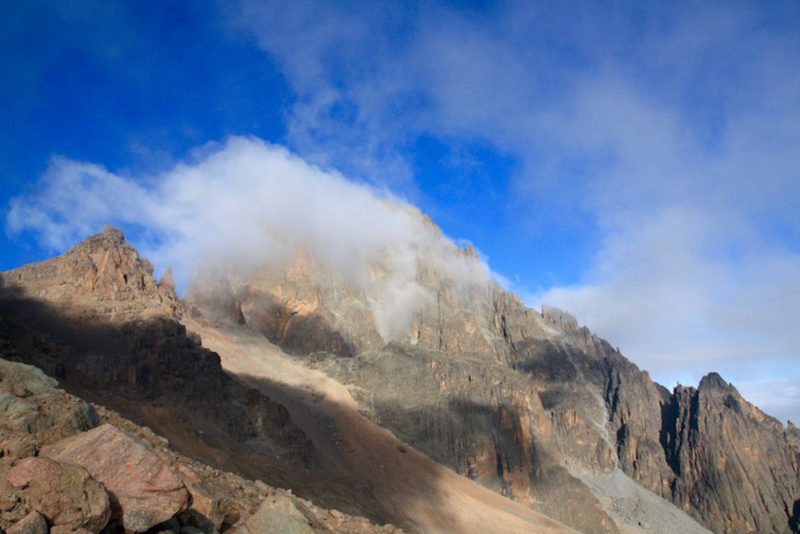
There are ways to prepare for a high-altitude hike, and these tips could make a difference in saving your or someone else’s life. The BEST way to pre-trip acclimatize is to stay for 48 hours in higher altitudes. Instead of rushing from Nairobi to Mount Kenya to start the hike the next day, it is much safer to spend two nights in Naro Moru or Nanyuki to start the acclimatization process.
Another great way to acclimatize is to hike up as much of the way as possible. This is much safer than driving up to 10,000 feet and starting the hike.
Altitude sicknesses, including Acute Mountain Sickness (AMS), High Altitude Pulmonary Edema (HAPE), and High Altitude Cerebral Edema (HACE) become real threats when climbing above 10,000 feet. The proper way to acclimatize is to only increase your sleeping altitude by 1,000 feet each night. For every 3,000 feet of elevations gained, a full rest day is a good idea. It is best to “climb high and sleep low” – you can climb more than 1,000 feet in a day, as long as you come back down to sleep at a lower altitude.
During the hike, it is crucial to stay hydrated, maintain enough nutrition, and avoid inhibitors, such as tobacco, alcohol, or depressant drugs (such as sleeping pills) which can all negatively affect the respiratory system while sleeping. Drink a LOT of water during the day and before sleep. Snack as much as possible throughout the day with high-energy, high-carb snacks.
If you experience any feelings of serious mountain sicknesses or even just strong headaches, the safest thing to do is to immediately go down. Even going down a few hundred feet could make a big impact.
How Much Does it Cost for a Mount Kenya Guide
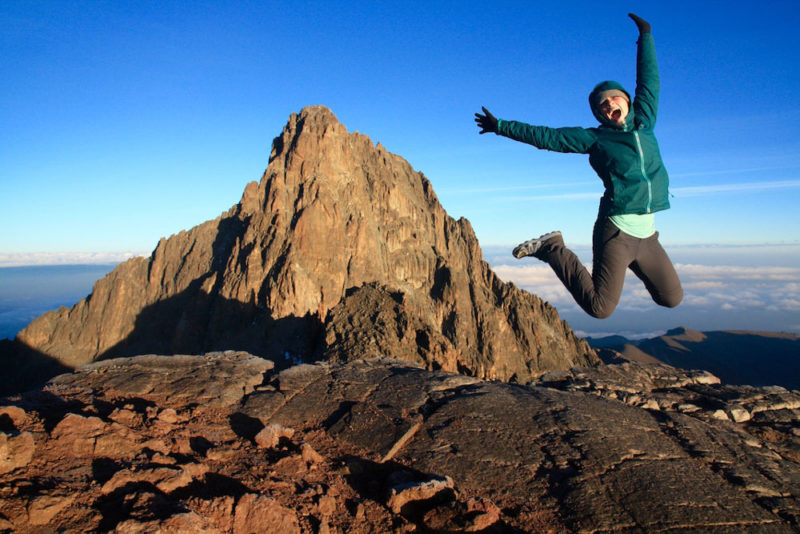
If choosing between guide services, try not to go through a middleman and book directly with the guide. We were quoted at the time a price of $130 USD per day per person for a four-day hike. That covered all park fees, guides, porter, cook, and accommodation. You can visit the Kenya Wildlife Service for updated prices, but our average breakdown of each cost (listed in USD) were as follows:
- Park Entry – $156 per person for a three-day pass OR $208 per person for a four-day pass depending on your route
- Guide – approximately $100 total
- Porter – $80 total
- Camping Fee – $20 one-time cost per person at park entry
- Camping is an extra 500 Ksh per night at hut OR you can camp free at the Ranger Stations
- Lodging costs if not camping – hut beds are $20 per bed per night
- Food – ranges from $30 to $60 per person when paying the guide to buy the food
- Transport – ranges from $30 to $60 for a private car on the Sirimon Route
How to Book a Mount Kenya Guide on a Budget
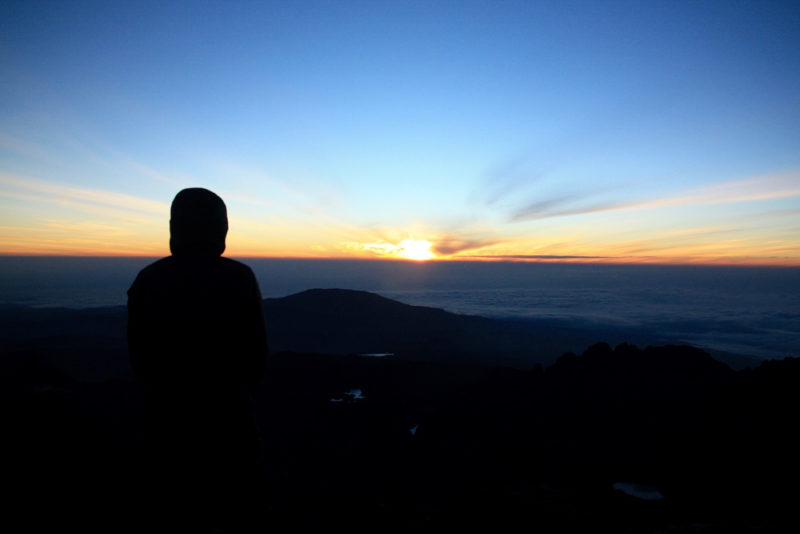
Most hikes up Mount Kenya are a three-night, four-day hike, but you’ll want to discuss the route and the itinerary for each day. Be clear on whether or not it is possible to meet the 24-hour threshold to make it a three-day hike, and if it is, only pay for the three-day permit. It is always possible to pay more at the park gate when leaving if it ends up being a longer hike than expected.
Hiring a guide should cost $80 to $100 USD for the trip, and your guide can carry and cook your food, which can eliminate the need for a porter and cook for solo hikers and small groups. Buy all the food yourself to cut costs significantly. Agree to camp at Ranger Stations, which are at no additional cost to the one-time $20 camping fee.
It is also possible to cut down costs of transport. For the Sirimon Route, hire a moto-taxi from Nanyuki at the beginning of the hike. On the Naro Moru Route, 2-3 miles from the park gate are Matatu’s, which go back and forth to Naro Moru for 70 shillings. By booking this trip the right way, it should get your costs down between $250 and $350 USD per person for the entire hike.
National Park Fees for Trekking Mount Kenya
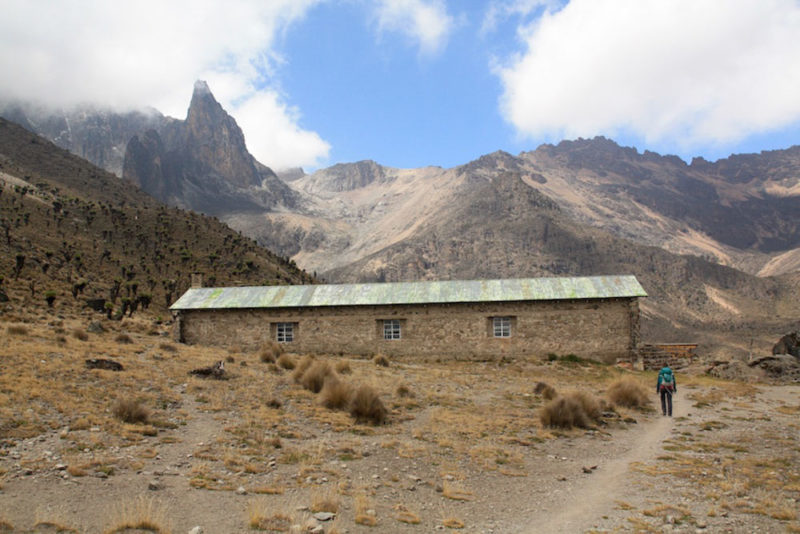
- Three-Day entry – $170 USD per person*
- Four-Day entry – $220 USD per person*
- There are also five and six-day permits for longer excursions
- Camping Fee – $20 per person for the entire stay
- Huts cost $20 per bed per night, paid directly at the hut to the park ranger
*Please note, these three or four-day entry prices are for 24 hour periods. If entering the park on a Monday at 1 PM, that means with a three-day permit, you can leave the park on Thursday by 1 PM.
Backcountry and Camping Options on the Mount Kenya Hike
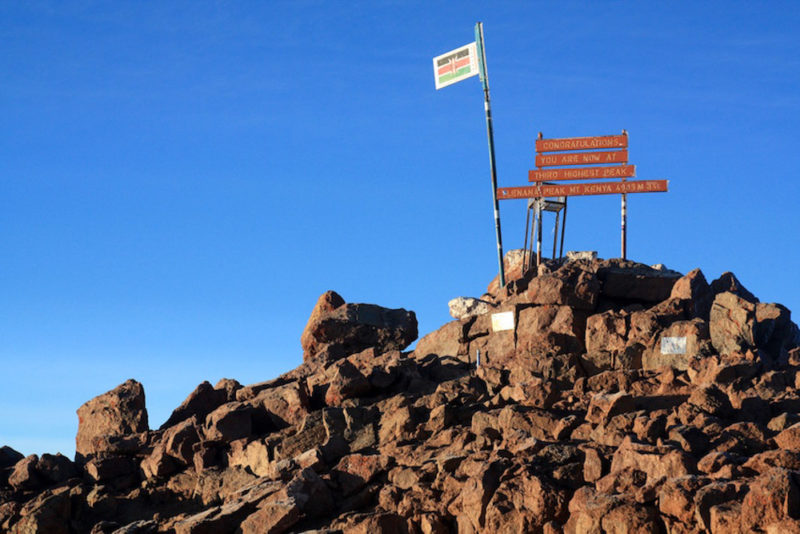
If you do not have your own camping gear, but want to camp, it is possible to rent gear in Nairobi, Naro Moru, or Nanyuki. Naro Moru has a small store called Mount Kenya Expeditions that rents gear or will get you in touch with someone who has all the gear needed. They are located on the street behind the Chieni Supermarket. Nanyuki has several options for rentals, just ask one of the many guides in town.
Camping costs an extra one-time $20 USD per person for the entire hike, which covers all “backcountry camping.” This means, camping anywhere on Mount Kenya, but not at one of the huts.
If you plan on camping at Met Station, McKinders, Old Moses Camp, or Shipton’s Camp, you’ll pay 5,000 shillings per night, but have access to their facilities and some shelter. The other option which we preferred, was to camp at the Ranger Stations for no additional cost.
Ranger stations have toilets and running water, and they’re extremely friendly and helpful if you need anything. Backcountry camping is permitted on Mount Kenya, just make sure to be near a water source.
Mount Kenya Hiking Routes
1. mount kenya naro moru route.
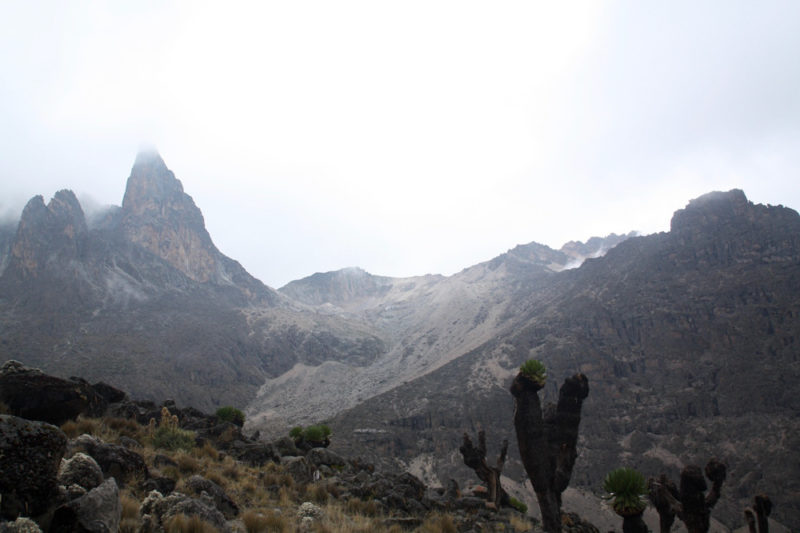
The Naro Moru Route is the shortest and most direct route up to Peak Lenana. This route was once one of the most popular but has taken a hit due to the construction of a new road from the park gate up to the highway.
While it may not be the most scenic hiking up on day one on this road, this hike is the cheapest option. It is more challenging than other routes as there is a steep section near the vertical bog and getting from McKinders up to Peak Lenana is extremely steep.
Start from Naro Moru to get to the park gate to start your hike. Camp at the Ranger Stations next to Met Station and McKinders for your nights on the mountain.
For full details on the Naro Moru route, this is the route we did, in conjunction with the summit circuit. Full trip details of our route are further below on this post!
2. Mount Kenya Sirimon Route
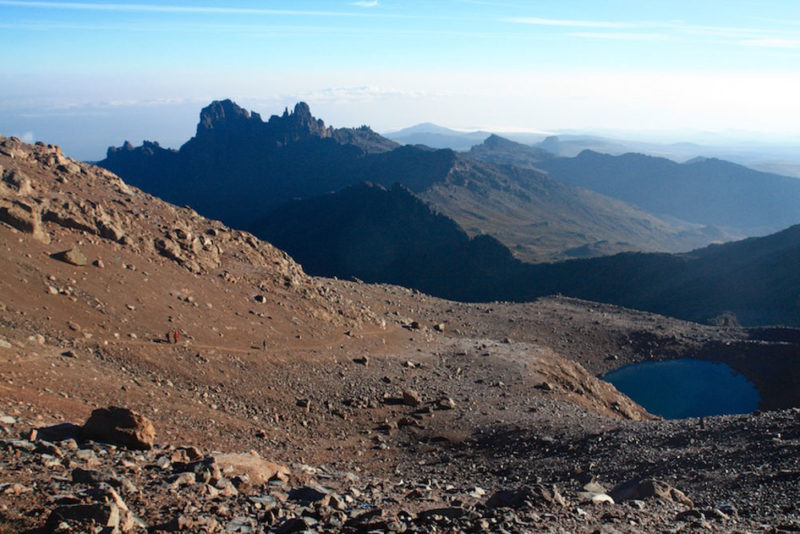
This very scenic route is more gradual and a little longer than Naro Moru. It takes you through a beautiful valley to the backside of Mount Kenya and offers the best views of the mountain. It is the best hike for those who are not as experienced with high-altitude mountains.
This hike originates from Nanyuki. Hire a taxi, moto-taxi, or private car from Nanyuki to the park gate to start the hike (and schedule a pick up when finished!). Camp at the Ranger Stations next to Old Moses camp and Shipton’s camp for your nights on the mountain.
3. Mount Kenya Chogoria Route
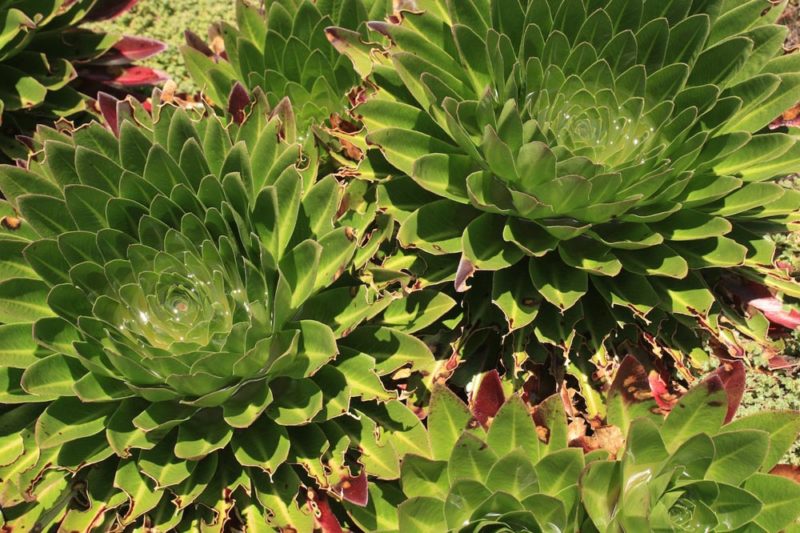
This route begins in Chogoria town and it is longer than the other common routes. The route begins 20 miles from the park gate and usually, a 4×4 car hire will be arranged. From the gate, you’ll walk through a forest filled with beautiful fauna and you’ll have the possibility of seeing elephants and leopards.
This hike is typically completed in 5 days and is considered by some the most scenic of all routes up Mount Kenya.
4. Mount Kenya Summit Circuit
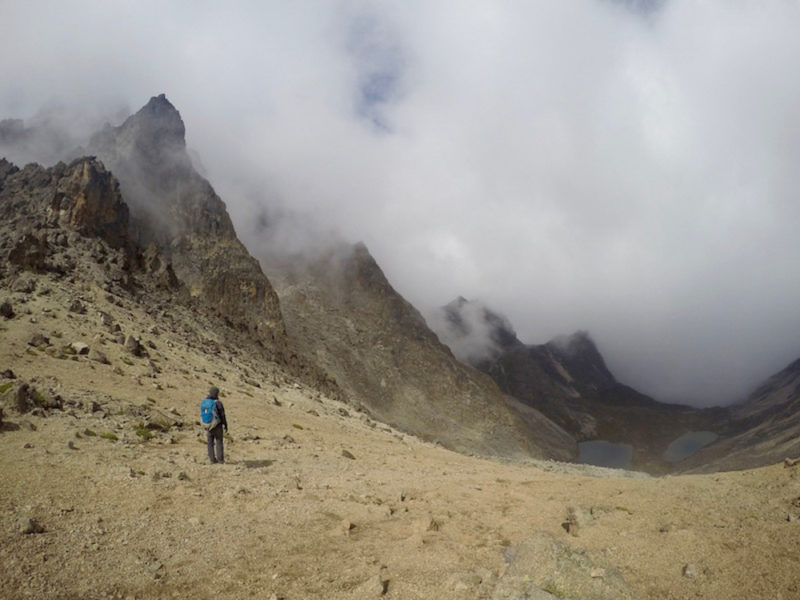
The summit circuit is the best way to see the full beauty of Mount Kenya, but absolutely should not be attempted unless you are an experienced hiker. The circuit begins at the summit of Peak Lenana and can go in either direction, but we suggest going back towards Shipton Camp on the Sirimon Route and circuit the mountain in that direction.
The circuit comes with some grueling ascents and descents all while hiking at the high altitude of 14,000 feet to 16,000 feet, encircling the peaks to make this a very long but amazing day hike.
Full details on the Naro Moru route in conjunction with the summit circuit are at the bottom of this post!
Hike Suggestions
- Best Beginner or Intermediate Hike – Sirimon Route
- Best Hike on a Budget (Intermediate to Advanced) – Naro Moru Route
- Top Overall Hike – Sirimon Route and the Summit Circuit
Our Hike: Mount Kenya Naro Moru Route & The Summit Circuit
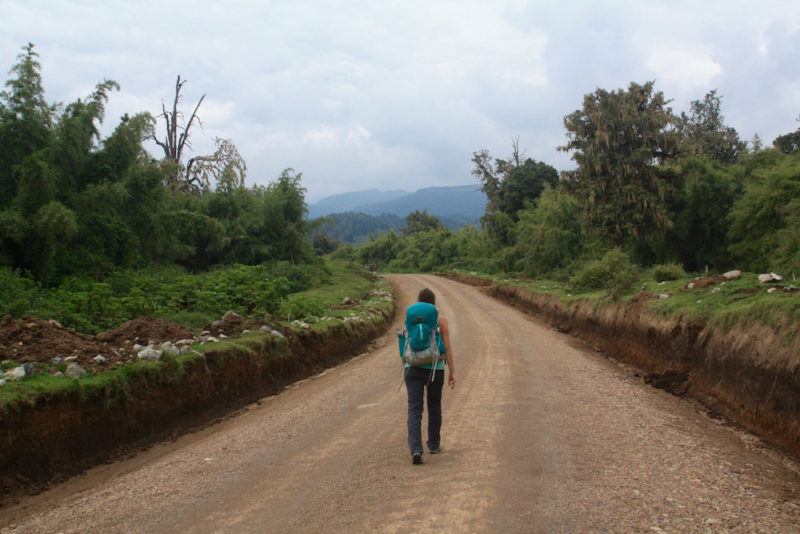
Day 1 – Mount Kenya Naro Moru Route
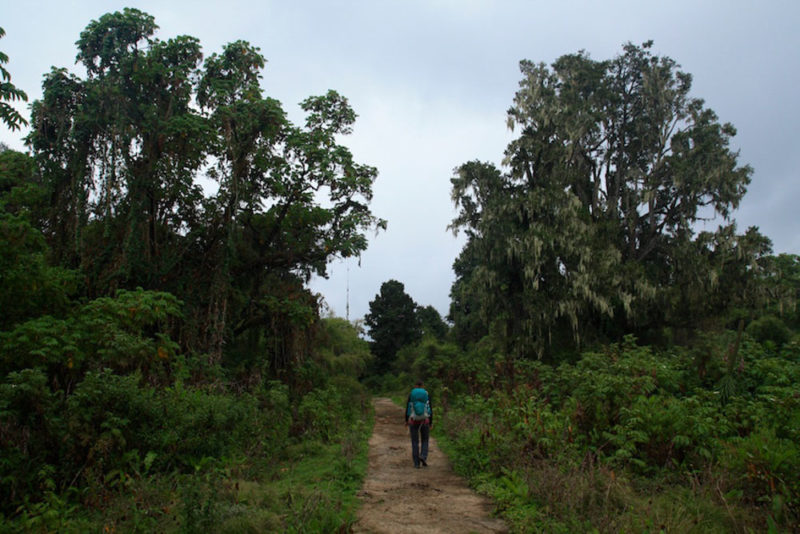
What used to be a very common route, Naro Moru is now less popular due to the construction of a road from the park gate up to Met Station. This route is the shortest, which can ensure a three-day hike.
Get a matatu from town to the end of the road, three miles from the park gate, and begin your hike from here. Hike on the road for three miles to the park gate, followed by six miles up to Met Station. Met Station is your stop for the first night, and at 10,000 feet, it is great for acclimatization. Camp at the ranger station across from Met Station for free.
Day 2 – Mount Kenya Naro Moru Route
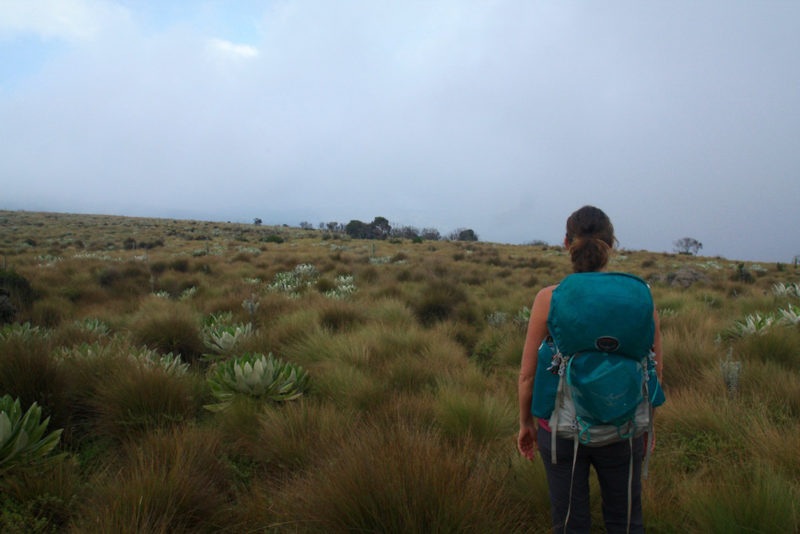
Start by hiking up from Met Station to McKinders, the high camp sitting at 14,200 feet. This is a big elevation gain, so take it slow! Ascend a steep path for the first mile before finally hitting a proper trail. Once on the trail, there is another half mile before reaching a well-known section to get lost in – the vertical bog.
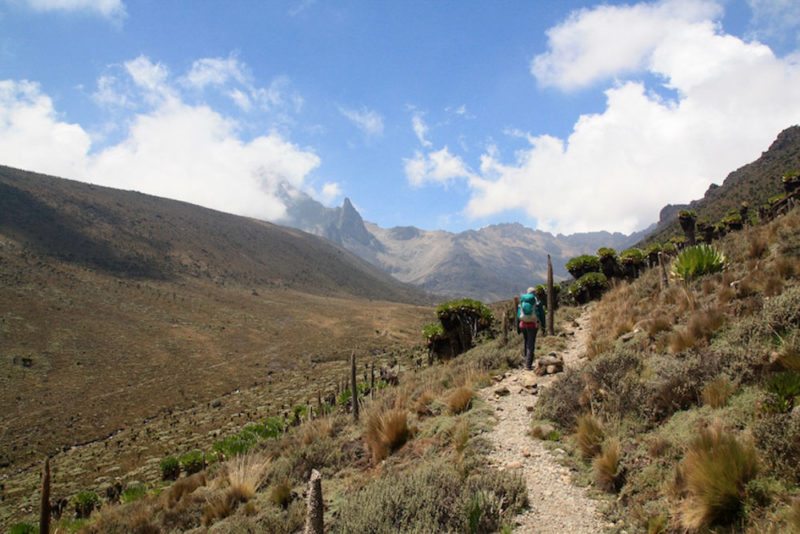
The vertical bog is a steep section that often has clouds rolling in and can be very damp and muddy. The ground is similar to that of a bog and sinks beneath your feet. There is a lot of erosion in this section, so be sure to look for the trail markers.
Climb straight up to not get lost. At the top of the bog, the trail flattens out some and it’s an easy hike the remainder of the way up to McKinders. If staying at the ranger station, continue your hike five-minutes past McKinders.
Day 3 – Mount Kenya Summit at Point Lenana
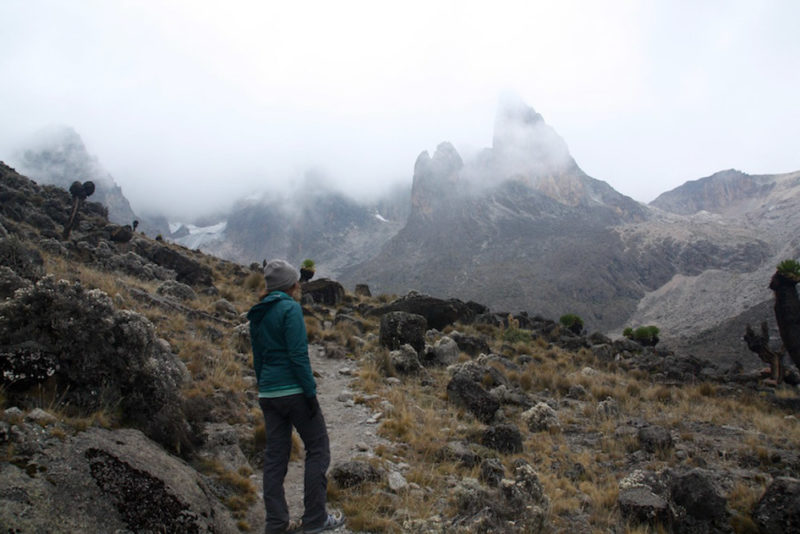
The final ascent up the hike follows with several options for your third day. Most who do this hike wake up and leave between 2 am and 3 am to climb up to Point Lenana for sunrise. This is no easy task and where a guide would come in handy.
The path to Lenana is right next to the ranger station, where you wrap around the valley beneath several large peaks and icebergs. When you reach a massive gravel section that is extremely steep, this is the path up. Ascend the scree, but note that it can be difficult to spot the zigzag trail up the mountain face.
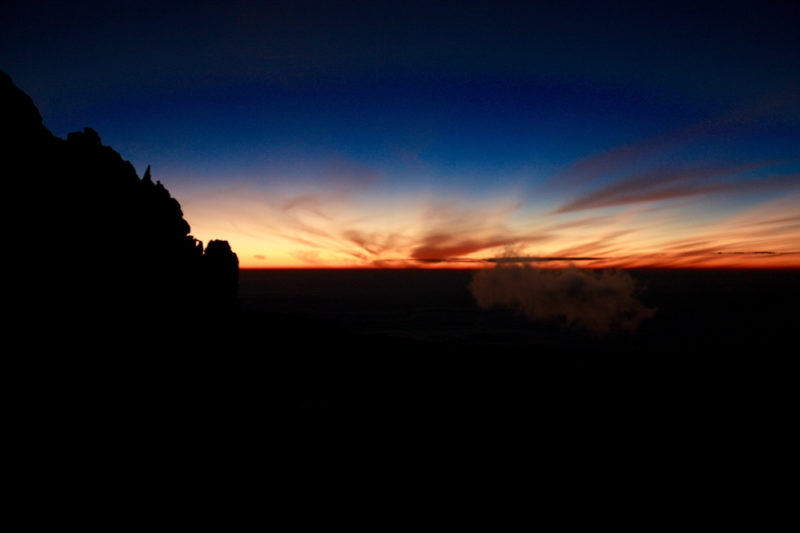
This is the hardest part of the entire hike, and the steepest section we encountered on Mount Kenya. Once reaching the top of the gravel section, continue to the first peak to get to Top Hut, which sits at the base of Point Lenana. From here, it is a 30-minute climb to the summit with the help of bolted chains, the highest via Ferrata in the world.
After sunset, there are a few options. You can come back down the same Naro Moru route and begin your descent down the mountain. Or you can descend down the Sirimon Route.
Your last option is to go on the Summit Circuit encircling the peaks, back to McKinders Hut for the night.
Day 3 – Continuation of the Summit Circuit
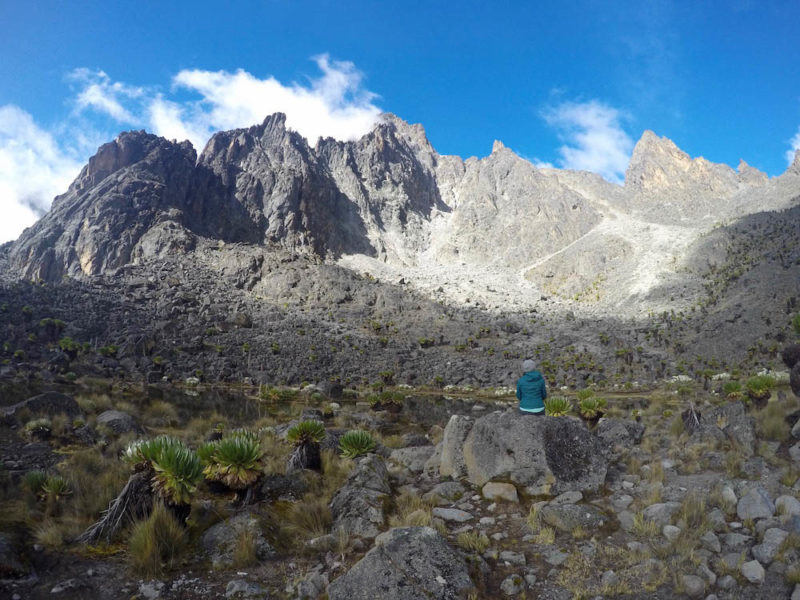
The summit circuit joined together with a sunrise summit up to Point Lenana is no easy task. It should only be done by expert hikers and will come with hours of continuous climbs and descents all between 14,000 and 16,000 feet elevation.
This ended up being a 10-hour hiking day, and we hike at a pretty fast pace. With that said, it will give the best views of Mount Kenya and an unforgettable experience on this beautiful mountain.
From Point Lenana, continue down the Sirimon Route. During the steep descent, Shipton’s Camp will be seen lower in the valley, so do not proceed here. Further up from Shipton’s Camp to your left, in the distance, there is a white shack (and possibly some tents) that used to be the location of Kami Hut. It now is just a small shack and a common camping area for mountain climbers.
Veer left off the path, and head directly to Kami Hut. There is a small path that straddles Batian. It is a gravel scree with a lot of rock boulders. Kami Hut has freshwater, so you can fill up on water here.
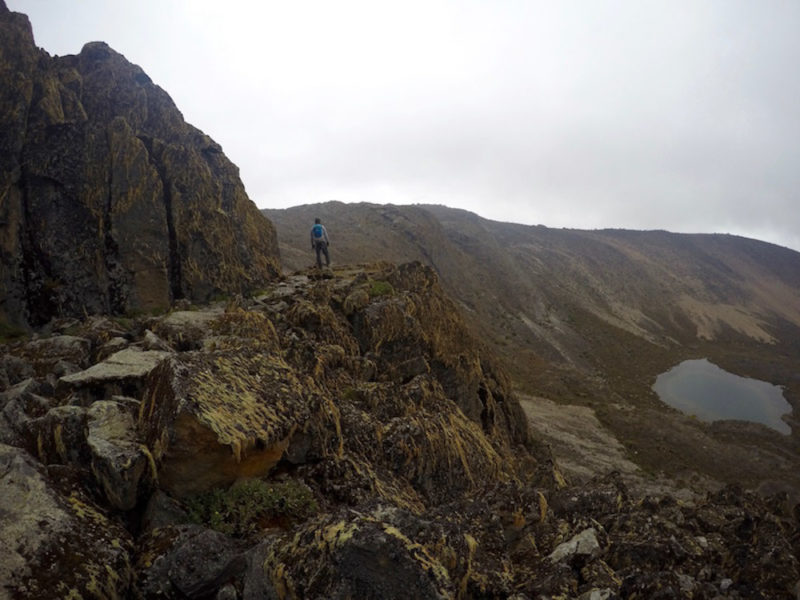
Just past Kami Hut is a steep incline on gravel rocks of light color similar to that of sand. Take this trail up to the ridgeline. From here, there are stunning views of Oblong Tarn a few hundred meters below.
Descend down to the tarn, where the trail follows the edge of the lake to the other side. At the other side of the tarn, there is a steep ascent up into the saddle. From here, the trail is very visible (if there are no clouds). The trail hugs the mountains to your left, with a small descent followed by a small ascent.
Once passed this section, the rock changes drastically to dark damp rocks covered in moss and algae, very different from the other side of the mountain. Continue hugging the mountain, where Emerald Tarn will be seen to the right several hundred meters below.
Continue on the path straddling the mountain, which will lead to the middle of Two Tarns. The path will pass the left side of the first tarn, and the right side of the second tarn. After the second tarn, the path splits.
Stay on the LEFT trail. This trail will eventually descend to McKinders Hut. You can cut out sometime by zigzagging your way immediately down by following the cairns to American Camp. From here, there is a flat trail that leads to the ranger station and McKinders Hut.
Day 4 – Mount Kenya Descent
We woke up early and from McKinders Hut descended our same route up Naro Moru back to the park gates. We went pretty fast to ensure we got there by 1 pm, so our three-day pass was valid within the 24-hour rule. It took us five hours to descend to the park gate. We took a short break here before another couple miles down to the road where the hike ended.
Overall, our hike up Mount Kenya was an amazing experience full of challenges and beautiful views.
That’s it! We hope you have a wonderful trek up to Mount Kenya!
Planning a trip to Kenya? Check out our favorite books and travel guides!
SHARE THIS ON PINTEREST
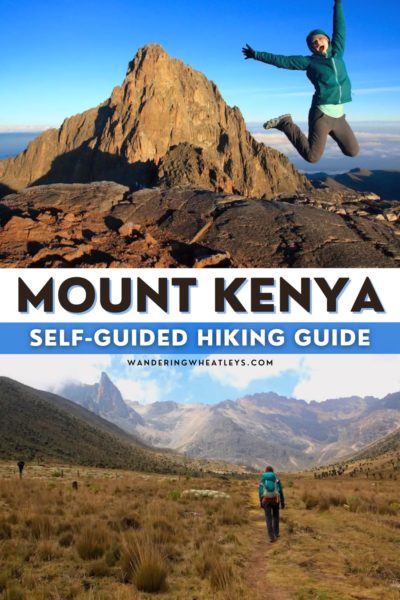
About the Author:
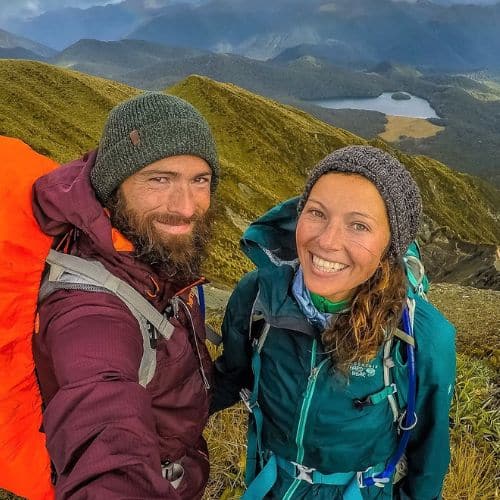
Yana & Timon met at college in Boston, Massachusetts. After graduating, they started their professional careers. They moved to San Francisco in 2010, a city they loved living in for nearly six years. After working and saving up money for several years, they quit their jobs and set off on an adventure of a lifetime. They started living a nomadic lifestyle in December 2015 and have not looked back since.
View all posts
Related Posts
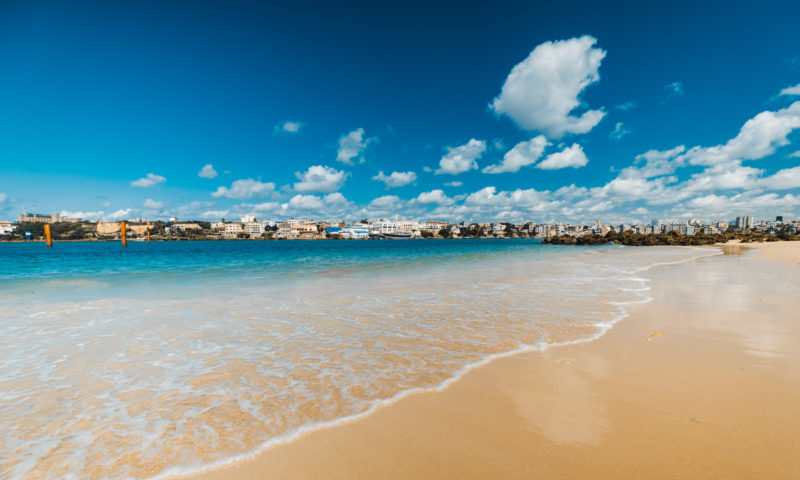
Guide to the Best of the Kenyan Coast
12 thoughts on “how to take a self-guided hike up mount kenya”.
Loved the article, my friend and I are hiking mt Kenya soon so I really appreciate you guys putting this together!
For the benefit of Mathew, and anyone else reading this post: the information in this article is no longer accurate, and hasn’t been since 2019. Kenya Wildlife Services (KWS) unfortunately no longer allow entry for visitors without an accredited guide.
Thanks, Jamesh- I was looking everywhere for this history, trying to figure out when the rule changed. Good to know it is a real ironclad rule now. Thanks!
As a follow up, we weren’t sure about going with a guide at first, but our guide Stephen did everything to make the trip comfortable and walking with him was like walking with a friend.
He’s on Whatsapp, +254 723 310635 – drop him a message when planning your trip and you will be in good hands 🙂
Note that as of June 2022, we (couple of 2, starting at Sirimon gate, exiting Chogoria) were not allowed to enter without a guide anymore. This was also stated as such on the Kenya Wildlife services website and on a notice sign at Chogoria gate.

Thanks for the update Tom!
Do you have a trekking guide book you’d recommend?
The beginning of the article suggests you were headed to the summit of mount kenya, but if I understood correctly you only summited Lenana, right?
Yesterday we (2 people) attempted to climb Mount Kenya towards Point Lenana via the Sirimon Route. It appears self-guided park access is no longer permitted, as both the park rangers and KWS office denied access. For those aiming to climb Mount Kenya it is no longer possible without a guide.
Read your guide and was very informative. I have just got back from mount Kenya and was a amazing trip we intended to go self guided and self supported but you do now require a guided to hike the mountain. But i would recommend having a guide to get the most out of the mountain.
Great article! These are really helpful. My partner andI climbed in January 2023. We used Sirimon + Chogoria route and had a great experience. We stayed at Mount Kenya Villas & Eco-camp and have nothing but great things to say. They had really good service ,tasteful rooms and a nice pool too. Janet (easily find her number on Google- Mt Kenya villas) at the Mt. Kenya Villas, recommended Sammy ,+254 727937453 as a guide(his WhatsApp number) and boy aren’t we glad. He took great care of my partner and I. Such a kind and patient man. Overall had a great experience in Kenya. Thank you for such a detailed article.
To echo everyone else here- a guide is now required. I live in Kenya and have tried several times (on various routes and using various negotiation tactics) to go unguided, always been denied- had to pick up a guide. It’s not as fun with a guide, but Mt. Kenya is still beautiful and worth it overall.
Leave a Comment Cancel Reply
Your email address will not be published. Required fields are marked *

IMAGES
COMMENTS
There are 8 main trekking routes on Mount Kenya, all of which summit the lowest peak, Point Lenana at 4,985 metres (16,355 ft). The majority of the 15,000 annual visitors to the mountain go on to summit the lower peak, but for those with technical climbing skills, the second peak Nelion and highest point Batian, are there for the taking too.
Welcome. At trekmountkenya.com, we seek to give you the best possible experience hiking or climbing Africa's second highest peak, Mount Kenya! (5199m or 17058 ft) Mount Kenya. Trekmountkenya.com is one of Kenya's most experienced trekking and climbing operations with specialization in trips up spectacular Mt Kenya.
The Mount Kenya trek is a challenging and enjoyable journey to Mount Kenya's highest trekking peak (Point Lenana) at 4985 metres. From the summit there is a beautiful view of the dramatic volcanic massif and the two main peaks of Batian and Nelion, as well as panoramic views over the central plains of Kenya. It has long been a popular and very ...
At 5,895 m (19,340 ft), Mount Kilimanjaro is the largest free-standing mountain in the world and the tallest in Africa. It's situated in Tanzania and attracts many climbers throughout the year. Mount Kenya, at 5,199 m (17,057 ft), follows Kilimanjaro closely as Africa's second tallest mountain.
Mt Kenya Trek Trip highlights. Climb Point Lenana (4985m), the highest trekking peak on Mt Kenya. Traverse Mount Kenya from East to West via the Chogoria and Sirimon routes. Ascend via the quieter and more dramatic Chogoria route. Delight in the beautiful alpine scenery and views. Search for wildlife in the lower slopes.
This Mount Kenya trek summits Point Lenana (4985m/16,354′), one of 3 peaks that make up Mount Kenya. It is the 2nd highest trekking peak in Africa (after Kilimanjaro) and is a UNESCO Biosphere Reserve due to its stunning landscape. Breathtaking views across the Kenyan Plains. Just 69 miles from the equator. Beautiful terrain, very few people.
Mount Kenya is 5,199m (17,057ft) high, making it Africa's second highest mountain behind only Kilimanjaro. Though Kili is higher, Mount Kenya is considered a more interesting climb - owing to the more demanding mountain faces, which provide challenging rock and even ice climbing routes. That's despite the proximity of the equator, which sits ...
Transfers. Park fees. Local guides, 360 guide, porters, cook team and vehicle. 3 nights hotel accommodation at start and finish of trek near Mount Kenya. All camping and group equipment. All meals as described in itinerary, including a celebratory dinner on final night at the traditional restaurant Carnivore. Discount at Cotswold Outdoor.
Climbing Mount Kenya: Is Africa's second-highest mountain at 5,199m (17,058 feet). Mount Kenya trekking is an enjoyable journey to Batian, Nelion and Point Lenana peaks. ... Personalized Treks & Climbs Your trip will be just yours - a private trek. You will not be joining a bigger group. So even if your group is just two people, you will be ...
Trip Highlight For 4 days Mount Kenya Trek. Day 1: Nairobi/Meteorological Station 3-4 hrs, 10km, 400m ascent. Day 2: Met Station/Mackinders Camp 5-6 hrs, 10km, 1200m ascent. Day 3: Mackinders Camp/Point Lenana/Met Station 8-10 hrs, 11km, 785m ascent. Day 4: Met Station/Naromoru/Nairobi 3hrs, 9km, 400m.
After Kilimanjaro, Mount Kenya in the eastern Great Rift Valley is the second highest mountain in Africa. Like Kili, it is an eroded stratovolcano with glaciers on its highest peaks, but unlike its higher sibling in Tanzania, only Point Lenana at 4985 meters (16355 feet) is accessible to trekkers as the lesser of the tri-peaks.
Mount Kenya trek. 5 day trip for £1,045.00. Trek to Point Lenana peak going up and down the Naro Moru and Sirimon routes on the North and West side of the mountain. Mount Kenya Traverse. 5 day trip for £1,145.00.
Compare 44 Mount Kenya climbing tours offered by 23 reputable companies. Find your perfect Kilimanjaro climbing package within minutes. Best price guarantee! Menu. Safaris & Tours. Botswana (390) ... 2-Day Mt Kenya Trek and Ol Pejeta - Home of Chimpanzees. $715 pp (USD)
Mount Kenya is on the Equator, 4 hours drive north of Nairobi. On Africa's second highest mountain, you can experience a high altitude walking trip amongst rugged peaks and glaciers, without the crowds. If you are fit and active and want to challenge yourself to a high peak, you can trek to the third highest point, Point Lenana, which at ...
Wilderness specializes in unbeaten paths in Kenya, such as Lake Turkana, Lake Baringo, Samburu, Mount Kenya, and the entire Northern Kenya region. Renowned for the comfort provided to clients climbing Mount Kenya, we are recognized as one of Kenya's premier mountaineering companies. ... Mount Kenya Trek Itinerary Day 1: Nairobi - Mt Kenya ...
Sirimon Route - 4 day Mt Kenya Trekking Tour. Get to Point Lenana at 4895m and back in only four days. On the Sirimon Route, you enjoy beautiful landscapes hiking the picturesque Mackinder's Valley and impressive mountain views at Shipton's Camp. After summit, you descend along the Chogoria Route. Read more.
As there is different trekking routes on Mount Kenya, there are different options and prices as well. You can climb Mt Kenya in as little as 4 days but you can also do a traverse and spend 6 days on the mountain. 4 to 5 days on the mountain, regardless of which route you choose can cost between 600 and 700 EUR or 700 and 800 USD.
MT Kenya Trek. Mt Kenya has many sides offering both the climber and the trekker plenty of routes and options to gain the summits. Point Lenana is the mountains trekking summit. A wonderful journey to its lofty 4995 meter summit. A walk through the lush forests to the moorland and on into the Alpine terrain on the high summits.
Sirimon - Naro Moru Route Trek Mt Kenya. Leave Nairobi at 8 am to Nanyuki town for lunch, taking about 4 hours. Proceed to Mount Kenya National Park's Sirimon Gate, 1 hr, 2440m. From Sirimon Gate follow the track as it winds uphill though the forest which becomes heath land after about 3 hrs. About 3½ hours from the gate the track veers right ...
Day 2: Fly to Chigoria & Begin Mt. Kenya Trek Mount Kenya. Mt. Kenya is a broad, largely symmetrical volcanic cone with a diameter of about 74 miles (120 km). Of the main peaks on the mountain, Batian is 17,057 feet (5199 m) and Nelion is 17,021 feet (5188 m), but these two are only accessible to technical mountaineers.Lenana, 16,354 feet (4985 m.), is accessible to trekkers.
Day 7: Nairobi- Mt Kenya Bandas Day 8: Mt Kenya Bandas - Lake Ellis Campsite Day 9: Lake Ellis - Minto`s Camp. Day 10: Minto`s - Pt Lenana ( 4,985m)- Liki North camp. Day 11: Liki North camp - Nairobi Day 12. Transfer to Rwenzori Mountains National Park. Day 13. Nyakalengija (1600m) to John matte hut (3420m) Day14. John matte to Elena hut ...
A reasonable degree of fitness helps, and it's wise to allow time for altitude and acclimatization. 2. Mt Kenya-Met Station. Best one-day hike. 20km (12.5 miles) round trip, 7 hours, moderate. Instead of spending days trekking up Mt Kenya, you can hike to the Met Station campsite at 3050m (10,000ft) altitude.
Mount Kenya is the second tallest mountain in Africa behind Kilimanjaro. As one of the main attractions, this volcanic mountain stands at 5,199 meters (17,057 feet), and it is a haven to hike up Mount Kenya for experienced trekkers and mountain climbers. Most national parks in Kenya and in neighboring Tanzania are very expensive, but the national